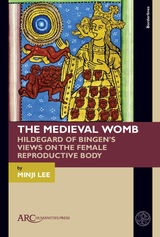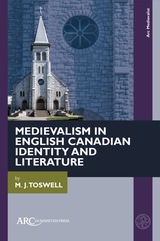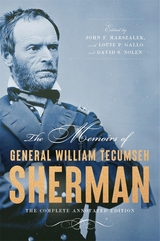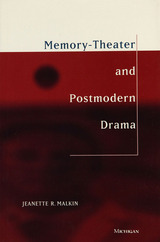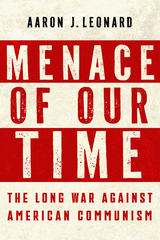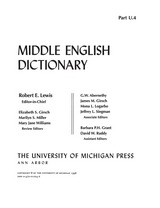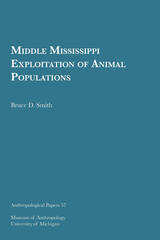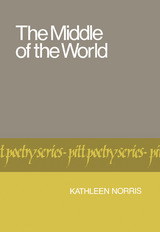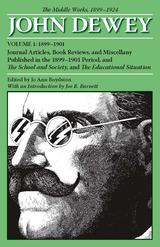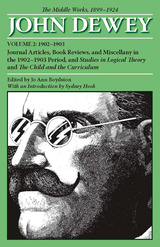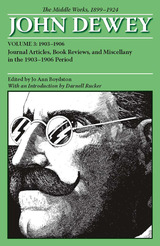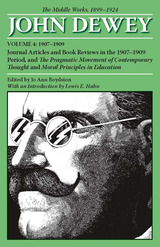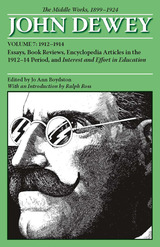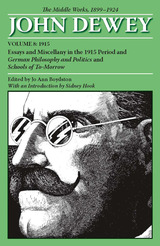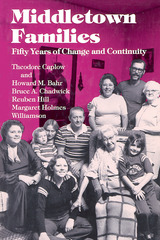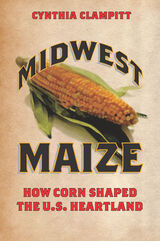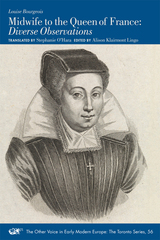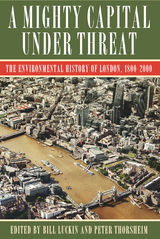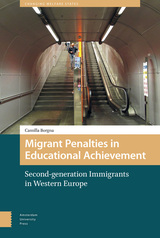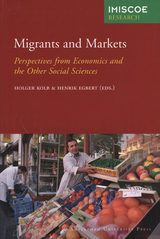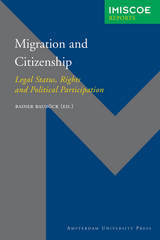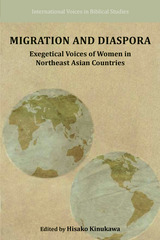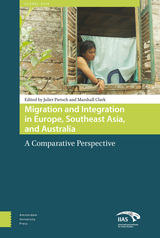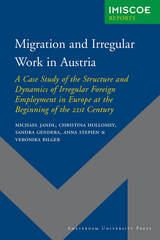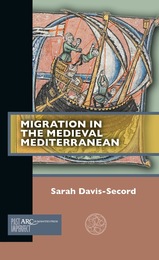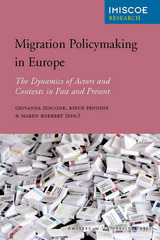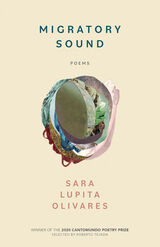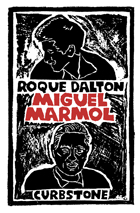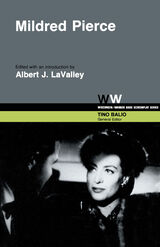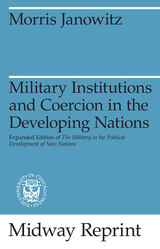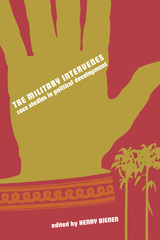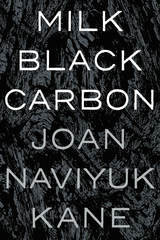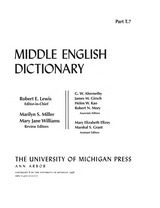 Middle English Dictionary: T.7
Robert E. Lewis, Editor-in-Chief
University of Michigan Press, 1996 The goal of the Middle English Dictionary is to include all meanings, grammatical forms, and spellings of all the words identified by its extensive reading program. When completed, it will represent what has been called the greatest achievement in medieval scholarship in America and the most important single project in English historical lexicography being carried out anywhere today. After sixty-five years it will have produced about 15,000 pages.
The Middle English Dictionary is a monumental scholarly endeavor that began more than fifty years ago and is expected to be completed in the late-1990s. The task of the editors compiling the dictionary is to document the English language from just after the Norman Conquest up to the introduction of the printing press at the end of the 1400s. With that innovation the language became more or less standardized, but during the Middle Ages the language was evolving under the stress of events and social change, particularly as French culture was absorbed into the language. These were truly the formative years of the English language, and they present major challenges to lexicographers.
Published volumes include all fascicles from A.1 through T.10, plus the Plan and Bibliography.
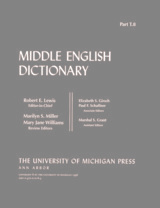 Middle English Dictionary: T.8
Robert E. Lewis, Editor-in-Chief
University of Michigan Press, 1996 The goal of the Middle English Dictionary is to include all meanings, grammatical forms, and spellings of all the words identified by its extensive reading program. When completed, it will represent what has been called the greatest achievement in medieval scholarship in America and the most important single project in English historical lexicography being carried out anywhere today. After sixty-five years it will have produced about 15,000 pages.
The Middle English Dictionary is a monumental scholarly endeavor that began more than fifty years ago and is expected to be completed in the late-1990s. The task of the editors compiling the dictionary is to document the English language from just after the Norman Conquest up to the introduction of the printing press at the end of the 1400s. With that innovation the language became more or less standardized, but during the Middle Ages the language was evolving under the stress of events and social change, particularly as French culture was absorbed into the language. These were truly the formative years of the English language, and they present major challenges to lexicographers.
Published volumes include all fascicles from A.1 through T.10, plus the Plan and Bibliography.
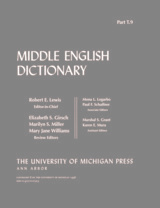 Middle English Dictionary: T.9
Robert E. Lewis, Editor-in-Chief
University of Michigan Press, 1997 The goal of the Middle English Dictionary is to include all meanings, grammatical forms, and spellings of all the words identified by its extensive reading program. When completed, it will represent what has been called the greatest achievement in medieval scholarship in America and the most important single project in English historical lexicography being carried out anywhere today. After sixty-five years it will have produced about 15,000 pages.
The Middle English Dictionary is a monumental scholarly endeavor that began more than fifty years ago and is expected to be completed in the late-1990s. The task of the editors compiling the dictionary is to document the English language from just after the Norman Conquest up to the introduction of the printing press at the end of the 1400s. With that innovation the language became more or less standardized, but during the Middle Ages the language was evolving under the stress of events and social change, particularly as French culture was absorbed into the language. These were truly the formative years of the English language, and they present major challenges to lexicographers.
Published volumes include all fascicles from A.1 through T.10, plus the Plan and Bibliography.
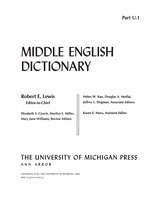 Middle English Dictionary: U.1
Robert E. Lewis, Editor-in-Chief
University of Michigan Press, 1997 The goal of the Middle English Dictionary is to include all meanings, grammatical forms, and spellings of all the words identified by its extensive reading program. When completed, it will represent what has been called the greatest achievement in medieval scholarship in America and the most important single project in English historical lexicography being carried out anywhere today. After sixty-five years it will have produced about 15,000 pages.
The Middle English Dictionary is a monumental scholarly endeavor that began more than fifty years ago and is expected to be completed in 2001. The task of the editors compiling the dictionary is to document the English language from just after the Norman Conquest up to the introduction of the printing press at the end of the 1400s. With that innovation the language became more or less standardized, but during the Middle Ages the language was evolving under the stress of events and social change, particularly as French culture was absorbed into the language. These were truly the formative years of the English language, and they present major challenges to lexicographers.
Fascicles U.1, U.2, and U.3 are the most recent additions to this ongoing undertaking. Published volumes include all fascicles from A.1 through U.3, plus the Plan and Bibliography.
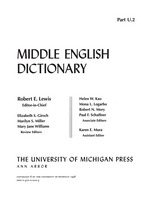 Middle English Dictionary: U.2
Robert E. Lewis, Editor-in-Chief
University of Michigan Press, 1998 The goal of the Middle English Dictionary is to include all meanings, grammatical forms, and spellings of all the words identified by its extensive reading program. When completed, it will represent what has been called the greatest achievement in medieval scholarship in America and the most important single project in English historical lexicography being carried out anywhere today. After sixty-five years it will have produced about 15,000 pages.
The Middle English Dictionary is a monumental scholarly endeavor that began more than fifty years ago and is expected to be completed in 2001. The task of the editors compiling the dictionary is to document the English language from just after the Norman Conquest up to the introduction of the printing press at the end of the 1400s. With that innovation the language became more or less standardized, but during the Middle Ages the language was evolving under the stress of events and social change, particularly as French culture was absorbed into the language. These were truly the formative years of the English language, and they present major challenges to lexicographers.
Fascicles U.1, U.2, and U.3 are the most recent additions to this ongoing undertaking. Published volumes include all fascicles from A.1 through U.3, plus the Plan and Bibliography.
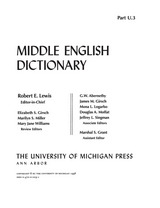 Middle English Dictionary: U.3
Robert E. Lewis, Editor-in-Chief
University of Michigan Press, 1998 The goal of the Middle English Dictionary is to include all meanings, grammatical forms, and spellings of all the words identified by its extensive reading program. When completed, it will represent what has been called the greatest achievement in medieval scholarship in America and the most important single project in English historical lexicography being carried out anywhere today. After sixty-five years it will have produced about 15,000 pages.
The Middle English Dictionary is a monumental scholarly endeavor that began more than fifty years ago and is expected to be completed in 2001. The task of the editors compiling the dictionary is to document the English language from just after the Norman Conquest up to the introduction of the printing press at the end of the 1400s. With that innovation the language became more or less standardized, but during the Middle Ages the language was evolving under the stress of events and social change, particularly as French culture was absorbed into the language. These were truly the formative years of the English language, and they present major challenges to lexicographers.
Fascicles U.1, U.2, and U.3 are the most recent additions to this ongoing undertaking. Published volumes include all fascicles from A.1 through U.3, plus the Plan and Bibliography.
Middle English Dictionary: U.4
Robert E. Lewis, Editor-in-Chief
University of Michigan Press, 1998 The most important modern reference work for Middle English studies
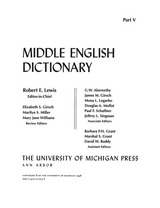 Middle English Dictionary: V
Robert E. Lewis, Editor-in-Chief
University of Michigan Press, 1999 The goal of the Middle English Dictionary is to include all meanings, grammatical forms, and spellings of all the words identified by its extensive reading program. When completed, it will represent what has been called the greatest achievement in medieval scholarship in America and the most important single project in English historical lexicography being carried out anywhere today. After sixty-five years, it will have produced about 15,000 pages.
The Middle English Dictionary, a monumental scholarly endeavor that began more than fifty years ago, is scheduled to be completed in 2001. The task of the editors compiling the dictionary is to document the English language from just after the Norman Conquest to the introduction of the printing press at the end of the 1400s. With that innovation the language became more or less standardized, but during the Middle Ages the language was evolving under the stress of events and social change, particularly as French culture was absorbed into the language. These were truly the formative years of the English language, and they present major challenges to lexicographers.
Fascicles V.1, W.1, and W.2 are the most recent additions to this ongoing undertaking. Published volumes include all fascicles from A.1 through U.3, plus the Plan and Bibliography.
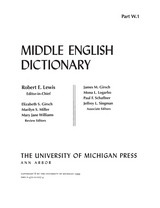 Middle English Dictionary: W.1
Robert E. Lewis, Editor-in-Chief
University of Michigan Press, 1999 The goal of the Middle English Dictionary is to include all meanings, grammatical forms, and spellings of all the words identified by its extensive reading program. When completed, it will represent what has been called the greatest achievement in medieval scholarship in America and the most important single project in English historical lexicography being carried out anywhere today. After sixty-five years, it will have produced about 15,000 pages.
The Middle English Dictionary, a monumental scholarly endeavor that began more than fifty years ago, is scheduled to be completed in 2001. The task of the editors compiling the dictionary is to document the English language from just after the Norman Conquest to the introduction of the printing press at the end of the 1400s. With that innovation the language became more or less standardized, but during the Middle Ages the language was evolving under the stress of events and social change, particularly as French culture was absorbed into the language. These were truly the formative years of the English language, and they present major challenges to lexicographers.
Fascicles V.1, W.1, and W.2 are the most recent additions to this ongoing undertaking. Published volumes include all fascicles from A.1 through U.3, plus the Plan and Bibliography.
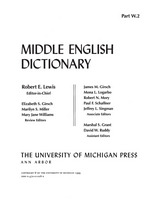 Middle English Dictionary: W.2
Robert E. Lewis, Editor-in-Chief
University of Michigan Press, 1999 The goal of the Middle English Dictionary is to include all meanings, grammatical forms, and spellings of all the words identified by its extensive reading program. When completed, it will represent what has been called the greatest achievement in medieval scholarship in America and the most important single project in English historical lexicography being carried out anywhere today. After sixty-five years, it will have produced about 15,000 pages.
The Middle English Dictionary, a monumental scholarly endeavor that began more than fifty years ago, is scheduled to be completed in 2001. The task of the editors compiling the dictionary is to document the English language from just after the Norman Conquest to the introduction of the printing press at the end of the 1400s. With that innovation the language became more or less standardized, but during the Middle Ages the language was evolving under the stress of events and social change, particularly as French culture was absorbed into the language. These were truly the formative years of the English language, and they present major challenges to lexicographers.
Fascicles V.1, W.1, and W.2 are the most recent additions to this ongoing undertaking. Published volumes include all fascicles from A.1 through U.3, plus the Plan and Bibliography.
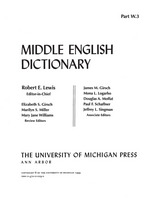 Middle English Dictionary: W.3
Robert E. Lewis, Editor-in-Chief
University of Michigan Press, 2000 The goal of the Middle English Dictionary is to include all meanings, grammatical forms, and spellings of all the words identified by its extensive reading program. When completed, it will represent what has been called the greatest achievement in medieval scholarship in America and the most important single project in English historical lexicography being carried out anywhere today. After sixty-five years it will have produced about 15,000 pages.
TheMiddle English Dictionary, a monumental scholarly endeavor that began more than fifty years ago, is completed with the publication of these remaining fascicles. The task of the editors compiling the dictionary is to document theE nglish language from just after the Norman Conquest up to the introduction of the printing press at the end of the 1400s. With that innovation the language became more or less standardized, but during the Middle Ages the language was evolving under the stress of events and social change, particularly as French culture was absorbed into the language. These were truly the formative years of the English language, and they present major challenges to lexicographers.
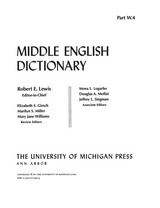 Middle English Dictionary: W.4
Robert E. Lewis, Editor-in-Chief
University of Michigan Press, 2000 The goal of the Middle English Dictionary is to include all meanings, grammatical forms, and spellings of all the words identified by its extensive reading program. When completed, it will represent what has been called the greatest achievement in medieval scholarship in America and the most important single project in English historical lexicography being carried out anywhere today. After sixty-five years it will have produced about 15,000 pages.
TheMiddle English Dictionary, a monumental scholarly endeavor that began more than fifty years ago, is completed with the publication of these remaining fascicles. The task of the editors compiling the dictionary is to document the English language from just after the Norman Conquest up to the introduction of the printing press at the end of the 1400s. With that innovation the language became more or less standardized, but during the Middle Ages the language was evolving under the stress of events and social change, particularly as French culture was absorbed into the language. These were truly the formative years of the English language, and they present major challenges to lexicographers.
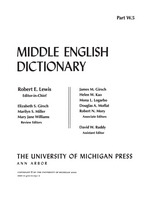 Middle English Dictionary: W.5
Robert E. Lewis, Editor-in-Chief
University of Michigan Press, 2000 The goal of the Middle English Dictionary is to include all meanings, grammatical forms, and spellings of all the words identified by its extensive reading program. When completed, it will represent what has been called the greatest achievement in medieval scholarship in America and the most important single project in English historical lexicography being carried out anywhere today. After sixty-five years it will have produced about 15,000 pages.
TheMiddle English Dictionary, a monumental scholarly endeavor that began more than fifty years ago, is completed with the publication of these remaining fascicles. The task of the editors compiling the dictionary is to document theE nglish language from just after the Norman Conquest up to the introduction of the printing press at the end of the 1400s. With that innovation the language became more or less standardized, but during the Middle Ages the language was evolving under the stress of events and social change, particularly as French culture was absorbed into the language. These were truly the formative years of the English language, and they present major challenges to lexicographers.
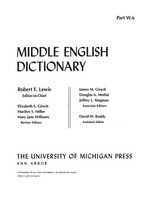 Middle English Dictionary: W.6
Robert E. Lewis, Editor-in-Chief
University of Michigan Press, 2000 The goal of the Middle English Dictionary is to include all meanings, grammatical forms, and spellings of all the words identified by its extensive reading program. When completed, it will represent what has been called the greatest achievement in medieval scholarship in America and the most important single project in English historical lexicography being carried out anywhere today. After sixty-five years it will have produced about 15,000 pages.
TheMiddle English Dictionary, a monumental scholarly endeavor that began more than fifty years ago, is completed with the publication of these remaining fascicles. The task of the editors compiling the dictionary is to document theE nglish language from just after the Norman Conquest up to the introduction of the printing press at the end of the 1400s. With that innovation the language became more or less standardized, but during the Middle Ages the language was evolving under the stress of events and social change, particularly as French culture was absorbed into the language. These were truly the formative years of the English language, and they present major challenges to lexicographers.
Fascicle X/Y/Z is the final addition to this incredible undertaking. Published volumes include all fascicles from A.1 through X/Y/Z, plus the Plan and Bibliography.
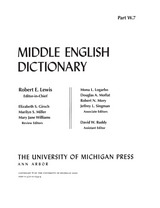 Middle English Dictionary: W.7
Robert E. Lewis, Editor-in-Chief
University of Michigan Press, 2001 The goal of the Middle English Dictionary is to include all meanings, grammatical forms, and spellings of all the words identified by its extensive reading program. When completed, it will represent what has been called the greatest achievement in medieval scholarship in America and the most important single project in English historical lexicography being carried out anywhere today. After sixty-five years it will have produced about 15,000 pages.
TheMiddle English Dictionary, a monumental scholarly endeavor that began more than fifty years ago, is completed with the publication of these remaining fascicles. The task of the editors compiling the dictionary is to document theE nglish language from just after the Norman Conquest up to the introduction of the printing press at the end of the 1400s. With that innovation the language became more or less standardized, but during the Middle Ages the language was evolving under the stress of events and social change, particularly as French culture was absorbed into the language. These were truly the formative years of the English language, and they present major challenges to lexicographers.
Fascicle X/Y/Z is the final addition to this incredible undertaking. Published volumes include all fascicles from A.1 through X/Y/Z, plus the Plan and Bibliography.
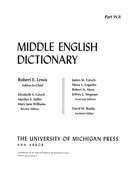 Middle English Dictionary: W.8
Robert E. Lewis, Editor-in-Chief
University of Michigan Press, 2001 The goal of the Middle English Dictionary is to include all meanings, grammatical forms, and spellings of all the words identified by its extensive reading program. When completed, it will represent what has been called the greatest achievement in medieval scholarship in America and the most important single project in English historical lexicography being carried out anywhere today. After sixty-five years it will have produced about 15,000 pages.
TheMiddle English Dictionary, a monumental scholarly endeavor that began more than fifty years ago, is completed with the publication of these remaining fascicles. The task of the editors compiling the dictionary is to document theE nglish language from just after the Norman Conquest up to the introduction of the printing press at the end of the 1400s. With that innovation the language became more or less standardized, but during the Middle Ages the language was evolving under the stress of events and social change, particularly as French culture was absorbed into the language. These were truly the formative years of the English language, and they present major challenges to lexicographers.
Fascicle X/Y/Z is the final addition to this incredible undertaking. Published volumes include all fascicles from A.1 through X/Y/Z, plus the Plan and Bibliography.
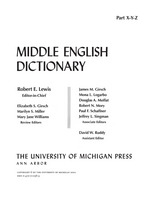 Middle English Dictionary: X/Y/Z
Robert E. Lewis, Editor-in-Chief
University of Michigan Press, 2001 The goal of the Middle English Dictionary is to include all meanings, grammatical forms, and spellings of all the words identified by its extensive reading program. When completed, it will represent what has been called the greatest achievement in medieval scholarship in America and the most important single project in English historical lexicography being carried out anywhere today. After sixty-five years it will have produced about 15,000 pages.
TheMiddle English Dictionary, a monumental scholarly endeavor that began more than fifty years ago, is completed with the publication of these remaining fascicles. The task of the editors compiling the dictionary is to document theE nglish language from just after the Norman Conquest up to the introduction of the printing press at the end of the 1400s. With that innovation the language became more or less standardized, but during the Middle Ages the language was evolving under the stress of events and social change, particularly as French culture was absorbed into the language. These were truly the formative years of the English language, and they present major challenges to lexicographers.
Fascicles W.9 and X/Y/Z will be the final additions to this incredible undertaking. Published volumes include all fascicles from A.1 through W.8, plus the Plan and Bibliography.
Middle English Prose: A Critical Guide to Major Authors and Genres
EDWARDS, ANTHONY
Rutgers University Press, 1984 The purpose of this book is to provide an authoritative guide to a number of important authors and genres of Middle English prose. Although, distinguished work has been undertaken on particular authors or groups of works, no previous study has attempted a comprehensive overview of this highly diversified range of material.
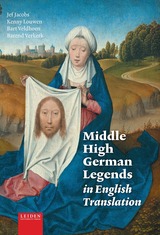 Middle High German Legends in English Translation
Edited by Jef Jacobs, Kenny Louwen, Bart Veldhoen, and Barend Verkerk
Leiden University Press, 2021 "This book contains five legends from the German Middle Ages, presented in the Middle High German source language, with a modern English translation. These include the narratives of Veronica, Vespasian, Theophilus, Mary Magdalene and the miraculous history of the True Cross. This outstanding and timely translation of these Middle High German texts will make them more accessible to an English speaking academic community. The introduction provides an overview of Germanic legend research, discusses the main principal themes in medieval German legends and provides summary introductions to each of the texts. The translations are easy to read and successful at finding the balance between faithfulness to original and providing the readership with a serviceable text. Through this book, beginners as well as advanced students should be able to gain knowledge in various fields: linguistic in mastering Middle High German and translation skills, literary-historical in acquiring and broadening knowledge of a literary genre that is typical for the Middle Ages and medieval literature. The book is also aimed at students and scholars who are not proficient in Middle High German. The English translation will give them access to this important field. "
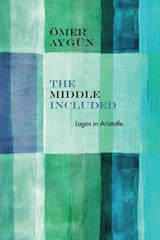 The Middle Included: Logos in Aristotle
Aygün, Ömer
Northwestern University Press, 2016 The Middle Included is the first comprehensive account of the Ancient Greek word logos in Aristotelian philosophy. Logos means many things in the Aristotelian corpus: essential formula, proportion, reason, and language. Surveying these meanings in Aristotle’s logic, physics, and ethics, Ömer Aygün persuasively demonstrates that these divers meanings of logos all refer to a basic sense of “gathering” or “inclusiveness.” In this sense, logos functions as a counterpart to a formal version of the principles of non-contradiction and of the excluded middle in his corpus. Aygün thus shifts Aristotle’s traditional image from that of the father of formal logic, classificatory thinking, and exclusion to a more nuanced image of him as a thinker of inclusion.
The Middle Included also explores human language in Aristotelian philosophy. After an account of acoustic phenomena and animal communication, Aygün argues that human language for Aristotle is the ability to understand and relay both first-hand experiences and non-first-hand experiences. This definition is key to understanding many core human experiences such as science, history, news media, education, sophistry, and indeed philosophy itself. Logos is thus never associated with any other animal nor with anything divine—it remains strictly and rigorously secular, humane, and yet full of the wonder.
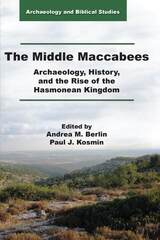 The Middle Maccabees: Archaeology, History, and the Rise of the Hasmonean Kingdom
Andrea M. Berlin
SBL Press, 2021 A focused, interdisciplinary examination of a tumultuous, history-making era
The Middle Maccabees lays out the charged, complicated beginnings of the independent Jewish state founded in the second century BCE. Contributors offer focused analyses of the archaeological, epigraphic, numismatic, and textual evidence, framed within a wider world of conflicts between the Ptolemies of Egypt, the Seleucids of Syria, and the Romans. The result is a holistic view of the Hasmonean rise to power that acknowledges broader political developments, evolving social responses, and the particularities of local history. Contributors include Uzi ‘Ad, Donald T. Ariel, Andrea M. Berlin, Efrat Bocher, Altay Coşkun, Benedikt Eckhardt, Gerald Finkielsztejn, Christelle Fischer-Bovet, Yuval Gadot, Erich Gruen, Sylvie Honigman, Jutta Jokiranta, Paul J. Kosmin, Uzi Leibner, Catharine Lorber, Duncan E. MacRae, Dvir Raviv, Helena Roth, Débora Sandhaus, Yiftah Shalev, Nitsan Shalom, Danny Syon, Yehiel Zelinger, and Ayala Zilberstein.
Features
- Up-to-date, generously illustrated essays analyzing the relevant archaeological remains
- A revised understanding of how local and imperial histories overlapped and intersected
- New analysis of the book of 1 Maccabees as a tool of Hasmonean strategic interest
Middle Mississippi Exploitation of Animal Populations
Bruce D. Smith
University of Michigan Press, 1975 Bruce D. Smith reports on the faunal remains of seven Middle Mississippi sites in Tennessee, Arkansas, and Missouri, in the northern part of the Lower Mississippi River Valley. Remains recovered include those from white-tailed deer, raccoon, fish, turkey, rabbits, black bear, and more. The seven sites—the Banks site, the Chucalissa site, the Gooseneck site, the Lilbourn site, Powers Fort, the Snodgrass site, and the Turner site—date to between AD 1000 and 1550.
The Middle of the World
Kathleen Norris
University of Pittsburgh Press, 1981 The Middle of the World reflects Norris’s strong gifts as a storyteller and poet of place. The locales are New York City, where she formerly lived, and South Dakota west of the Missouri River, where she is business manager of a family farm that raises wheat, sunflowers, and Hereford cattle. “The poems are about these places,” she writes, “and the more or less imagined lives in them: and also about family and inheritance; it was inheritance that moved me to South Dakota. Some of the poems are about faith: my own ideas as well as the traditional religious faith that is a thread running through my family history, both enhancing lives and running them.”
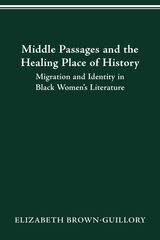 MIDDLE PASSAGES AND THE HEALING PLACE OF HISTORY: MIGRATION AND IDENTITY IN BLACK WOMEN'S LITERATURE
ELIZABETH BROWN-GUILLORY
Ohio State University Press, 2006 Middle Passages and the Healing Place of History: Migration and Identity in Black Women’s Literature brings together a series of essays addressing black women’s fragmented identities and quests for wholeness. The individual essays concern culturally specific experiences of blacks in select African countries, England, the Caribbean, the United States, and Canada. They examine identity struggles by establishing the Middle Passage as the first site of identity rupture and the subsequent break from cultural and historical moorings. In most cases, the authors themselves have migrated from their places of origin to new spaces that present challenges. Their narratives replicate the displacement engendered by their own experiences of living with the complexities of diasporic existence. Their female characters, many of whom participate in multiple border crossings, work to define themselves within a hostile environment. In nearly every essay, the female characters struggle against multiple yokes of oppression, giving voice to what it means to be black, female, poor, old, and alone. The subjects’ migrations and journeys are analyzed as attempts to heal the “displacement,” both physical and psychological, that results from dislocation and relocation from the homeland, imagined variously as Africa.
This volume reveals that black women across the globe share a common ground fraught with struggles, but the narratives bear out that these women are not easily divided and that they stand upon each other’s shoulders dispensing healing balms. Black women’s history and herstory commingle; the trauma that ensued when Africans were loaded onto ships in chains continues to haunt black women, and men, too, wherever they find themselves in this present moment of the Diaspora.
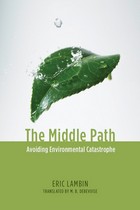 The Middle Path: Avoiding Environmental Catastrophe
Eric Lambin
University of Chicago Press, 2007
The debate about global warming is over. There is no longer any question that human activity is causing the Earth’s climate to heat up at an increasingly rapid rate, with consequences that we are now only beginning to understand. Meanwhile, human population growth is placing unsustainable demands on everything from animal habitats to water supplies. Faced with radically different assessments of the long-term effects of global warming—from oil companies, scientists, business lobbies, and environmental groups—concerned citizens find it difficult to tell how dire the prognosis really is. Is life on Earth doomed, or is there still time to mitigate—even to reverse—the damage that has already been done?
In The Middle Path, noted geographer Eric Lambin provides a concise, readable summary of the present state of the environment and considers what must be done if environmental catastrophe is to be avoided. Finding merit in the arguments of both optimists and pessimists, Lambin argues that it is not too late to exploit the inherent tendency toward equilibrium of large-scale systems such as the earth’s environment. By relying upon a combination of remedies as global as international cap-and-trade emission treaties and as local as municipal programs promoting the use of bicycles rather than cars, it may yet be possible to rescue humanity from a potentially fatal crisis of its own making.
Based on rigorous scientific analysis, and strikingly free of ideological prejudice, The Middle Path presents a fresh view of our troubled future, brilliantly balancing tough-minded realism with humanitarian ideals of cooperation and ingenuity.
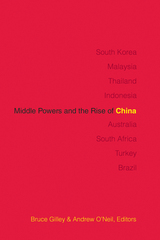 Middle Powers and the Rise of China
Bruce Gilley and Andrew O'Neil, Editors
Georgetown University Press, 2014 China’s rise is changing the dynamics of the international system. Middle Powers and the Rise of China is the first work to examine how the group of states referred to as “middle powers” are responding to China’s growing economic, diplomatic, and military power. States with capabilities immediately below those of great powers, middle powers still exercise influence far above most other states. Their role as significant trading partners and allies or adversaries in matters of regional security, nuclear proliferation, and global governance issues such as human rights and climate change are reshaping international politics. Contributors review middle-power relations with China in the cases of South Korea, Malaysia, Thailand, Indonesia, Australia, South Africa, Turkey, and Brazil, addressing how these diverse nations are responding to a rising China, the impact of Chinese power on each, and whether these states are being attracted to China or deterred by its new power and assertiveness. Chapters also explore how much (or how little) China, and for comparison the US, value middle powers and examine whether or not middle powers can actually shape China’s behavior. By bringing a new analytic approach to a key issue in international politics, this unique treatment of emerging middle powers and the rise of China will interest scholars and students of international relations, security studies, China, and the diverse countries covered in the book.
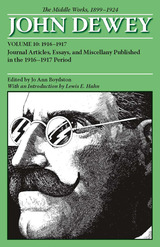 The Middle Works of John Dewey, Volume 10, 1899 - 1924: Journal Articles, Essays, and Miscellany Published in the 1916-1917 Period
John Dewey. Edited by Jo Ann Boydston
Southern Illinois University Press, 2008 Except for Democracy and Education, the 53 items in Volume 10 include all of Dewey’s writings from 1916–1917, the years when he moved into politics and began to write about topics of general public interest. The best known of Dewey’s writings in this volume is the essay from Creative Intelligence, “The Need for a Recovery of Philosophy.” Here Dewey asserts that “Philosophy recovers itself when it ceases to be a device for dealing with the problems of philosophers and becomes a method for dealing with the problems of men.” Dewey put that idea into practice, as Lewis E. Hahn points out in his introduction. “In 1916–1917 [Dewey] commented on quite a range of issues from compulsory universal military training to the Wilson-Hughes presidential campaign, from conscription of thought to the future of pacifism, from what America will fight for to appropriate peace terms . . . and from American education and culture to contemporary issues in education, with the war casting a shadow over most of the items.”
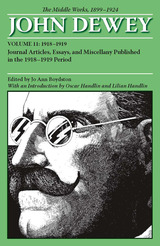 The Middle Works of John Dewey, Volume 11, 1899 - 1924: Journal Articles, Essays, and Miscellany Published in the 1918-1919 Period
John Dewey. Edited by Jo Ann Boydston
Southern Illinois University Press, 2008 Volume 11 brings together all of Dewey’s writings for 1918 and 1919. A Modern Language Association Committee on Scholarly Editions textual edition. Dewey’s dominant theme in these pages is war and its aftermath. In the Introduction, Oscar and Lilian Handlin discuss his philosophy within the historical context: “The First World War slowly ground to its costly conclusion; and the immensely more difficult task of making peace got painfully under way. The armistice that some expected would permit a return to normalcy opened instead upon a period of turbulence that agitated further a society already unsettled by preparations for battle and by debilitating conflict overseas.” After spending the first half of 1918–19 on sabbatical from Columbia at the University of California, Dewey traveled to Japan and China, where he lectured, toured, and assessed in his essays the relationship between the two nations. From Peking he reported the student revolt known as the May Fourth Movement. The forty items in this volume also include an analysis of Thomas Hobbe’s philosophy; an affectionate commemorative tribute to Theodore Roosevelt, “our Teddy”; the syllabus for Dewey’s lectures at the Imperial University in Tokyo, which were later revised and published as Reconstruction in Philosophy; an exchange with former disciple Randolph Bourne about F. Matthias Alexander’s Man’sSupreme Inheritance; and, central to Dewey’s creed, “Philosophy and Democracy.” His involvement in a study of the Polish-American community in Philadelphia—resulting in an article, two memoranda, and a lengthy report—is discussed in detail in the Introduction and in the Note on the “Confidential Report of Conditions among the Poles in the United States.”
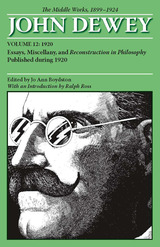 The Middle Works of John Dewey, Volume 12, 1899 - 1924: Essays, Miscellany, and Reconstruction in Philosophy Published during 1920
John Dewey. Edited by Jo Ann Boydston
Southern Illinois University Press, 2008 A collection of all of Dewey’s writings for 1920 with the exception of Letters from China and Japan. A Modern Language Association Committee on Scholarly Editions textual edition. The nineteen items collected here, including his major work, Reconstruction in Philosophy, evolved in the main from Dewey’s travel, touring, lecturing, and teaching in Japan and China. Ralph Ross notes in his Introduction to this volume that Reconstruction in Philosophy is “a radical book . . . a pugnacious book by a gentle man.” It is in this book that Dewey summarizes his version of pragmatism, then called Instrumentalism. For Dewey, the pragmatist, it was people acting on the strength of intelligence modeled on science who could find true ideas, ones “we can assimilate, validate, corroborate, and verify.” Optimism pervades Reconstruction of Philosophy; in keeping with Dewey’s world of open possibilities, the book recognizes that the observation and thought of human striving can make the difference between despair and affirmation of life. The seven essays on Chinese politics and social tradition that Dewey sent back from the Orient exhibit both the liveliness and the sensitive power of an insightful mind. Set against a backdrop of Japanese hegemony in China, the last days of Manchu imperialism, Europe’s carving of China into concessions, and China’s subsequent refusal to accept the terms of the Treaty of Versailles, the essays were startlingly relevant in this time of Eastern turbulence and change. At the National University of Peking, Dewey delivered a series of lectures on “Three Contemporary Philosophers: William James, Henri Bergson, and Bertrand Russell.” The James and Bergson lectures are published for the first time in this volume. Dewey chose these philosophers, according to Ralph Ross, because he was trying to show “his oriental audience what he believed and hoped about man and society and was talking about those fellow philosophers who shared the same beliefs and hopes.”
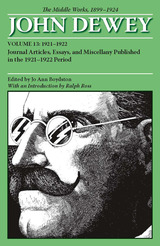 The Middle Works of John Dewey, Volume 13, 1899 - 1924: Journal Articles, Essays, and Miscellany Published in the 1921-1922 Period
John Dewey. Edited by Jo Ann Boydston
Southern Illinois University Press, 2008 Volume 13 in The Middle Works of John Dewey, 1899–1924, series brings together Dewey’s writings for 1921 and 1922,with the exception of Human Nature and Conduct. A Modern Language Association Committee on Scholarly Editions textual edition. Ralph Ross notes in his Introduction that the 53 items constituting this volume “defend Dewey’s beliefs at 63 and look forward to what he was yet to write.” The essays to which Dewey responded, as well as abstracts of articles that have been published only in Japanese, appear as appendixes. The article “Valuation and Experimental Knowledge” treats a favorite Dewey theme: “Most of the important crises of life are cases where tastes are the only things worth discussing, and where, if the life of reason is to exist and prevail, judgment must be performed with regard for its logical implications.” The philosophical articles stress Dewey’s view that, as Ross remarks, “philosophies are not timeless and universal, but speak to times, places and conditions.”
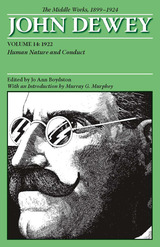 The Middle Works of John Dewey, Volume 14, 1899 - 1924: Human Nature and Conduct, 1922
John Dewey. Edited by Jo Ann Boydston
Southern Illinois University Press, 2008 Volume 14 of The Middle Works of John Dewey, 1899–1924, series provides an authoritative edition of Dewey’s Human Nature and Conduct. A Modern Language Association Committee on Scholarly Editions textual edition. Human Nature and Conduct evolved from the West Memorial Foundation lectures at Stanford University. The lectures were extensively rewritten and expanded into one of Dewey’s best-known works. As Murray G. Murphey says in his Introduction, “It was a work in which Dewey sought to make explicit the social character of his psychology and philosophy—something which had long been evident but never so clearly spelled out.” Subtitled “An Introduction to Social Psychology,” Human Nature and Conduct sets forth Dewey’s view that habits are social functions, and that social phenomena, such as habit and custom and scientific methods of inquiry are moral and natural. Dewey concludes, “Within the flickering inconsequential acts of separate selves dwells a sense of the whole which claims and dignifies them. In its presence we put off mortality and live in the universal.”
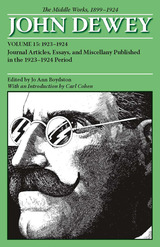 The Middle Works of John Dewey, Volume 15, 1899 - 1924: Journal Articles, Essays, and Miscellany Published in the 1923-1924 Period
John Dewey. Edited by Jo Ann Boydston
Southern Illinois University Press, 2008 Volume 15 in The Middle Works of John Dewey, 1899–1924, series brings together Dewey’s writings for the period 1923–1924. A Modern Language Association Committee on Scholarly Editions textual edition. Volume 15 completes the republication of Dewey’s extensive writings for the 25-year period included in the Middle Works series. Many facets of Dewey’s interests—politics, philosophy, education, and social concerns—are illuminated by the 40 items from 1923 and 1924. Inspired by his own convictions and those of his friend Salmon O. Levinson, founder of the American Committee for the Outlawry of War, Dewey’s articles became the keystone of the committee’s campaign to outlaw war. His essay, “Logical Method and Law,” is perhaps the most enduring of Dewey’s writings in this volume. Dewey’s philosophical discussions with Daniel Sommer Robinson, David Wight Prall, Arthur Oncken Lovejoy, and Sterling Power Lamprecht are represented here, as is Dewey’s assessment of the Turkish educational system.
The Middle Works of John Dewey, Volume 3, 1899 - 1924: Journal Articles, Book Reviews, and Miscellany in the 1903-1906 Period
John Dewey. Edited by Jo Ann Boydston
Southern Illinois University Press, 2008 Spanning the crucial years of Dewey’s move from the University of Chicago to Columbia University, Volume 3 collects thirty-six essays and reviews published at the very time Dewey determined that his professional future would lie in the field of philosophy. After resigning from Chicago, Dewey seriously considered a career in university administration before finally deciding to accept a professorship in the Department of Philosophy at Columbia, where he was to remain the rest of his professional life.
The Middle Works of John Dewey, Volume 4, 1899 - 1924: Journal Articles and Book Reviews in the 1907-1909 Period, and The Pragmatic Movement of Contemporary Thought and Moral Principles in Education
John Dewey. Edited by Jo Ann Boydston
Southern Illinois University Press, 2008 By 1907, the first of the three years embraced by Volume 4, Dewey had abandoned thoughts of a possible career in the administration of higher education and was firmly established as a leading member of the Department of Philosophy at Columbia. As Lewis Hahn points out in his Introduction, these were “very productive years for Dewey. In addition to numerous lectures and speaking engagements and participation in professional meetings, he published fifteen or so substantial articles, almost as many shorter things, a syllabus on The Pragmatic Movement of Contemporary Thought, a monograph on Moral Principles in Education, and, with J. H. Tufts, the first edition of a very popular textbook, Ethics.”
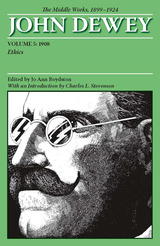 The Middle Works of John Dewey, Volume 5, 1899-1924: Ethics, 1908
John Dewey. Edited by Jo Ann Boydston
Southern Illinois University Press, 2008 Thisfifth volume of the Middle Works contains Ethics by John Dewey and his former colleague at the University of Michigan, James H. Tufts, which appeared as one of the last in the Holt American Science series of textbooks. Within some six months after publication, Ethics was adopted as a textbook by thirty colleges. The book continued to be extremely popular and widely used, and was reprinted twenty-five times before both authors completely revised their respective parts for the new 1932edition. Up to the time Ethics was published, Dewey’s approach to ethics was known primarily from two short publications that were developed for use by his classes at the University of Michigan: Outlines of a Critical Theory of Ethics (1891)and The Study of Ethics: A Syllabus (1894). Charles Stevenson notes in his Introduction to the present edition that Ethics afforded Dewey an opportunity to preserve and enrich the content of those earlier works and at the same time to expound his position in a more systematic manner.
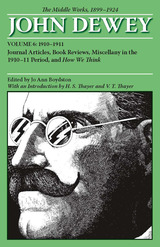 The Middle Works of John Dewey, Volume 6: Journal Articles, Book Reviews, Miscellany in the 1910-1911 Period, and How We Think
John Dewey. Edited by Jo Ann Boydston
Southern Illinois University Press, 2008 William James, remarking in 1909 on the differences among the three leading spokesmen for pragmatism—himself, F. C. S. Schiller, and John Dewey—said that Schiller’s views were essentially “psychological,” his own, “epistemological,” whereas Dewey’s “panorama is the widest of the three.” The two main subjects of Dewey’s essays at this time are also two of the most fundamental and persistent philosophical questions: the nature of knowledge and the meaning of truth. Dewey’s distinctive analysis is concentrated chiefly in seven essays, in a long, significant, and previously almost unknown work entitled “The Problem of Truth,” and in his book How We Think. As a whole, the 1910–11 writings illustrate especially well that which the Thayers identify in their Introduction as Dewey’s “deepening concentration on questions of logic and epistemology as contrasted with the more pronounced psychological and pedagogical treatment in earlier writings.”
The Middle Works of John Dewey, Volume 7, 1899 - 1924: Essays, Books Reviews, Encyclopedia Articles in the 1912-1914 Period, and Interest and Effort in Education
John Dewey. Edited by Jo Ann Boydston
Southern Illinois University Press, 2008 During the three years embraced by Volume 7, Dewey published twenty articles and reviews, one of the articles of monograph-length, “The Psychology of Social Behavior,” one small book, Interest and Effort in Education, and seventy encyclopedia articles. A salient and arresting feature of the essays is the continuing polemic between Dewey and some of his critics. Ralph Ross, whose perceptive Introduction to the volume provides a broad perspective of the various philosophical controversies in which Dewey was engaged, comments that “when Dewey was pitting himself against important adversaries, his talents as a critic were fully evident.”
The Middle Works of John Dewey, Volume 8, 1899 - 1924: Essays and Miscellany in the 1915 Period and German Philosophy and Politics and Schools of To-Morrow
John Dewey. Edited by Jo Ann Boydston
Southern Illinois University Press, 2008 Volume 8 comprises all Dewey’s published writings for the year 1915—and only for 1915, a year of typically elevated productivity, which saw publication of fifteen articles and miscellaneous pieces and three books, two of which are reprinted here: German Philosophy and Politics and Schools of Tomorrow. Professor Hook says that the publications in this volume reveal John Dewey at the height of his philosophical powers. Even though his greatest works were still to come—Democracy and Education, Experience and Nature, The Quest for Certainty, and Logic: The Theory of Inquiry—“the themes elaborated therein were already sounded and developed with incisive brevity in the articles and books of this banner year.”
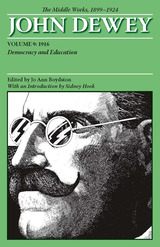 The Middle Works of John Dewey, Volume 9, 1899-1924: Democracy and Education, 1916
John Dewey. Edited by Jo Ann Boydston
Southern Illinois University Press, 2008 John Dewey’s best-known and still-popular classic, Democracy and Education, is presented here as a new edition in Volume 9 of the Middle Works. Sidney Hook, who wrote the introduction to this volume, describes Democracy and Education: “It illuminates directly or indirectly all the basic issues that are central today to the concerns of intelligent educators. . . . It throws light on several obscure corners in Dewey’s general philosophy in a vigorous, simple prose style often absent in his more technical writings. And it is the only work in any field originally published as a textbook that has not merely acquired the status of a classic, but has become the one book that no student concerned with the philosophy of education today should leave unread.” Dewey said in 1930 that Democracy and Education, “was for many years the one [book] in which my philosophy . . . was most fully expounded.”
 Middletown Families: Fifty Years of Change and Continuity
Theodore Caplow, Bruce A. Chadwick, Howard M. Bahr, Reuben Hill, and Margaret Holmes Williamson
University of Minnesota Press, 1985 Middletown Families was first published in 1985. Minnesota Archive Editions uses digital technology to make long-unavailable books once again accessible, and are published unaltered from the original University of Minnesota Press editions. Fifty years after publication of Robert and Helen Lloyd's classic studies, Middletown (1929) and Middletown in Transition (1937), the Middletown III Project picked up and continued their exploration of American values and institutions. By duplicating the original studies - in many cases by using the same questions - this team of social scientists attempted to gauge the changes that had taken place in Muncie, Indiana, since the 1920s. In Middletown Families, the first book to emerge from this project, Theodore Caplow and his colleagues reveal that many widely discussed changes in family life, such as the breakdown of traditional male/female roles, increased conflict between parents and children, and disintegration of extended family ties, are more perceived than actual. Their evidence suggests that the Middletown family seems to be stronger and more tolerant, with closer bonds and greater marital satisfaction than fifty years ago. Instead of breaking it apart, the pressures of modern society may have drawn the family closer together.
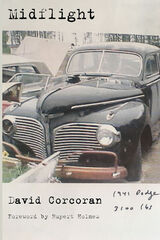 Midflight
David Corcoran
Four Way Books, 2022 A posthumous collection, Midflight collects the poems written by beloved science editor and journalist David Corcoran in the latter part of his life. Idling in a space between the pastoral and the ordinary, Corcoran’s lyrical world maps the sublime mundanity of nature while exploring memory, dreams, and consciousness itself. Corcoran’s lines abound with figures living and long deceased, with the dead walking onstage as if they never left. Describing the accident that killed his father when he was a toddler in “Here,” Corcoran writes, “the door [opens] in midflight / and [pitches] him out.” In “Last Questions,” he asks, “Are you my brother or / a mockingbird?” While these haunting, vivid poems have an aching prescience, imbued as they are with the awareness of human ephemerality, the gift they proffer, to the writer and the reader at once, is the sense of finding oneself midflight, in midair, betwixt sky and ground, in the free fall of being—going and going and never gone.
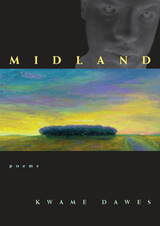 Midland: Poems
Kwame Dawes
Ohio University Press, 2000 The winning manuscript of the fourth annual Hollis Summers Poetry Prize is also the exciting American debut by a poet who has already established himself as an important international poetic voice. Midland, the seventh collection by Kwame Dawes, draws deeply on the poet’s travels and experiences in Africa, the Caribbean, England, and the American South. Marked equally by a lushness of imagery, an urgency of tone, and a muscular rhythm, Midland, in the words of the final judge, Eavan Boland, is “a powerful testament of the complexity, pain, and enrichment of inheritance…It is a compelling meditation on what is given and taken away in the acts of generation and influence. Of a father’s example and his oppression. There are different places throughout the book. They come willfully in and out of the poems: Jamaica. London. Africa. America. But all the places become one place in the central theme and undersong here: which is displacement…The achievement of this book is a beautifully crafted voice which follows the painful and vivid theme of homelessness in and out of the mysteries of loss and belonging.” Midland is the work of a keen and transcendent intellect, a collection of poems that speaks to the landscape from inside, from an emotional and experiential place of risk and commitment.
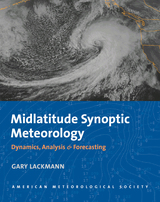 Midlatitude Synoptic Meteorology: Dynamics, Analysis, and Forecasting
Gary Lackmann
American Meteorological Society, 2011 The past decade has been characterized by remarkable advances in meteorological observation, computing techniques, and data-visualization technology. However, the benefit of these advances can only be fully realized with the introduction of a systematic, applied approach to meteorological education that allows well-established theoretical concepts to be applied to modernized observational and numerical datasets. This textbook links theoretical concepts to modern technology and facilitates the meaningful application of concepts, theories, and techniques using real data. As such, it will both serve those planning careers in meteorological research and weather prediction, and provide a template for the application of modern technology in a classroom and laboratory setting. Synoptic-dynamic meteorology, synoptically driven mesoscale phenomena, weather forecasting, and numerical weather prediction are covered in depth in this text, which is intended for undergraduates and beginning graduate students in the atmospheric sciences.
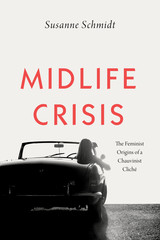 Midlife Crisis: The Feminist Origins of a Chauvinist Cliché
Susanne Schmidt
University of Chicago Press, 2020 The phrase “midlife crisis” today conjures up images of male indulgence and irresponsibility—an affluent, middle-aged man speeding off in a red sports car with a woman half his age—but before it become a gendered cliché, it gained traction as a feminist concept. Journalist Gail Sheehy used the term to describe a midlife period when both men and women might reassess their choices and seek a change in life. Sheehy’s definition challenged the double standard of middle age—where aging is advantageous to men and detrimental to women—by viewing midlife as an opportunity rather than a crisis. Widely popular in the United States and internationally, the term was quickly appropriated by psychological and psychiatric experts and redefined as a male-centered, masculinist concept.
The first book-length history of this controversial concept, Susanne Schmidt’s Midlife Crisis recounts the surprising origin story of the midlife debate and traces its movement from popular culture into academia. Schmidt’s engaging narrative telling of the feminist construction—and ensuing antifeminist backlash—of the midlife crisis illuminates a lost legacy of feminist thought, shedding important new light on the history of gender and American social science in the 1970s and beyond.
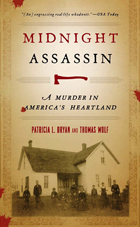 Midnight Assassin: A Murder in America's Heartland
Patricia L. Bryan
University of Iowa Press, 2007 On the night of December 1,1900, Iowa farmer John Hossack was attacked and killed while he slept at home beside his wife, Margaret. On April 11, 1901, after five days of testimony before an all-male jury, Margaret Hossack was found guilty of his murder and sentenced to life in prison. One year later, she was released on bail to await a retrial; jurors at this second trial could not reach a decision, and she was freed. She died August 25, 1916, leaving the mystery of her husband's death unsolved.
The Hossack tragedy is a compelling one and the issues surrounding their domestic problems are still relevant today, Margaret's composure and stoicism, developed during years of spousal abuse, were seen as evidence of unfeminine behavior, while John Hossack--known to be a cruel and dangerous man--was hailed as a respectable husband and father.
Midnight Assassin also introduces us to Susan Glaspell, a journalist who reported on the Hossack murder for the Des Moines Daily, who used these events as the basis for her classic short story, " A Jury of Her Peers", and the famous play Trifles. Based on almost a decade of research, Midnight Assassin is a riveting story of loneliness, fear, and suffering in the rural Midwest.
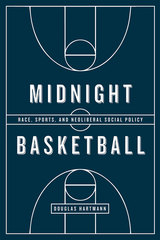 Midnight Basketball: Race, Sports, and Neoliberal Social Policy
Douglas Hartmann
University of Chicago Press, 2016 Midnight basketball may not have been invented in Chicago, but the City of Big Shoulders—home of Michael Jordan and the Bulls—is where it first came to national prominence. And it’s also where Douglas Hartmann first began to think seriously about the audacious notion that organizing young men to run around in the wee hours of the night—all trying to throw a leather ball through a metal hoop—could constitute meaningful social policy.
Organized in the 1980s and ’90s by dozens of American cities, late-night basketball leagues were designed for social intervention, risk reduction, and crime prevention targeted at African American youth and young men. In Midnight Basketball, Hartmann traces the history of the program and the policy transformations of the period, while exploring the racial ideologies, cultural tensions, and institutional realities that shaped the entire field of sports-based social policy. Drawing on extensive fieldwork, the book also brings to life the actual, on-the-ground practices of midnight basketball programs and the young men that the programs intended to serve. In the process, Midnight Basketball offers a more grounded and nuanced understanding of the intricate ways sports, race, and risk intersect and interact in urban America.
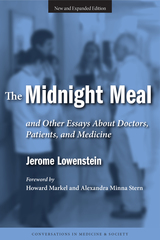 The Midnight Meal and Other Essays About Doctors, Patients, and Medicine
Jerome Lowenstein
University of Michigan Press, 2005 In this expanded edition, an accomplished physician and teacher of medicine discusses the importance of being a caring doctor, especially now that the focus of medicine is increasingly on technological innovation and health care costs. With wisdom and compassion, Dr. Jerome Lowenstein tells stories about relationships between medical students and their teachers, physicians and their patients. He reflects on what doctors learn from treating chronic illness; how they respond to patients' needs for reassurance; how they bear the burden of treating patients with life-threatening or degenerative disease; whether the distinction between traditional and "alternative" medical treatment is ultimately beneficial or destructive; and many other issues. Dr. Lowenstein's ruminations on humanistic approaches to learning and practicing medicine will be treasured by physicians, medical students, and patients alike.
Midrash and Theory: Ancient Jewish Exegesis and Contempory Literary Studies
David Stern
Northwestern University Press, 1998 In Midrash and Theory, David Stern presents an approach to midrashic literature through the prism of contemporary theory.
As midrash--the literature of classical Jewish Scriptural interpretation--has become the focus of new interest in contemporary literary circles, it has been invoked as a precursor of post-structuralist theory and criticism. At the same time, the midrashic imagination has undergone a revival in the larger Jewish community and shown itself capable of exercising a powerful influence and hold on a new type of contemporary Jewish writing. Stern examines this resurgence of fascination with ancient Jewish interpretation from the persepctive of the cultural relevance of midrash and its connection to its original historical and literary contexts.
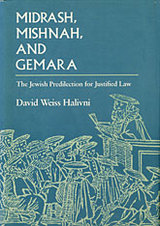 Midrash, Mishnah, and Gemara: The Jewish Predilection for Justified Law
David Weiss Halivni
Harvard University Press, 1986 An eminent authority on the Talmud offers here an analysis of classical rabbinic texts that illuminates the nature of Midrash, Mishnah, and Gemara, and highlights a fundamental characteristic of Jewish law.
Midrash is firmly based on—draws its support from—Scripture. It thus projects the idea that law must be justified. The concept, David Weiss Halivni demonstrates, is at the heart of Jewish law and can be traced from the Bible (especially evident in Deuteronomy) through the classical commentaries of the Talmud. Only Mishnah is—like other ancient Near Eastern law—apodictic, recognizing no need for justification. But Midrash existed before Mishnah and its law served as grounding for the non-justificatory Mishnaic texts. Indeed, Halivni argues, Mishnah was a deviant form and consequently short-lived and never successfully revived, a response to particular religious and political conditions after the destruction of the Temple in 70 CE. He chronicles the persistence of justificatory Midrash, the culmination of its development in Gemara in the fifth and sixth centuries, and its continuation down through the ages.
David Weiss Halivni has given us a lucid and compelling picture of the several modes of rabbinic learning and disputation and their historical relation to one another.
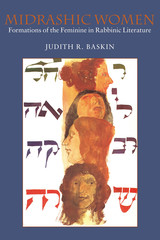 Midrashic Women: Formations of the Feminine in Rabbinic Literature
Judith R. Baskin
Brandeis University Press, 2002 While most gender-based analyses of rabbinic Judaism concentrate on the status of women in the halakhah (the rabbinic legal tradition), Judith R. Baskin turns her attention to the construction of women in the aggadic midrash, a collection of expansions of the biblical text, rabbinic ruminations, and homiletical discourses that constitutes the non-legal component of rabbinic literature. Examining rabbinic convictions of female alterity, competing narratives of creation, and justifications of female disadvantages, as well as aggadic understandings of the ideal wife, the dilemma of infertility, and women among women and as individuals, she shows that rabbinic Judaism, a tradition formed by men for a male community, deeply valued the essential contributions of wives and mothers while also consciously constructing women as other and lesser than men. Recent feminist scholarship has illuminated many aspects of the significance of gender in biblical and halakhic texts but there has been little previous study of how aggadic literature portrays females and the feminine. Such representations, Baskin argues, often offer a more nuanced and complex view of women and their actual lives than the rigorous proscriptions of legal discourse.
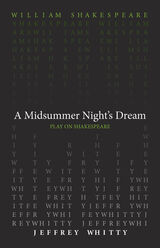 A Midsummer Night's Dream
William Shakespeare
Arizona Center for Medieval and Renaissance Studies, 2021 Shakespeare’s most spirited play, adapted for new audiences by Jeffrey Whitty.
Tony Award–winning and Oscar-nominated storyteller Jeffrey Whitty offers his adaptation of A Midsummer Night’s Dream, mindfully adapted into modern language. Matching the Bard line for line, rhyme for rhyme, Whitty illuminates Shakespeare’s meaning for modern audiences while maintaining the play’s storytelling architecture, emotional texture, and freewheeling humor. Designed to supplement, not supplant, the original, Whitty’s Midsummer cuts through the centuries to bring audiences a fresh, moment-by-moment take, designed to flow as effortlessly for modern audiences as Shakespeare’s beloved classic played to the Elizabethans.
This translation was written as part of the Oregon Shakespeare Festival’s Play On! project, which commissioned new translations of thirty-nine Shakespeare plays. These translations present the work of "The Bard" in language accessible to modern audiences while never losing the beauty of Shakespeare’s verse. These volumes make these works available for the first time in print—a new First Folio for a new era.
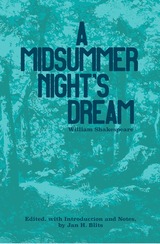 A Midsummer Night's Dream
Shakespeare William
St. Augustine's Press, 2024 "This edition of A Midsummer Night’s Dream takes the comedy seriously. Like my previous Hackett editions, it gives full weight to Shakespeare’s dramatic setting, which other editors (and scholars) almost always ignore or at least fail adequately to consider. Ancient Athens is the core, not the mere background, of Midsummer Night's Dream. As we shall see, Shakespeare focuses, in particular, on the love of the beautiful and the triumph of learning and art, along with the rise of democracy, which, as Pericles’ famously claims, are the hallmarks of Athens. 'We are lovers of the beautiful with thrift, and lovers of wisdom without softness' (Thucydides, The Peloponnesian War, 2.40.1). […]
Failure to consider classical Athens as central to Midsummer Night's Dream will cause a reader to miss not only the play’s remarkable substance, but much of its sparkling comedy as well. Far from impeding the play’s humor, focusing on Athens helps to bring out multi-layers of comedy that Shakespeare put there."
 Midsummer Night's Toast: Poems
Mamie Morgan
Ohio University Press Midsummer Night’s Toast is a collection that answers to no one, a freedom we learn the speaker has finally afforded herself after a half-life spent under the glaring light of tradition, fear, of men, of institutions. She’s answered to her parents, to students, to academia, shame, to the workshop model, to various earlier versions of herself and is ready—in short—to have a good time. The invite list for this particular party belongs entirely to her: friends, street names, Kelly Ripa inside a crossword puzzle, bounced checks, hurricanes and Marilyn Hacker, frat boys and birds, bridal shops, Chaucer, the pictures her husband draws, King Arthur, Adrienne Rich. She’s sad for sure, and angry, but she’s also fierce as fire. At times these poems feel hurried, because they are. The landscape of this book feels like that penultimate moment in When Harry Met Sally when Billy Crystal says, “When you realize you want to spend the rest of your life with somebody, you want the rest of your life to start as soon as possible.” Mamie Morgan is reenacting a half-life of pain utilizing a kaleidoscope she’s crafted from discarded paper, felt, cheap gemstones, crayons worn to nubs, and mixtapes. Lots of mixtapes.
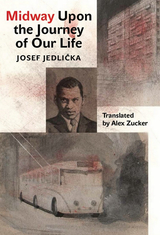 Midway Upon the Journey of Our Life
Josef Jedlicka
Karolinum Press, 2016 Written between 1954 and 1957 and treating events from the Stalinist era of Czechoslovakia’s postwar Communist regime, Midway Upon the Journeyof Our Life flew in the face of the reigning aesthetic of socialist realism, an anti-heroic novel informed by the literary theory of Viktor Shklovsky and constructed from episodes and lyrical sketches of the author and his neighbors’ everyday life in industrial north Bohemia, set against a backdrop of historical and cultural upheaval.
Meditative and speculative reflections here alternate and overlap with fragmentary accounts of Jedlicka’s own biography and slices of the lives of people around him, typically rendered as overheard conversations. The narrative passages range in chronology from May 1945 to the early 1950s, with sporadic leaps through time as the characters go about the business of “building a new society” and the mythology that goes with it. Due to its critical view of socialist society, Midway remained unpublished until 1966, amid the easing of cultural control, but a complete version of this darkly comic novel did not appear in Czech until 1994.
Midwest Maize: How Corn Shaped the U.S. Heartland
Cynthia Clampitt
University of Illinois Press, 2015 Food historian Cynthia Clampitt pens the epic story of what happened when Mesoamerican farmers bred a nondescript grass into a staff of life so prolific, so protean, that it represents nothing less than one of humankind's greatest achievements. Blending history with expert reportage, she traces the disparate threads that have woven corn into the fabric of our diet, politics, economy, science, and cuisine. At the same time she explores its future as a source of energy and the foundation of seemingly limitless green technologies. The result is a bourbon-to-biofuels portrait of the astonishing plant that sustains the world.
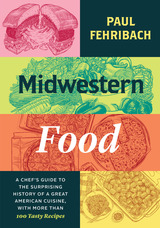 Midwestern Food: A Chef’s Guide to the Surprising History of a Great American Cuisine, with More Than 100 Tasty Recipes
Paul Fehribach
University of Chicago Press, 2023 An acclaimed chef offers a historically informed cookbook that will change how you think about Midwestern cuisine.
Celebrated chef Paul Fehribach has made his name serving up some of the most thoughtful and authentic regional southern cooking—not in the South, but in Chicago at Big Jones. But over the last several years, he has been looking to his Indiana roots in the kitchen, while digging deep into the archives to document and record the history and changing foodways of the Midwest.
Fehribach is as painstaking with his historical research as he is with his culinary execution. In Midwestern Food, he focuses not only on the past and present of Midwestern foodways but on the diverse cultural migrations from the Ohio River Valley north- and westward that have informed them. Drawing on a range of little-explored sources, he traces the influence of several heritages, especially German, and debunks many culinary myths along the way.
The book is also full of Fehribach’s delicious recipes informed by history and family alike, such as his grandfather's favorite watermelon rind pickles; sorghum-pecan sticky rolls; Detroit-style coney sauce; Duck and manoomin hotdish; pawpaw chiffon pie; strawberry pretzel gelatin salad (!); and he breaks the code to the most famous Midwestern pizza and BBQ styles you can easily reproduce at home. But it is more than just a cookbook, weaving together historical analysis and personal memoir with profiles of the chefs, purveyors, and farmers who make up the food networks of the region.
The result is a mouth-watering and surprising Midwestern feast from farm to plate. Flyover this!
 Midwestern Landscape Architecture
Edited by William H. Tishler
University of Illinois Press, 2000 This richly illustrated collection profiles the bold innovators in landscape architecture who, around the turn of the twentieth century, ventured into the nation's heartland to develop a new style of design celebrating the native midwestern landscape.
The pioneers of landscape architecture in the Midwest are responsible for creating some of the most recognizable parks, cemeteries, recreation areas, and other public gathering places in the region. Midwestern Landscape Architecture includes essays on Adolph Strauch, who introduced a new concept of visually integrated landscape treatment in Cincinnati's Spring Grove Cemetery; William Le Baron Jenney, designer of Chicago's diverse West Parks; and Jens Jensen, who created the American Garden in Union Park in Chicago (a celebration of native flora) and founder of The Clearing, a unique school of the arts and humanities in Wisconsin. Other major figures include Frederick Law Olmsted Sr., co-designer of New York's Central Park, whose work in the Midwest included the layout of the 1893 World's Columbian Exposition, and Ossian Cole Simonds, who helped reconcile the formal approach of the City Beautiful movement with the naturalism of the Prairie School in urban park design.
This volume also details the contributions of crusaders for ecological awareness and an appreciation of the region's natural heritage. These include horticultural writer Wilhelm Miller, who spread the ideals of the Prairie style, and Genevieve Gillette, a landscape architect and conservationist whose preservation efforts led to the establishment of numerous Michigan state parks and wilderness areas.
Midwestern Landscape Architecture fosters a better understanding of how landscape design took shape in the Midwest and how the land itself inspired new solutions to enhance its understated beauty. Despite Olmsted's assessment of the Illinois prairie as "one of the most tiresome landscapes that I ever met with," the Midwest has amassed an important legacy of landscape design that continues to influence how people interact with their environment in the heartland.
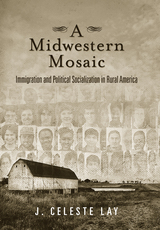 A Midwestern Mosaic: Immigration and Political Socialization in Rural America
J. Celeste Lay
Temple University Press, 2012 Drawn by low-skilled work and the safety and security of rural life, increasing numbers of families from Latin America and Southeast Asia have migrated to the American heartland. In the path-breaking book A Midwestern Mosaic, J. Celeste Lay examines the effects of political socialization on native white youth growing up in small towns.
Lay studies five Iowa towns to investigate how the political attitudes and inclinations of native adolescents change as a result of rapid ethnic diversification. Using surveys and interviews, she discovers that native adolescents adapt very well to foreign-born citizens, and that over time, gaps diminish between diverse populations and youth in all-white/Anglo towns in regard to tolerance, political knowledge, efficacy, and school participation.
A Midwestern Mosaic looks at the next generation to show how exposure to ethnic and cultural diversity during formative years can shape political behavior and will influence politics in the future.
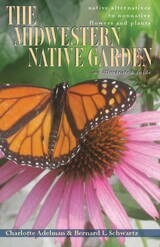 The Midwestern Native Garden: Native Alternatives to Nonnative Flowers and Plants
Charlotte Adelman, Bernard L. Schwartz
Ohio University Press, 2011 Midwestern gardeners and landscapers are becoming increasingly attracted to noninvasive regional native wildflowers and plants over popular nonnative species. The Midwestern Native Garden offers viable alternatives to both amateurs and professionals, whether they are considering adding a few native plants or intending to go native all the way. Native plants improve air and water quality, reduce use of pesticides, and provide vital food and reproductive sites to birds and butterflies, that nonnative plants cannot offer, helping bring back a healthy ecosystem. The authors provide a comprehensive selection of native alternatives that look similar or even identical to a range of nonnative ornamentals. These are native plants that are suitable for all garden styles, bloom during the same season, and have the same cultivation requirements as their nonnative counterparts. Plant entries are accompanied by nature notes setting out the specific birds and butterflies the native plants attract. The Midwestern Native Garden will be a welcome guide to gardeners whose styles range from formal to naturalistic but who want to create an authentic sense of place, with regional natives. The beauty, hardiness, and easy maintenance of native Midwestern plants will soon make them the new favorites.
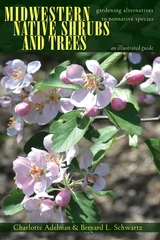 Midwestern Native Shrubs and Trees: Gardening Alternatives to Nonnative Species: An Illustrated Guide
Charlotte Adelman, Bernard L. Schwartz
Ohio University Press, 2016 In this companion volume to the bestselling The Midwestern Native Garden: Native Alternatives to Nonnative Flowers and Plants, Charlotte Adelman and Bernard L. Schwartz offer another indispensible guide to replacing nonnative plants with native alternatives. This time, their subject is the native woody species that are the backbone of our gardens and landscapes. Among other ecological benefits, native shrubs and trees provide birds and butterflies with vital food and reproductive sites that nonnative species cannot offer. And they tend to be hardier and easier to maintain. The authors provide a comprehensive selection of native woody alternatives that, season by season, provide effects similar to those of nonnative shrubs and trees used for ornamental purposes and shade. These plants are suitable for all garden styles, provide blooms and fall color, and have the same cultivation requirements as their nonnative counterparts. Nature notes alert readers to the native species’ unique ecological roles. Unlike other gardening guides, Midwestern Native Shrubs and Trees goes beyond mere suggestion to provide gardeners with the tools they need to make informed, thoughtful choices. Knowing which native species to plant for desired effects empowers landscapers and gardeners to take on a greater role in protecting our midwestern environment.
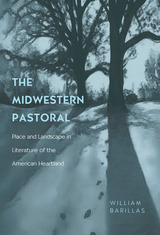 The Midwestern Pastoral: Place and Landscape in Literature of the American Heartland
William Barillas
Ohio University Press, 2006 The midwestern pastoral is a literary tradition of place and rural experience that celebrates an attachment to land that is mystical as well as practical, based on historical and scientific knowledge as well as personal experience. It is exemplified in the poetry, fiction, and essays of writers who express an informed love of the nature and regional landscapes of the Midwest. Drawing on recent studies in cultural geography, environmental history, and mythology, as well as literary criticism, The Midwestern Pastoral: Place and Landscape in Literature of the American Heartland relates Midwestern pastoral writers to their local geographies and explains their approaches. William Barillas treats five important Midwestern pastoralists—Willa Cather, Aldo Leopold, Theodore Roethke, James Wright, and Jim Harrison—in separate chapters. He also discusses Jane Smiley, U.S. Poet Laureate Ted Kooser, Paul Gruchow, and others. For these writers, the aim of writing is not merely intellectual and aesthetic, but democratic and ecological. In depicting and promoting commitment to local communities, human and natural, they express their love for, their understanding of, and their sense of place in the American Midwest. Students and serious readers, as well as scholars in the growing field of literature and the environment, will appreciate this study of writers who counter alienation and materialism in modern society.
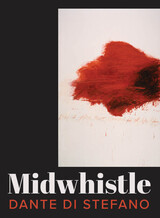 Midwhistle
Dante Di Stefano
University of Wisconsin Press, 2023 Appearing on the first page of Dante Di Stefano’s Midwhistle, a flock of blackbirds braids its way throughout this book-length poem—an elegy to life itself. A sprawling, digressive love note to an unborn son, it is also a celebration of the life and legacy of poet William Heyen, a meditation on midlife, and an exploration of the food and fuel of poetry itself. Di Stefano travels through a controlled stream of consciousness as he examines the weights of joy and grief. Bearing witness to the world, Midwhistle unfolds and refolds upon itself, touching on Hiroshima, Bergen-Belsen, Charlottesville, the sacoglossan sea slug, Darwin's Arch, and much more. Stylistically formal, the poem soars and dips, lightly and deftly finding the light in nighttime meditations, as the poet considers “our Unyet son, lemon-sized, / amniotic cosmonaut,” while imagining Heyen at his own age, “the thin black necktie of your / apprenticeship had not been / taken off yet.” In these examinations we find the poet himself, faced always with a “blinking / cursor,” seeking in the words and lives of other poets what it really means to write poetry. Midwhistle, in its meandering self-reflection and loving expansiveness, is a celebration of the act of poetic creation itself. Remember, to be human is to be broken &, to be broken, is to see the almond blossom burst under the closed eyelids of
your beloved.
—Excerpt from “xxiii. (interlude: prayer for Gaza)”
Midwife to the Queen of France: Diverse Observations
Louise Bourgeois
Iter Press, 2017 Diverse Observations is a groundbreaking book available for the first time in English. Written by a midwife committed to improving the care of women and newborns, it records the evolution of Bourgeois’s practice and beliefs, comments on changing attitudes related to reproductive health, and critiques the gendered elitism of the early modern medical hierarchy
 Midwifery and Childbirth in America
Judith Rooks
Temple University Press, 1999 Childbirth is both a profound experience and a contested subject. The experience of women has complex medical, historical, cultural, and public policy dimensions. In this book, Judith Rooks achieves the rare feat of bringing these dimensions together in a way that can be appreciated by health care planners, midwives, physicians, and women considering pregnancy.
The author vividly describes the history of struggle among health care providers over the meaning and handling of the birth process. The medical model and the midwifery model continue to collide today, the former focusing on pathology and monitoring the patient for it, the latter focusing on birth as a normal, healthy process.
The education and professional training of those who care for women during pregnancy, childbirth, and the important postpartum period reflects these divisions. Obstetrics, family physicians, midwives, nurses, and others play roles in providing the necessary care. In focusing on midwives, Rooks deals fairly and sensitively between certified nurse-midwives and direct-entry midwives, most of whom lack formal educational preparation in midwifery.
This book describes clearly and with documented scientific evidence the specific benefits of the midwifery approach to the care of pregnant women and their families. In clear language accessible to the lay reader, Rooks summarizes the research on the unintended effects of obstetrical interventions, such as episiotomies, epidurals, C-sections, and continuous electronic fetal heart monitoring, and the effectiveness and important benefits of an approach that focuses on the positive potential of childbearing, as contrasted with a narrow focus of potential for pathology. While she acknowledges the importance of access to medical care, extensive research shows the advantages of the midwifery approach. Much that passes for "routine" obstetric care in the United States has been found to be unnecessary, ineffective, or even harmful when applied to women with normal pregnancies.
The arguments over the control of childbirth are set in the context of recent changes in health care, including the current transition to managed care; the impact of the women's movement and movements for natural childbirth, home birth, and breastfeeding; and women's fear of and concern about the pain associated with labor. Rooks also explains the influence of the reports and recommendations of prestigious scientific and health-policy commissions and of federal initiatives and programs on the care provided to pregnant women in this country. She contrasts U.S. practices with those of comparable industrialized countries like the European states, Canada, Australia, New Zealand, and Japan.
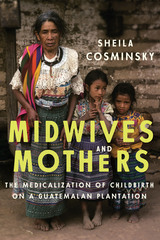 Midwives and Mothers: The Medicalization of Childbirth on a Guatemalan Plantation
By Sheila Cosminsky
University of Texas Press, 2016 The World Health Organization is currently promoting a policy of replacing traditional or lay midwives in countries around the world. As part of an effort to record the knowledge of local midwives before it is lost, Midwives and Mothers explores birth, illness, death, and survival on a Guatemalan sugar and coffee plantation, or finca, through the lives of two local midwives, Doña Maria and her daughter Doña Siriaca, and the women they have served over a forty-year period. By comparing the practices and beliefs of the mother and daughter, Sheila Cosminsky shows the dynamics of the medicalization process and the contestation between the midwives and biomedical personnel, as the latter try to impose their system as the authoritative one. She discusses how the midwives syncretize, integrate, or reject elements from Mayan, Spanish, and biomedical systems. The midwives’ story becomes a lens for understanding the impact of medicalization on people’s lives and the ways in which women’s bodies have become contested terrain between traditional and contemporary medical practices. Cosminsky also makes recommendations for how ethno-obstetric and biomedical systems may be accommodated, articulated, or integrated. Finally, she places the changes in the birthing system in the larger context of changes in the plantation system, including the elimination of coffee growing, which has made women, traditionally the primary harvesters of coffee beans, more economically dependent on men.
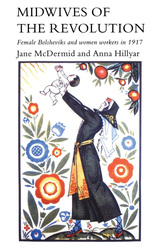 Midwives of the Revolution: Female Bolsheviks and Women Workers in 1917
Jane McDermid
Ohio University Press, 1999 The Bolshevik seizure of power in 1917 and the ensuing communist regime have often been portrayed as a man’s revolution, with women as bystanders or even victims. Midwives of the Revolution examines the powerful contribution made by women to the overthrow of tsarism in 1917 and their importance in the formative years of communism in Russia. Focusing on the masses as well as the high-ranking intelligentsia, Midwives of the Revolution is the first sustained analysis of female involvement in the revolutionary era of Russian history. The authors investigate the role of Bolshevik women and the various forms their participation took. Drawing on the experiences of representative individuals, the authors discuss the important relationship between Bolshevik women and the workers in the turbulent months of 1917. The authors demonstrate that women were an integral part of the revolutionary process and challenge assumptions that they served merely to ignite an essentially masculine revolt. By placing women center stage, without exaggerating their roles, this study enriches our understanding of a momentous event in twentieth-century history.
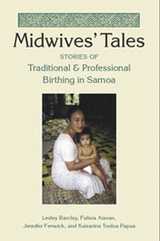 Midwives' Tales: Stories of Traditional and Professional Birthing in Samoa
Lesley Barclay
Vanderbilt University Press, 2005 The result of a ten-year collaboration between Australian and Samoan researchers and midwives, this book compiles the first-person stories of several generations of Samoan midwives, both those who use traditional techniques for home birth and those who use Western techniques in a hospital. The voices are vivid and varied, often displaying the Samoan gift for storytelling.
The overall picture of changing birthing practices is complex and sometimes tinged with ironies. As the introduction says, "These Samoan nurses and midwives did not immediately attempt to mediate new and old ways of birthing after the colonial leadership of their profession left. They themselves became cultural agents for change as they continued the role of 'colonizing' their own birth tradition and taught the fa'atosaga [Samoan for midwife] Western techniques, at the same time trying to provide a professional midwife for all women. Paradoxically they often chose a social midwife for their own births and supported or at least condoned the social midwives close to them. . . . Kaisarina, while working as the leading professional midwife in the country, and working almost totally in hospital practice herself, simultaneously assisted her mother-in-law with her social practice of midwifery. Vipulo's story shows how a professional midwife preferred to have her mother, a social midwife, deliver her at home."
A particular objective of the authors is to encourage a reconception of maternity care in countries where professional services are rare and not available to all women. The book challenges common assumptions, still held in many postcolonial countries, that a simple migration of Western-style, hospital-focused care is necessarily always an achievable or desirable goal. It also demonstrates the considerable progress that one group has made in rethinking and developing a model of maternity care that works within their society and culture. As these midwives' stories suggest, solutions to some of the problems caused by gaps in the kinds of resources that Westerners take for granted can be found in partnerships and cultural wisdom that already exist in Samoa and, by extension, other developing countries.
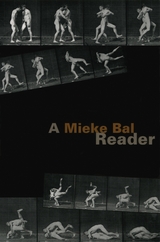 A Mieke Bal Reader
Mieke Bal
University of Chicago Press, 2006 Mieke Bal has had a significant impact on every field she has touched, from Old Testament scholarship and narratology to critical methods and visual culture. This brilliant and controversial intellectual invariably performs a high-wire act at the point where critical issues and methods intersect—or collide. She is deeply interested in the problems of cultural analysis across a range of disciplines. A Mieke Bal Reader brings together for the first time a representative collection of her work that distills her broad interests and areas of expertise.
This Reader is organized into four parts, reflecting the fields that Bal has most profoundly influenced: literary study, interdisciplinary methodology, visual analysis, and postmodern theology. The essays include some of Bal’s most characteristic and provocative work, capturing her at the top of her form. “Narration and Focalization,” for example, provides the groundwork for Bal’s ideas on narrative, while “Reading Art?” clearly outlines her concept of reading images. “Religious Canon and Literary Identity” reenvisions Bal’s own work at the intersection of theology and cultural analysis, while “Enfolding Feminism” argues for a new feminist rallying cry that is not a position but a metaphor. More than a dozen other essays round out the four sections, each of which is interdisciplinary in its own right: the section devoted to literature, for instance, ranges widely over psychoanalysis, theology, photography, and even autobiography.
A Mieke Bal Reader is the product of a capacious intellect and a sustained commitment to critical thinking. It will prove to be instructive, maddening, and groundbreaking—in short, all the hallmarks of intellectual inquiry at its best.
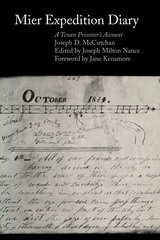 Mier Expedition Diary: A Texan Prisoner's Account
Joseph D. McCutchan
University of Texas Press, 1979 Few episodes in Texas history have excited more popular interest than the Mier Expedition of 1842. Nineteen-year-old Joseph D. McCutchan was among the 300 Texans who, without the cover of the Lone Star flag, launched their own disastrous invasion across the Rio Grande. McCutchan's diary provides a vivid account of his experience—the Texans' quick dispatch by Mexican troops at the town of Mier, the hardships of a forced march to Mexico City, over twenty months of imprisonment, and the journey back home after release. Although there are other firsthand accounts of the Mier Expedition, McCutchan was the only diarist who followed the Tampico route to Mexico City. His account documents a different experience than that of the main body of prisoners who marched to the national capital by way of Monterrey, Saltillo, and Agua Nueva. Among the last of the prisoners to be freed, McCutchan covers in his journal the whole period of confinement from December 26, 1842, to the final release on September 16, 1844. The McCutchan diary is set apart from other Mier accounts not only by the new information it provides, but also by Joseph Milton Nance's superb editing. Nance is an acknowledged authority on the hostilities between Texas and Mexico during the era of the Texas Republic. He has transcribed, edited, and annotated the diary with characteristic scholarship and painstaking attention to detail.
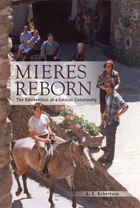 Mieres Reborn: The Reinvention of a Catalan Community
A. F. Robertson
University of Alabama Press, 2012 Mieres Reborn reveals how patient observation and an analysis of one small community have much to tell us about human progress more generally. Not long ago Mieres, a village in the eastern foothills of the Pyrenees, seemed destined to die. As in countless thousands of rural communities around the world, young people in Mieres over the years have moved to the towns and cities, leaving behind abandoned fields and meadows, derelict houses, and their aging and disconsolate parents and grandparents.
Close observation of this social microcosm over two decades reveals the capacity of ordinary people in a locality to reinvent themselves, reconstruct relationships with the wider world, and confront new threats to their collective survival. A. F. Robertson describes how the determination that Mieres should survive is most evident in a vigorous round of fiestas, fairs, and other public events in which natives, exiles, and newcomers work to create a lively sense of belonging. Since the 1980s, Mieres has been enlivened by a reverse flow of migrants from the cities, new settlers who have brought an infusion of youth to the community, devised new livelihoods, revitalized the village school, energized the native ”Mierencs,” and provided the impetus for a rediscovery of historical roots and political identity. The regeneration of life in the countryside, in part a reaction to urban expansion and decay, is a global phenomenon of increasing political, economic, and social significance.
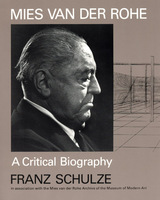 Mies van der Rohe: A Critical Biography
Franz Schulze
University of Chicago Press, 1985 Mies van der Rohe: A Critical Biography is a major rewriting and expansion of Franz Schulze’s acclaimed 1985 biography, the first full treatment of the master German-American modern architect. Coauthored with architect Edward Windhorst, this revised edition, three times the length of the original text, features extensive new research and commentary and draws on the best recent work of American and German scholars. The authors’ major new discoveries include the massive transcript of the early-1950s Farnsworth House court case, which discloses for the first time the facts about Mies’s epic battle with his client Edith Farnsworth. Giving voice to dozens of architects who knew and worked with (and sometimes against) Mies, this comprehensive biography tells the compelling story of how Mies and his students and followers created some of the most significant buildings of the twentieth century.
“Franz Schulze’s 1985 biography of Ludwig Mies van der Rohe has always been acknowledged as the most comprehensive and thoughtful biography of one of the key figures in twentieth-century architecture. This revised edition with significant new scholarship by its two authors will undoubtedly come to occupy the same position.”—Dietrich Neumann, Brown University
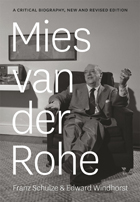 Mies van der Rohe: A Critical Biography, New and Revised Edition
Franz Schulze and Edward Windhorst
University of Chicago Press, 2012 Mies van der Rohe: A Critical Biography is a major rewriting and expansion of Franz Schulze’s acclaimed 1985 biography, the first full treatment of the master German-American modern architect. Coauthored with architect Edward Windhorst, this revised edition, three times the length of the original text, features extensive new research and commentary and draws on the best recent work of American and German scholars. The authors’ major new discoveries include the massive transcript of the early-1950s Farnsworth House court case, which discloses for the first time the facts about Mies’s epic battle with his client Edith Farnsworth. Giving voice to dozens of architects who knew and worked with (and sometimes against) Mies, this comprehensive biography tells the compelling story of how Mies and his students and followers created some of the most significant buildings of the twentieth century.
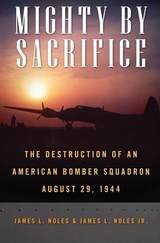 Mighty by Sacrifice: The Destruction of an American Bomber Squadron, August 29, 1944
James L. Noles and James L. Noles Jr.
University of Alabama Press, 2009 The high cost of the Allied air offensive during World War II.
On August 29, 1944, the 15th U.S. Army Air Force unleashed 500 bombers against oil and rail targets throughout central Europe. It dispatched the 20th Squadron of the 2nd Bombardment Group on what they regarded as an easy assignment: attack the Privoser Oil Refinery and associated railroad yards at Moravska Ostrava, Czechoslovakia. This "milk run" deteriorated into the bloodiest day in the 2nd Bombardment Group's history: not a single one of the 20th Squadron's B-17 Flying Fortress bombers returned from the mission. Forty airmen were killed, another 46 spent the rest of the war as POWs, and only four, with the aid of the OSS and anti-German partisans, and sympathetic Czech civilians managed to evade capture.
The ninety airmen on the mission to Moravska Ostrava provide a remarkable personal window into the Allies' Combined Bomber Offensive at its height during WWII. In a microcosm, their stories encapsulate how the U.S. Army Air Forces built, trained, and employed one of the mightiest war machines ever seen. Their stories also illustrate, however, the terrible cost in lives demanded by that same machine.
A Mighty Capital under Threat: The Environmental History of London, 1800-2000
Bill Luckin and Peter Thorsheim
University of Pittsburgh Press, 2020 Demographically, nineteenth-century London, or what Victorians called the “new Rome,” first equaled, then superseded its ancient ancestor. By the mid-eighteenth century, the British capital had already developed into a global city. Sustained by its enormous empire, between 1800 and the First World War London ballooned in population and land area. Nothing so vast had previously existed anywhere. A Mighty Capital under Threat investigates the environmental history of one of the world’s global cities and the largest city in the United Kingdom. Contributors cover the feeding of London, waste management, movement between the city’s numerous districts, and the making and shaping of the environmental sciences in the late nineteenth and early twentieth centuries.
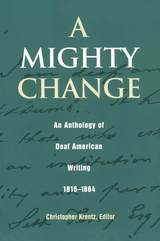 A Mighty Change: An Anthology of Deaf American Writing, 1816 - 1864
Christopher Krentz
Gallaudet University Press, 2000 “I need not tell you that a mighty change has taken place within the last half century, a change for the better,” Alphonso Johnson, the president of the Empire State Association of Deaf-Mutes, signed to hundreds of assembled deaf people in 1869. Johnson pointed to an important truth: the first half of the 19th century was a period of transformation for deaf Americans, a time that saw the rise of deaf education and the coalescence of the nation’s deaf community. This volume contains original writing by deaf people that both directed and reflected this remarkable period of change. It begins with works by Laurent Clerc, the deaf Frenchman who came to the United Sates in 1816 to help found the first permanent school for deaf students in the nation. Partially through is writing, Clerc impressed hearing Americans–most of whom had never met an educated deaf person before–with his intelligence and humanity. Other deaf writers shared their views with society through the democratic power of print. Included here are selections by James Nack, a deaf poet who surprised readers with his mellifluous verse; John Burnet, who published a book of original essays, fiction, and poetry; Edmund Booth, a frontiersman and journalist; John Carlin, who galvanized the drive for a national college for deaf people; Laura Redden, a high-achieving student who would go on to become an accomplished reporter; and Adele Jewel, a homeless deaf woman living in Michigan. The final sections contain documents related to deaf events and issues at mid-century: the grand reunion of alumni of the American Asylum for the Deaf in 1850; the dedication of the Thomas Hopkins Gallaudet monument in Hartford; the debate over the viability of a deaf state; and the triumphant inauguration of the National Deaf-Mute College (now Gallaudet University) in 1864, which in many ways culminated this period of change. Taken together, the individual texts in this remarkable collection provide a valuable historical record and a direct glimpse of the experiences, attitudes, and rhetoric of deaf Americans during this time of change.
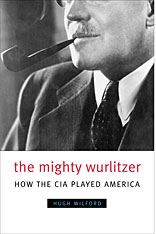 The Mighty Wurlitzer: How the CIA Played America
Hugh Wilford
Harvard University Press, 2008 In 1967 the magazine Ramparts ran an exposé revealing that the Central Intelligence Agency had been secretly funding and managing a wide range of citizen front groups intended to counter communist influence around the world. In addition to embarrassing prominent individuals caught up, wittingly or unwittingly, in the secret superpower struggle for hearts and minds, the revelations of 1967 were one of the worst operational disasters in the history of American intelligence and presaged a series of public scandals from which the CIA's reputation has arguably never recovered.
CIA official Frank Wisner called the operation his "mighty Wurlitzer," on which he could play any propaganda tune. In this illuminating book, Hugh Wilford provides the first comprehensive account of the clandestine relationship between the CIA and its front organizations. Using an unprecedented wealth of sources, he traces the rise and fall of America's Cold War front network from its origins in the 1940s to its Third World expansion during the 1950s and ultimate collapse in the 1960s.
Covering the intelligence officers who masterminded the CIA's fronts as well as the involved citizen groups--émigrés, labor, intellectuals, artists, students, women, Catholics, African Americans, and journalists--Wilford provides a surprising analysis of Cold War society that contains valuable lessons for our own age of global conflict.
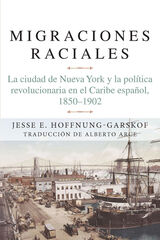 Migraciones raciales: La ciudad de Nueva York y la política revolucionaria en el Caribe hispánico
Jesse Hoffnung-Garskof
Michigan Publishing, 2019 Una historia apasionante de los migrantes afro-latinos que lucharon en el destierro para derrocar la monarquía colonial, acabar con la esclavitud, y asegurar la ciudadanía plena en su patria lejana.
A fines del siglo XIX, un grupo pequeño de cubanos y puertorriqueños de ascendencia africana se instaló en las viviendas segregadas de la ciudad de Nueva York. En una sociedad de instrucción y recreo que fundaron en Greenwich Village, estos primeros neoyorquinos afrolatinos aprendieron a ser poetas, periodistas y revolucionarios. Al mismo tiempo, estos individuos—liderados por Rafael Serra, tabaquero, escritor y político; Sotero Figueroa, tipógrafo y editor; y Gertrudis Heredia, una de las primeras mujeres afrodescendientes que estudió en la Clínica de Partos de la Universidad de La Habana--construyeron una red política y articularon un ideal de nacionalismo revolucionario centrado en los proyectos de justicia racial y social. Sus esfuerzos tuvieron una profunda influencia en los escritos del poeta y diplomático José Martí sobre raza y en su apuesta por el liderazgo entre los exiliados cubanos. Desde Nueva York, este grupo también luchó en años posteriores por crear espacios para la participación política negra en la República de Cuba.
En Migraciones raciales, Jesse Hoffnung-Garskof presenta un vívido retrato de estos migrantes revolucionarios quienes habían sido, en gran parte, olvidados, entretejiendo sus experiencias de “migrar siendo negros,” sus relaciones con líderes afro-americanos en la lucha por la igualdad racial en Estados Unidos, y su participación en el desarrollo de los movimientos políticos nacionalistas antillanos. Destacando el papel fundamental de los neoyorquinos afrolatinos en la historia de la política revolucionaria del caribe hispánico, Hoffnung-Garskof ofrece una nueva interpretación del movimiento separatista y de su idea de que Cuba podría convertirse en una nación sin divisiones raciales.
Un modelo de investigación transnacional y comparativa, Migraciones raciales revela las complejidades de las formaciones raciales dentro de las comunidades migrantes y el poder de pequeños grupos de inmigrantes para transformar sus sociedades de origen.
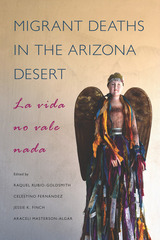 Migrant Deaths in the Arizona Desert: La vida no vale nada
Edited by Raquel Rubio-Goldsmith, Celestino Fernández, Jessie K. Finch, and Araceli Masterson-Algar
University of Arizona Press, 2016 Winner of the 2017 International Latino Book Award for Best Nonfiction – Multi-Author
Migrant Deaths in the Arizona Desert addresses the tragic results of government policies on immigration. The contributors consist of a multidisciplinary group who are dedicated to the thousands of men, women, and children who have lost their lives while crossing the desert in search of a better life. Each chapter in this important new volume seeks answers to migrant deaths, speaking to the complexity of this tragedy via a range of community and scholarly approaches.
The activists, artists, and scholars included in this volume confront migrant deaths and disappearances in the U.S.-Mexico borderlands as they reflect on the startling realities of death, migration, and public policy. Chapters touch on immigration and how it is studied, community responses to crisis, government policy, definitions of citizenship, and the role of the arts and human expression in response to state violence. Collectively the contributions throw a spotlight on the multivocal, transdisciplinary efforts to address the historical silence surrounding this human tragedy.
Despite numerous changes in the migration processes and growing attention to the problem, many people who attempt border crossings continue to disappear and die. This book offers a timely exploration of the ways that residents, scholars, activists, and artists are responding to this humanitarian crisis on their doorstep.
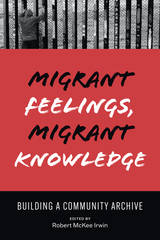 Migrant Feelings, Migrant Knowledge: Building a Community Archive
Robert McKee Irwin
University of Texas Press, 2022 The digital storytelling project Humanizing Deportation invites migrants to present their own stories in the world’s largest and most diverse archive of its kind. Since 2017, more than 300 community storytellers have created their own audiovisual testimonial narratives, sharing their personal experiences of migration and repatriation. With Migrant Feelings, Migrant Knowledge, the project’s coordinator, Robert Irwin, and other team members introduce the project’s innovative participatory methodology, drawing out key issues regarding the human consequences of contemporary migration control regimes, as well as insights from migrants whose world-making endeavors may challenge what we think we know about migration. In recent decades, migrants in North America have been treated with unprecedented harshness. Migrant Feelings, Migrant Knowledge outlines this recent history, revealing stories both of grave injustice and of seemingly unsurmountable obstacles overcome. As Irwin writes, “The greatest source of expertise on the human consequences of contemporary migration control are the migrants who have experienced them,” and their voices in this searing collection jump off the page and into our hearts and minds.
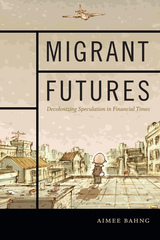 Migrant Futures: Decolonizing Speculation in Financial Times
Aimee Bahng
Duke University Press, 2018 In Migrant Futures Aimee Bahng traces the cultural production of futurity by juxtaposing the practices of speculative finance against those of speculative fiction. While financial speculation creates a future based on predicting and mitigating risk for wealthy elites, the wide range of speculative novels, comics, films, and narratives Bahng examines imagines alternative futures that envision the multiple possibilities that exist beyond capital’s reach. Whether presenting new spatial futures of the US-Mexico borderlands or inventing forms of kinship in Singapore in order to survive in an economy designed for the few, the varied texts Bahng analyzes illuminate how the futurity of speculative finance is experienced by those who find themselves mired in it. At the same time these displaced, undocumented, unbanked, and disavowed characters imagine alternative visions of the future that offer ways to bring forth new political economies, social structures, and subjectivities that exceed the framework of capitalism.
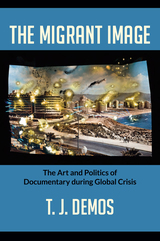 The Migrant Image: The Art and Politics of Documentary during Global Crisis
T. J. Demos
Duke University Press, 2013 In The Migrant Image T. J. Demos examines the ways contemporary artists have reinvented documentary practices in their representations of mobile lives: refugees, migrants, the stateless, and the politically dispossessed. He presents a sophisticated analysis of how artists from the United States, Europe, North Africa, and the Middle East depict the often ignored effects of globalization and the ways their works connect viewers to the lived experiences of political and economic crisis. Demos investigates the cinematic approaches Steve McQueen, the Otolith Group, and Hito Steyerl employ to blur the real and imaginary in their films confronting geopolitical conflicts between North and South. He analyzes how Emily Jacir and Ahlam Shibli use blurs, lacuna, and blind spots in their photographs, performances, and conceptual strategies to directly address the dire circumstances of dislocated Palestinian people. He discusses the disparate interventions of Walid Raad in Lebanon, Ursula Biemann in North Africa, and Ayreen Anastas and Rene Gabri in the United States, and traces how their works offer images of conflict as much as a conflict of images. Throughout Demos shows the ways these artists creatively propose new possibilities for a politics of equality, social justice, and historical consciousness from within the aesthetic domain.
 Migrant Marketplaces: Food and Italians in North and South America
Elizabeth Zanoni
University of Illinois Press, 2018 Italian immigrants to the United States and Argentina hungered for the products of home. Merchants imported Italian cheese, wine, olive oil, and other commodities to meet the demand. The two sides met in migrant marketplaces—urban spaces that linked a mobile people with mobile goods in both real and imagined ways. Elizabeth Zanoni provides a cutting-edge comparative look at Italian people and products on the move between 1880 and 1940. Concentrating on foodstuffs—a trade dominated by Italian entrepreneurs in New York and Buenos Aires—Zanoni reveals how consumption of these increasingly global imports affected consumer habits and identities and sparked changing and competing connections between gender, nationality, and ethnicity. Women in particular—by tradition tasked with buying and preparing food—had complex interactions that influenced both global trade and their community economies. Zanoni conveys the complicated and often fraught values and meanings that surrounded food, meals, and shopping. A groundbreaking interdisciplinary study, Migrant Marketplaces offers a new perspective on the linkages between migration and trade that helped define globalization in the late nineteenth and early twentieth centuries.
Migrant Penalties in Educational Achievement: Second-generation Immigrants in Western Europe
Camilla Borgna
Amsterdam University Press, 2017 The integration of second-generation immigrants has proved to be a major challenge for Europe in recent years. Though these people are born in their host nations, they often experience worse social and economic outcomes than other citizens. This volume focuses on one particular, important challenge: the less successful educational outcomes of second-generation migrants. Looking at data from seventeen European nations, Camilla Borgna shows that migrant penalties in educational achievement exist in each one-but that, unexpectedly, the penalties tend to be greater in countries in which socio-economic inequalities in education are generally more modest, a finding that should prompt reconsideration of a number of policy approaches.
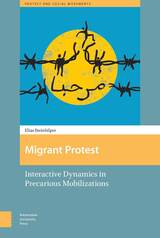 Migrant Protest: Interactive Dynamics in Precarious Mobilizations
Elias Steinhilper
Amsterdam University Press, 2021 Migrant protest has proliferated worldwide in the last two decades, explicitly posing questions of identity, rights, and equality in a globalized world. Nonetheless, such mobilizations are often considered anomalies in social movement studies, and political sociology more broadly, due to "weak interests" and a particularly disadvantageous position of "outsiders" to claim rights connected to citizenship. In an attempt to address this seeming paradox, Migrant Protest: Interactive Dynamics in Precarious Mobilizations explores the interactions and spaces shaping the emergence, trajectory, and fragmentation of migrant protest in unfavorable contexts of marginalization. Such a perspective unveils both the odds of precarious mobilizations and the ways they can be temporarily overcome. While adopting the encompassing terminology of "migrant," this book focuses on precarious migrants, including both asylum seekers and "illegalized" migrants.
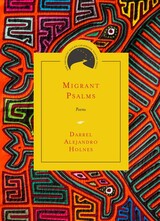 Migrant Psalms: Poems
Darrel Alejandro Holnes
Northwestern University Press, 2021 Migrant Psalms prays for a way to make sense of immigration to the United States—now that we realize the American Dream was always an impossible one. Both reverent and daring, this verse interrogates religion, race, class, family, and sexuality. Written as a call to action, the collection pulls together prayer, popular culture, and technology to tell a twenty‑first-century migrant story.
Migrant Psalms gives us a rare look inside a Panamanian experience of migration, describing the harsh realities of mothers, children, and teens who entered the United States—or tried to do so. Holnes’s poems find the universal through specificity; their exploration of expatriation, assimilation, and naturalization transcends the author’s personal experience to speak to what it means to be “other” anywhere.
The collection begins with “Kyrie,” a coming‑to‑America chronicle that spans three years in Texas, modeled after the liturgical Christian prayer Kyrie Eleison (Lord, have mercy). Other poems experiment with macaronic language and form to parallel shifts in the speaker’s status from immigrant to citizen, ending with “The 21st Century Poem,” which probes what’s “real” in today’s New York City. Through the speaker’s quest to become an American, this collection asks: Who are we becoming as individuals, as a society, as a nation, as a world? And is faith enough to enact change? Or is it just the first step?
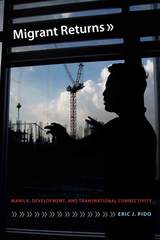 Migrant Returns: Manila, Development, and Transnational Connectivity
Eric J. Pido
Duke University Press, 2017 In Migrant Returns Eric J. Pido examines the complicated relationship among the Philippine economy, Manila’s urban development, and balikbayans—Filipino migrants visiting or returning to their homeland—to reconceptualize migration as a process of connectivity. Focusing on the experiences of balikbayans returning to Manila from California, Pido shows how Philippine economic and labor policies have created an economy reliant upon property speculation, financial remittances, and the affective labor of Filipinos living abroad. As the initial generation of post-1965 Filipino migrants begin to age, they are encouraged to retire in their homeland through various state-sponsored incentives. Yet, once they arrive, balikbayans often find themselves in the paradoxical position of being neither foreign nor local. They must reconcile their memories of their Filipino upbringing with American conceptions of security, sociality, modernity, and class as their homecoming comes into collision with the Philippines’ deep economic and social inequality. Tracing the complexity of balikbayan migration, Pido shows that rather than being a unidirectional event marking the end of a journey, migration is a multidirectional and continuous process that results in ambivalence, anxiety, relief, and difficulty.
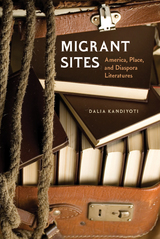 Migrant Sites: America, Place, and Diaspora Literatures
Dalia Kandiyoti
Dartmouth College Press, 2009 In Migrant Sites, Dalia Kandiyoti presents a compelling corrective to the traditional immigrant and melting pot story. This original and wide-ranging study embraces Jewish, European, and Chicana/o and Puerto Rican literatures of migration and diasporization through the literary works of Abraham Cahan, Willa Cather, Estela Portillo Trambley, Sandra Cisneros, Piri Thomas, and Ernesto Quiñonez. The author offers a transformed understanding of the ways in which the sense of place shapes migration imaginaries in U.S. writing. Place is a crucial category, one that along with race, class, and gender, has a profound impact in shaping migration and diaspora identities and storytelling. Migrant Sites highlights enclosure as a prominent sense of place and translocality as its counterpart in diaspora experiences created in fiction. Repositioning national literature as diaspora literature, the author shows that migrant legacies such as colonialism, empire, borders, containment, and enclosure are part of the American story and constitute the “diaspora sense of place.”
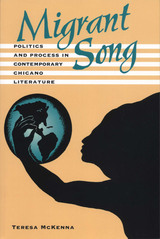 Migrant Song: Politics and Process in Contemporary Chicano Literature
By Teresa McKenna
University of Texas Press, 1996 Migration and continuity have shaped both the Chicano people and their oral and written literature. In this pathfinding study of Chicano literature, Teresa McKenna specifically explores how these works arise out of social, political, and psychological conflict and how the development of Chicano literature is inextricably embedded in this fact. McKenna begins by appraising the evolution of Chicano literature from oral forms—including the important role of the corrido in the development of Chicano poetry. In subsequent chapters she examines the works of Richard Rodriguez and Rolando Hinojosa. She also devotes a chapter to the development of the Chicana voice in Chicano literature. Her epilogue considers the parallel development of Chicano literary theory and discusses some possible directions for research. In McKenna's own words, "I believe that the future of this literature, as that of all literatures by people of color in the United States, rests largely on its being effectively introduced into the curricula at all levels, as well as its entrance into the critical consciousness of literary theory." This book will be an important step in that process.
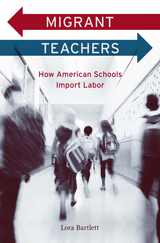 Migrant Teachers: How American Schools Import Labor
Lora Bartlett
Harvard University Press, 2013 Migrant Teachers investigates an overlooked trend in U.S. schools today: the growing reliance on teachers trained overseas. This timely study maps the shifting landscape of American education, as federal mandates require K-12 schools to employ qualified teachers or risk funding cuts. Lora Bartlett asserts that a narrowly technocratic view of teachers as subject specialists has spurred some public school districts to look abroad. When these districts use overseas-trained teachers as transient, migrant labor, the teachers have little opportunity to connect well with their students, thereby reducing the effectiveness of their teaching.
Approximately 90,000 teachers from the Philippines, India, and other countries came to the United States between 2002 and 2008. These educators were primarily recruited by inner-city school districts that have traditionally struggled to attract teachers. From the point of view of school administrators, these are excellent employees. They are well educated, experienced, and able to teach in areas like math, science, and special education where teachers are in short supply.
Despite the additional recruitment of qualified teachers, American schools are failing to reap the possible benefits of the global labor market. Bartlett shows how the framing of these recruited teachers as stopgap, low-status workers cultivates a high-turnover, low-investment workforce that undermines the conditions needed for good teaching and learning. Bartlett calls on schools to provide better support to both overseas-trained teachers and their American counterparts. Migrant Teachers asks us to consider carefully how we define teachers' work, distribute the teacher workforce, and organize schools for effective teaching and learning.
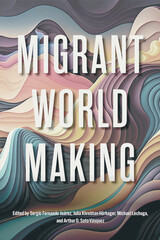 Migrant World Making
Sergio F Juárez
Michigan State University Press, 2023 For most migrants, developing communication strategies in host countries is vital for finding social connections, navigating the pressures of assimilation, and maintaining links to their original cultures. Migrant World Making explores this process of constructing a homeplace by creating a network of communication tools and strategies to connect with multiple communities. Since what it means to be a migrant differs from person to person, the contributors to this edited collection showcase numerous practices migrants adopt to communicate and connect with others as they forge their own identities in globalized yet highly nationalistic societies. With varying aspirations and motives for seeking new homes, migrants build communities by telling stories, engaging in social media activism, protesting, writing scholarly criticism, and using many other modes of communication. To match this variety, the transnational scholars represented here use a wide array of rhetorical, cultural, and communication methodologies and epistemologies to describe what the experience of migration means to those who have lived it.
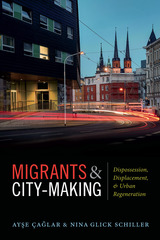 Migrants and City-Making: Dispossession, Displacement, and Urban Regeneration
Ayse Caglar and Nina Glick Schiller
Duke University Press, 2018 In Migrants and City-Making Ayşe Çağlar and Nina Glick Schiller trace the participation of migrants in the unequal networks of power that connect their lives to regional, national, and global institutions. Grounding their work in comparative ethnographies of three cities struggling to regain their former standing—Mardin, Turkey; Manchester, New Hampshire; and Halle/Saale, Germany—Çağlar and Glick Schiller challenge common assumptions that migrants exist on society’s periphery, threaten social cohesion, and require integration. Instead Çağlar and Glick Schiller explore their multifaceted role as city-makers, including their relationships to municipal officials, urban developers, political leaders, business owners, community organizers, and social justice movements. In each city Çağlar and Glick Schiller met with migrants from around the world; attended cultural events, meetings, and religious services; and patronized migrant-owned businesses, allowing them to gain insights into the ways in which migrants build social relationships with non-migrants and participate in urban restoration and development. In exploring the changing historical contingencies within which migrants live and work, Çağlar and Glick Schiller highlight how city-making invariably involves engaging with the far-reaching forces that dispossess people of their land, jobs, resources, neighborhoods, and hope.
Migrants and Markets: Perspectives from Economics and the Other Social Sciences
Edited by Holger Kolb and Henrik Egbert
Amsterdam University Press, 2008
Over the course of their interaction, economics and migration research have treated each other with mutual indifference. When migration research attempted to overstretch its bounds, economics reduced its analytical scope to those areas that originally seemed to belong to the genuine economic sphere. This volume considers eleven case studies that aim to overcome the artificial barrier between the two disciplines by applying the economic method to migratory phenomena, utilizing economic theories in order to explain migratory patterns, and regarding the structure and development of markets as crucial to the shaping of population stocks and the flow of migrants.
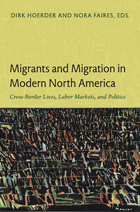 Migrants and Migration in Modern North America: Cross-Border Lives, Labor Markets, and Politics
Dirk Hoerder and Nora Faires, eds.
Duke University Press, 2011 Presenting an unprecedented, integrated view of migration in North America, this interdisciplinary collection of essays illuminates the movements of people within and between Canada, the Caribbean, Mexico, and the United States over the past two centuries. Several essays discuss recent migrations from Central America as well. In the introduction, Dirk Hoerder provides a sweeping historical overview of North American societies in the Atlantic world. He also develops and advocates what he and Nora Faires call “transcultural societal studies,” an interdisciplinary approach to migration studies that combines migration research across disciplines and at the local, regional, national, and transnational levels. The contributors examine the movements of diverse populations across North America in relation to changing cultural, political, and economic patterns. They describe the ways that people have fashioned cross-border lives, as well as the effects of shifting labor markets in facilitating or hindering cross-border movement, the place of formal and informal politics in migration processes and migrants’ lives, and the creation and transformation of borderlands economies, societies, and cultures. This collection offers rich new perspectives on migration in North America and on the broader study of migration history. Contributors. Jaime R. Aguila. Rodolfo Casillas-R., Nora Faires, Maria Cristina Garcia, Delia Gonzáles de Reufels, Brian Gratton, Susan E. Gray, James N. Gregory, John Mason Hart, Dirk Hoerder, Dan Killoren, Sarah-Jane (Saje) Mathieu, Catherine O’Donnell, Kerry Preibisch, Lara Putnam, Bruno Ramirez, Angelika Sauer, Melanie Shell-Weiss, Yukari Takai, Omar S. Valerio-Jiménez, Carlos G. Vélez-Ibáñez
 Migrants for Export: How the Philippine State Brokers Labor to the World
Robyn Magalit Rodriguez
University of Minnesota Press, 2010 Migrant workers from the Philippines are ubiquitous to global capitalism, with nearly 10 percent of the population employed in almost two hundred countries. In a visit to the United States in 2003, Philippine president Gloria Macapagal Arroyo even referred to herself as not only the head of state but also “the CEO of a global Philippine enterprise of eight million Filipinos who live and work abroad.” Robyn Magalit Rodriguez investigates how and why the Philippine government transformed itself into what she calls a labor brokerage state, which actively prepares, mobilizes, and regulates its citizens for migrant work abroad. Filipino men and women fill a range of jobs around the globe, including domestic work, construction, and engineering, and they have even worked in the Middle East to support U.S. military operations. At the same time, the state redefines nationalism to normalize its citizens to migration while fostering their ties to the Philippines. Those who leave the country to work and send their wages to their families at home are treated as new national heroes. Drawing on ethnographic research of the Philippine government’s migration bureaucracy, interviews, and archival work, Rodriguez presents a new analysis of neoliberal globalization and its consequences for nation-state formation.
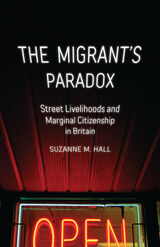 The Migrant's Paradox: Street Livelihoods and Marginal Citizenship in Britain
Suzanne M. Hall
University of Minnesota Press, 2021 Connects global migration with urban marginalization, exploring how “race” maps onto place across the globe, state, and street In this richly observed account of migrant shopkeepers in five cities in the United Kingdom, Suzanne Hall examines the brutal contradictions of sovereignty and capitalism in the formation of street livelihoods in the urban margins. Hall locates The Migrant’s Paradox on streets in the far-flung parts of de-industrialized peripheries, where jobs are hard to come by and the impacts of historic state underinvestment are deeply felt. Drawing on hundreds of in-person interviews on streets in Birmingham, Bristol, Leicester, London, and Manchester, Hall brings together histories of colonization with current forms of coloniality. Her six-year project spans the combined impacts of the 2008 financial crisis, austerity governance, punitive immigration laws and the Brexit Referendum, and processes of state-sanctioned regeneration. She incorporates the spaces of shops, conference halls, and planning offices to capture how official border talk overlaps with everyday formations of work and belonging on the street. Original and ambitious, Hall’s work complicates understandings of migrants, demonstrating how migrant journeys and claims to space illuminate the relations between global displacement and urban emplacement. In articulating “a citizenship of the edge” as an adaptive and audacious mode of belonging, she shows how sovereignty and inequality are maintained and refuted.
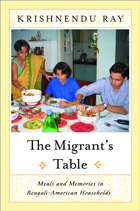 The Migrants Table: Meals And Memories In
Krishnendu Ray
Temple University Press, 2004 To most of us the food that we associate with home—our national and familial homes—is an essential part of our cultural heritage. No matter how open we become to other cuisines, we regard home-cooking as an intrinsic part of who we are. In this book, Krishnendu Ray examines the changing food habits of Bengali immigrants to the United States as they deal with the tension between their nostalgia for home and their desire to escape from its confinements.As Ray says, "This is a story about rice and water and the violations of geography by history." Focusing on mundane matters of immigrant life (for example, what to eat for breakfast in America), he connects food choices to issues of globalization and modernization. By showing how Bengali immigrants decide what defines their ethnic cuisine and differentiates it from American food, he reminds us that such boundaries are uncertain for all newcomers. By drawing on literary sources, family menus and recipes for traditional dishes, interviews with Bengali household members, and his own experience as an immigrant, Ray presents a vivid picture of immigrants grappling with the grave and immediate problem of defining themselves in their home away from home.
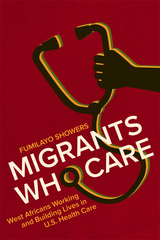 Migrants Who Care: West Africans Working and Building Lives in U.S. Health Care
Fumilayo Showers
Rutgers University Press, 2023 As the U.S. population ages and as health care needs become more complex, demand for paid care workers in home and institutional settings has increased. This book draws attention to the reserve of immigrant labor that is called on to meet this need. Migrants Who Care tells the little-known story of a group of English-speaking West African immigrants who have become central to the U.S. health and long-term care systems. With high human capital and middle-class pre-migration backgrounds, these immigrants - hailing from countries as diverse as Cameroon, Sierra Leone, Ghana, Nigeria, and Liberia - encounter blocked opportunities in the U.S. labor market. They then work in the United States, as home health aides, certified nursing assistants, qualified disability support professionals, and licensed practical and registered nurses.
This book reveals the global, political, social, and economic factors that have facilitated the entry of West African women and men into the health care labor force (home and institutional care for older adults and individuals with physical and intellectual disabilities; and skilled nursing). It highlights these immigrants’ role as labor brokers who tap into their local ethnic and immigrant communities to channel co-ethnics to meet this labor demand. It illustrates how West African care workers understand their work across various occupational settings and segments in the health care industry. This book reveals the transformative processes migrants undergo as they become produced, repackaged, and deployed as health care workers after migration.
Ultimately, this book tells the very real and human story of an immigrant group surmounting tremendous obstacles to carve out a labor market niche in health care, providing some of the most essential and intimate aspects of care labor to the most vulnerable members of society.
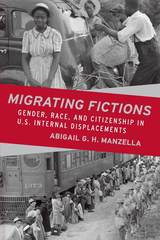 Migrating Fictions: Gender, Race, and Citizenship in U.S. Internal Displacements
Abigail G. H. Manzella
Ohio State University Press, 2018 Winner, 2021 Society for the Study of American Women Writers Book Award
Winner, 2021 CCCC Outstanding Book Award
Migrating Fictions analyzes the role of race, gender, and citizenship in the major internal displacements of the 20th century in history and in narrative. Surveying the particular tactics employed by the United States during the Great Migration, the Dust Bowl, the Japanese American incarceration, and the migrant labor of the Southwest, Abigail G. H. Manzella reveals how the country’s past is imbued with governmentally (en)forced movements that diminished access to full citizenship rights for the laboring class, people of color, and women.
This work is the first book-length study to examine all of these movements together along with their literature, including Zora Neale Hurston’s Their Eyes Were Watching God, Sanora Babb’s Whose Names Are Unknown, Julie Otsuka’s When the Emperor Was Divine, Helena María Viramontes’s Under the Feet of Jesus, and Jesmyn Ward’s Salvage the Bones. Manzella shows how the United States’ history of spatial colonization within its own borders extends beyond isolated incidents into a pattern based on ideology about nation-building, citizenship, and labor. This book seeks to theorize a Thirdspace, an alternate location for social justice that acknowledges the precarity of the internally displaced person.
Migration and Citizenship: Legal Status, Rights and Political Participation
Edited by Rainer Bauböck
Amsterdam University Press, 2006 As Europe struggles to integrate growing numbers of immigrants into society, citizenship is frequently held out as both a goal of and a tool for promoting that integration. But by studying the issue from the perspective of migration, Migration and Citizenship makes clear that citizenship carries important legal and political status that goes beyond such efforts at social integration. Highlighting the ways in which the difference in legal status that citizenship confers enables governments to set boundaries between citizens and non-citizens in terms of rights and political participation, this volume summarizes current theories and research.
Migration and Diaspora: Exegetical Voices of Women in Northeast Asian Countries
Hisako Kinukawa
SBL Press, 2014 Engage and explore readings from a multi-religious, globalized, multicultural region
The papers in this collection were presented at the third meeting of the Society of Asian Biblical Studies held at the Sabah Theological Seminary, Malaysia in 2012. The essays represent the work of women/feminist scholars in biblical hermeneutics in this region who have raised questions against traditional, male-centered interpretations, offering distinct perspectives based on their experiences of pain, subjugation, and a forced sacrificial philosophy of life.
Features:
- Articles focused on finding justice for women through dialogue with biblical texts
- Reflections on migration, diaspora, displacement, discrimination, and conditions generated by poverty and systemic oppression
- Five essays from women in China, Japan, and Korea
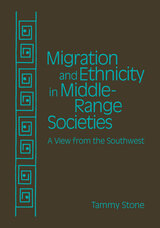 Migration and Ethnicity in Middle Range Societies: A View from the Southwest
Tammy Stone
University of Utah Press, 2015 Author Tammy Stone focuses on a number of general deliberations on the archaeology of middle-range society and the prehistory of the American Southwest. This includes the complex dynamics of migration, identity, ethnic interaction, and the ability of archaeologists to identify these patterns in the archaeological record. The integration and ultimate expulsion of a group of Kayenta Anasazi at Point of Pines Pueblo in the Mogollon Highlands of east-central Arizona provides a case study and location where these themes played out. Stone uses a detailed architectural analysis of the pueblo to attain a nuanced and dynamic understanding of migration from the perspective of both the Kayenta migrants and their Mogollon hosts. By examining the choices that individuals, families, and small groups made about identity and alliance from the perspective of both the migrants and host community—the latter being an aspect often missing from analyses of migration—this volume provides never-before-published data on Point of Pines Pueblo and contributes considerably to the study of community dynamics at large.
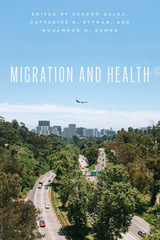 Migration and Health
Edited by Sandro Galea, Catherine K. Ettman, and Muhammad H. Zaman
University of Chicago Press, 2022 A new introduction to a timeless dynamic: how the movement of humans affects health everywhere.
International migrants compose more than three percent of the world’s population, and internal migrants—those migrating within countries—are more than triple that number. Population migration has long been, and remains today, one of the central demographic shifts shaping the world around us. The world’s history—and its health—is shaped and colored by stories of migration patterns, the policies and political events that drive these movements, and narratives of individual migrants.
Migration and Health offers the most expansive framework to date for understanding and reckoning with human migration’s implications for public health and its determinants. It interrogates this complex relationship by considering not only the welfare of migrants, but also that of the source, destination, and ensuing-generation populations. The result is an elevated, interdisciplinary resource for understanding what is known—and the considerable territory of what is not known—at an intersection that promises to grow in importance and influence as the century unfolds.
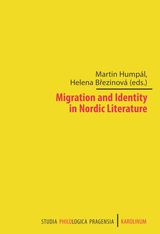 Migration and Identity in Nordic Literature
Edited by Martin Humpál and Helena Brezinová
Karolinum Press, 2022 An examination of representations of human migration in three centuries of Northern European literature.
Migration is a frequent topic of many debates nowadays, whether it concerns refugees from war-torn areas or the economic pros and cons of the mobility of multinational corporations and their employees. Yet such migration has always been a part of the human experience, and its dimensions—with its shifting nature, manifestations, and consequences—were often greater than we can imagine today.
In this book, ten scholars from Czechia, Denmark, the Netherlands, Norway, Poland, and Sweden focus on how migration has manifested itself in literature and culture through the nineteenth, twentieth, and early twenty-first centuries in Denmark, Norway, Sweden, Finland, and Iceland. Examining the theme of migration as it relates to questions of identity, both national and individual, the authors argue that migration almost always leads to a disturbance of identity and creates a potential for conflicts between individuals and larger groups. The book digs deep into such cases of disturbance, disruption, and hybridization of identity as they are represented in three centuries of literary works from the European North.
Migration and Integration in Europe, Southeast Asia, and Australia: A Comparative Perspective
Edited by Juliet Pietsch and Marshall Clark
Amsterdam University Press, 2015 This volume brings together a group of scholars from a wide range of disciplines to address crucial questions of migration flows and integration in Europe, Southeast Asia, and Australia. Comparative analysis of the three regions and their differing approaches and outcomes yields important insights for each region, as well as provokes new questions and suggests future avenues of study.
Migration and Irregular Work in Austria: A Case Study of the Structure and Dynamics of Irregular Foreign Employment in Europe at the Beginning of the 21st Century
Michael Jandl, Christina Hollomey, Sandra Gendera, Anna Stepien, and Veronika Bi
Amsterdam University Press, 2008
Migration and Irregular Work in Austria offers a fresh new perspective on irregular migrant work by making use of in-depth interviews with migrants themselves. The authors challenge our ability to divide the world of foreign employment into legal and illegal work, and instead evaluate the new manifestations of “irregular migrant work” that have evolved in the wake of EU expansion. Arguing that this work is based on both supply and demand—and thus deeply ingrained in the structure of our advanced economies—this volume should fill a large gap in migration and labor market research.
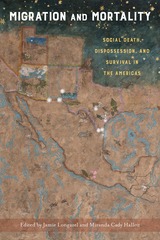 Migration and Mortality: Social Death, Dispossession, and Survival in the Americas
Edited by Jamie Longazel and Miranda Cady Hallett
Temple University Press, 2021 Death threatens migrants physically during perilous border crossings between Central and North America, but many also experience legal, social, and economic mortality. Rooted in histories of colonialism and conquest, exclusionary policies and practices deliberately take aim at racialized, dispossessed people in transit. Once in the new land, migrants endure a web of systems across every facet of their world—work, home, healthcare, culture, justice—that strips them of their personhood, denies them resources, and creates additional obstacles that deprive them of their ability to live fully. As laws and policies create ripe conditions for the further extraction of money, resources, and labor power from the dispossessed, the contributors to this vibrant anthology, Migration and Mortality, examine restrictive immigration policies and the broader capitalist systems of exploitation and inequality while highlighting the power of migrants’ collective resistance and resilience. The case studies in this timely collection explore border deaths, detention economies, asylum seeking, as well as the public health and mental health of migrants. Ultimately, these examples of oppression and survival contribute to understanding broader movements for life and justice in the Americas.
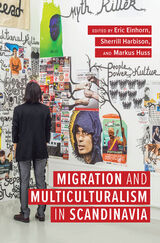 Migration and Multiculturalism in Scandinavia
Edited by Eric Einhorn, Sherrill Harbison, and Markus Huss
University of Wisconsin Press, 2022 Scandinavian societies have historically, and problematically, been understood as homogeneous, when in fact they have a long history of ethnic and cultural pluralism due to colonialism and territorial conquest. After World War II, Sweden, Denmark, and Norway all became destinations for an increasingly diverse stream of migrants and asylum seekers from war-torn countries around the globe, culminating in the 2015–16 “refugee crisis.” This multidisciplinary volume opens with an overview of how the three countries’ current immigration policies developed and evolved, then expands to address how we might understand the current contexts and the social realities of immigration and diversity on the ground.
Drawing from personal experiences and theoretical perspectives in such varied fields as sociology, political science, literature, and media studies, nineteen scholars assess recent shifts in Scandinavian societies and how they intertwine with broader transformations in Europe and beyond. Chapters explore a variety of topics, including themes of belonging and identity in Norway, the experiences and activism of the Nordic countries’ Indigenous populations, and parallels between the racist far-right resurgence in Sweden and the United States.
Contributors: Ellen A. Ahlness, Julie K. Allen, Grete Brochmann, Eric Einhorn, Sherrill Harbison, Anne Heith, Markus Huss, Peter Leonard, Barbara Mattsson, Kelly McKowen, Andreas Önnerfors, Elisabeth Oxfeldt, Tony Sandset, Carly Elizabeth Schall, Ryan Thomas Skinner, Admir Skodo, Benjamin R. Teitelbaum, Sayaka Osanami Törngren, Ethelene Whitmire
 Migration and Mythmaking in Anglo-Saxon England
Nicholas Howe
University of Notre Dame Press, 2001 In this original and revisionist interpretation of Anglo-Saxon England, Nicholas Howe proposes that the Anglo-Saxons fashioned a myth out of the fifth-century migration of their Germanic ancestors to Britain. Through the retelling of this story, the Anglo-Saxons ordered their complex history and identified their destiny as a people. Howe traces the migration myth throughout the literature of the Anglo-Saxon period, in poems, sermons, letters, and histories from the sixth to the eleventh centuries.
"Howe's book is of value not only to scholars of medieval English literature but highly suitable for mythographers, cultural historians, anthropologists, and theologians. Documentation is thorough, and most footnotes are annotated; the bibliography is exhaustive. This study complements Howe's previous scholarship and assumes, by its authority and integrity of presentation, the status of a standard in contemporary scholarship relevant to Anglo-Saxon England."--Renaissance and Reformation
Nicholas Howe is professor of English at the Ohio State University and director of the Center for Medieval and Renaissance Studies. In addition to many published articles and essays, Howe is the author of The Old English Catalogue Poems (1985), editor of Irving Howe's Critic's Notebook (1995), and co-editor of Words and Works ,(1998).
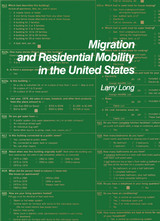 Migration and Residential Mobility in the United States
Larry Long
Russell Sage Foundation, 1988 Americans have a reputation for moving often and far, for being committed to careers or lifestyles, not place. Now, with curtailed fertility, residential mobility plays an even more important role in the composition of local populations—and by extension, helps shape local and national economic trends, social service requirements, and political constituencies. In Migration and Residential Mobility in the United States, Larry Long integrates diverse census and survey data and draws on many academic disciplines to offer a uniquely comprehensive view of internal migration patterns since the 1930s. Long describes an American population that lives up to its reputation for high mobility, but he also reports a surprising recent decline in interstate migration and an unexpected fluctuation in the migration balance toward nonmetropolitan areas. He provides unprecedented insight into reasons for moving and explores return and repeat migration, regional balance, changing migration flows of blacks and whites, and the policy implications of movement by low-income populations. How often, how far, and why people move are important considerations in characterizing the lifestyles of individuals and the nature of social institutions. This volume illuminates the extent and direction, as well as the causes and consequences, of population turnover in the United States. A Volume in the Russell Sage Foundation Census Series
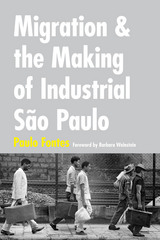 Migration and the Making of Industrial São Paulo
Paulo Fontes
Duke University Press, 2016 Published in 2008 and winner of the 2011 Thomas E. Skidmore Prize, Paulo Fontes's Migration and the Making of Industrial São Paulo is a detailed social history of São Paulo's extraordinary urban and industrial expansion. Fontes focuses on those migrants who settled in the suburb of São Miguel Paulista, which grew from 7,000 residents in the 1940s to over 140,000 two decades later. Reconstructing these migrants' everyday lives within a broad social context, Fontes examines the economic conditions that prompted their migration, their creation of an integrated identity and community, and their efforts to gain worker rights. Fontes challenges the stereotypes of Northeasterners as culturally backward, uneducated, violent, and unreliable, instead seeing them as a resourceful population with considerable social and political resolve. Fontes's investigations into Northeastern life in São Miguel Paulista yield a fresh understanding of São Paulo's incredible and difficult growth while outlining how a marginalized population exercised its political agency.
 Migration and the Origins of the English Atlantic World
Alison Games
Harvard University Press, 1999 England's seventeenth-century colonial empire in North America and the Caribbean was created by migration. The quickening pace of this essential migration is captured in the London port register of 1635, the largest extant port register for any single year in the colonial period and unique in its record of migration to America and to the European continent. Alison Games analyzes the 7,500 people who traveled from London in that year, recreating individual careers, exploring colonial societies at a time of emerging viability, and delineating a world sustained and defined by migration.
The colonial travelers were bound for the major regions of English settlement--New England, the Chesapeake, the West Indies, and Bermuda--and included ministers, governors, soldiers, planters, merchants, and members of some major colonial dynasties--Winthrops, Saltonstalls, and Eliots. Many of these passengers were indentured servants. Games shows that however much they tried, the travelers from London were unable to recreate England in their overseas outposts. They dwelled in chaotic, precarious, and hybrid societies where New World exigencies overpowered the force of custom. Patterns of repeat and return migration cemented these inchoate colonial outposts into a larger Atlantic community. Together, the migrants' stories offer a new social history of the seventeenth century. For the origins and integration of the English Atlantic world, Games illustrates the primary importance of the first half of the seventeenth century.
 Migration: Changing the World
Guy Arnold
Pluto Press, 2011 Constant migration is a worldwide phenomenon that creates sharp divisions between those who accept the need for migrants and welcome the contributions they make and those who oppose them on xenophobic grounds. Guy Arnold provides a comprehensive survey of the consequences of migration.
Arnold studies both the massive internal migrations in China and India that drive economic development and the influx of cheap labour into the advanced economies of the USA and EU. He shows that migrants are essential to advanced countries, filling skills gaps and bolstering ageing and static populations. He argues that the constant flow of people in all directions should be welcomed as a positive assault upon outdated, narrow nationalism.
Packed with statistics that support the argument that migration is a force for positive change, Arnold's analysis will be an excellent resource for journalists, policy makers and students of sociology, human geography and anthropology.
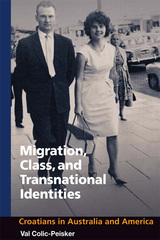 Migration, Class and Transnational Identities: Croations in Australia and America
Val Colic-Pelsker
University of Illinois Press, 2007 Val Colic-Peisker harnesses concepts and theories from sociology, anthropology, and political science to compare the vastly different experiences of two Croatian immigrant cohorts in the city of Perth, Western Australia. The populations explored represent an earlier group of working-class migrants arriving from communist Yugoslavia from the 1950s to 1970s and a later group of urban professionals arriving in the 1980s and 1990s as 'independent' or skills-based migrants. This latter group integrated into professional ranks but also used their Australian experience as a stepping stone in becoming part of a highly mobile global professional middle class. Employing a refined theoretical analysis, this rich ethnography challenges the domination of the ethnic perspective in migration studies and the idea of ethnic community itself. It emphasizes the importance of class, focusing on the intersection of class, ethnicity, and gender in the process of migration, migrant incorporation, and transnationalism. In theorizing the connection of the two migrant cohorts with their native Croatia, the study introduces concepts of "ethnic" and "cosmopolitan" transnationalism as two distinctive experiences mediated by class.
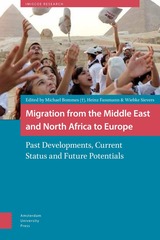 Migration from the Middle East and North Africa to Europe: Past Developments, Current Status and Future Potentials
Edited by Michael Bommes, Heinz Fassmann, and Wiebke Sievers
Amsterdam University Press, 2014 One of the most important challenges concerning the future of the European Union is the demographic reproduction of the European population. Decreasing birth-rates and the retirement of the baby boomers will dramatically reduce the labour force in the EU, which will entail not only a lack of manpower but also lower contributions to European social systems. It seems clear that the EU will have to counterbalance this population decrease by immigration in the coming years. Migration Between the Middle East, North Africa and Europe takes this challenge as a point of departure for analysing the MENA region, in particular Morocco, Egypt and Turkey, as a possible source of future migration to the European Union. At the same time, it illustrates the uncertainties implied in such calculations, especially at a time of radical political changes, such as those brought about by the Arab Uprising.
Migration in the Medieval Mediterranean
Sarah Davis-Secord
Arc Humanities Press, 2021 Migration in the Medieval Mediterranean argues that the cross-Mediterranean movement of peoples was a central aspect of the medieval world. Medieval people migrated in search of safety after regime change, secure life amongst coreligionists, and prosperous careers. This kind of travel between Muslim and Christian regions demonstrates the mutual influences, interconnections, and communications linking them, surpassing the differences between the two civilizations.
Migration, Mill Work, and Portuguese Communities in New England
Edited by Cristiana Bastos, Bela Feldman-Bianco, and Miguel Moniz
Tagus Press, 2024 A century after the publication of the controversial Two Portuguese Communities in New England, Migration and Mill Work brings together analytical research essays, personal testimonies, poems, fiction, photos and drawings on Portuguese and Portuguese-Americans in their predicaments, struggles, encounters and achievements experienced under the pressures of upwards mobility, racialized tensions, politics of assimilation or multiculturalism, and labor and ethnic revival movements.
 Migration Miracle: Faith, Hope, and Meaning on the Undocumented Journey
Jacqueline Maria Hagan
Harvard University Press, 2012 Since the arrival of the Puritans, various religious groups, including Quakers, Jews, Catholics, and Protestant sects, have migrated to the United States. The role of religion in motivating their migration and shaping their settlement experiences has been well documented. What has not been recorded is the contemporary story of how migrants from Mexico and Central America rely on religion—their clergy, faith, cultural expressions, and everyday religious practices—to endure the undocumented journey.
At a time when anti-immigrant feeling is rising among the American public and when immigration is often cast in economic or deviant terms, Migration Miracle humanizes the controversy by exploring the harsh realities of the migrants’ desperate journeys. Drawing on over 300 interviews with men, women, and children, Jacqueline Hagan focuses on an unexplored dimension of the migration undertaking—the role of religion and faith in surviving the journey. Each year hundreds of thousands of migrants risk their lives to cross the border into the United States, yet until now, few scholars have sought migrants’ own accounts of their experiences.
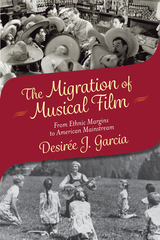 The Migration of Musical Film: From Ethnic Margins to American Mainstream
Garcia, Desirée J
Rutgers University Press, 2014 Movie musicals are among the most quintessentially American art forms, often celebrating mobility, self-expression, and the pursuit of one’s dreams. But like America itself, the Hollywood musical draws from many distinct ethnic traditions. In this illuminating new study, Desirée J. Garcia examines the lesser-known folk musicals from early African American, Yiddish, and Mexican filmmakers, revealing how these were essential ingredients in the melting pot of the Hollywood musical.
The Migration of Musical Film shows how the folk musical was rooted in the challenges faced by immigrants and migrants who had to adapt to new environments, balancing American individualism with family values and cultural traditions. Uncovering fresh material from film industry archives, Garcia considers how folk musicals were initially marginal productions, designed to appeal to specific minority audiences, and yet introduced themes that were gradually assimilated into the Hollywood mainstream.
No other book offers a comparative historical study of the folk musical, from the first sound films in the 1920s to the genre’s resurgence in the 1970s and 1980s. Using an illustrative rather than comprehensive approach, Garcia focuses on significant moments in the sub-genre and rarely studied films such as Allá en el Rancho Grande along with familiar favorites that drew inspiration from earlier folk musicals—everything from The Wizard of Oz to Zoot Suit. If you think of movie musicals simply as escapist mainstream entertainment, The Migration of Musical Film is sure to leave you singing a different tune.
Migration Policymaking in Europe: The Dynamics of Actors and Contexts in Past and Present
Edited by Giovanna Zincone, Rinus Penninx, and Maren Borkert
Amsterdam University Press, 2012
The pieces in this volume offer fresh approaches to a variety of debates over migration policy. The authors of these essays explore migration policymaking in ten European countries, looking at the way social scientists and politicians form and implement these policies. Migration Policymaking in Europe contains original insights and in-depth comparative analyses drawing on a variety of empirical evidence. By placing these policies in the context of historical relationships between nations, the editors of this book have put forth a vital new portrait of the principles guiding migration in Europe.
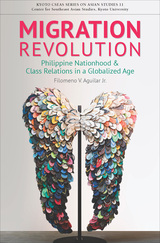 Migration Revolution: Philippine Nationhood and Class Relations in a Globalized Age
Filomeno V. Aguilar Jr.
National University of Singapore Press, 2014 Since the 1960s, overseas migration has become a major factor in the economy of the Philippines. It has also profoundly influenced the sense of nationhood of both migrants and nonmigrants. Migrant workers learned to view their home country as part of a plural world of nations, and they shaped a new sort of Filipino identity while appropriating the modernity of the outside world, where at least for a while they operated as insiders.
The global nomadism of Filipino workers brought about some fundamental reorientations. It revolutionized Philippine society, reignited a sense of nationhood, imposed new demands on the state, reconfigured the class structure, and transnationalized class and other social relations, even as it deterritorialized the state and impacted the destinations of migrant workers.
Philippine foreign policy now takes surprising turns in consideration of migrant workers and Filipinos living abroad. Many tertiary education institutions aim deliberately at the overseas employability of local graduates. And the “Fil-foreign” offspring of unions with partners from other nationalities add a new inflection to Filipino identity.
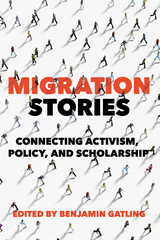 Migration Stories: Connecting Activism, Policy, and Scholarship
Edited by Benjamin Gatling
University of Illinois Press, 2025 Migrants’ and refugees’ stories have become an essential part of the public debate around immigration. Benjamin Gatling edits interdisciplinary essays that bring together the distinct perspectives of researchers, activists, and policymakers to emphasize how these often-siloed communities can use stories as social science data and advocacy tools. Ranging from oral history projects to the asylum process to calls for decolonial justice, the contributors’ analyses illuminate how migrants’ and refugees’ personal narratives influence both perceptions and policies. Their merger of perspectives provides a nuanced understanding of migration and emphasizes the importance of how storytelling can foster empathy, challenge stereotypes, and drive social change. At the same time, the essays center migrants’ and refugees’ voices within public debates and in work done to humanize the reality they face. Original and multifaceted, Migration Stories provides a vital addition to how we study and frame immigration.
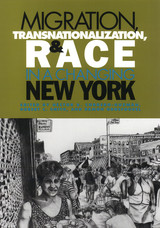 Migration, Transnationalization & Race: In A Changing New York
Hector Cordero-Guzman
Temple University Press, 2001 When you think of American immigration, what images come to mind? Ellis Island. East Side tenements. Pushcarts on Eighth Avenue. Little Italy. Chinatown. El Barrio. New York City has always been central to the immigrant experience in the United States. In the last three decades, the volume of immigration has increased as has the diversity of immigrant origins and experiences. Contemporary immigration conjures up old images but also some new ones: the sweatshops and ethnic neighborhoods are still there, but so are cell phones, faxes, e-mails, and the more intense and multilayered involvement ofimmigrants in the social, economic, and political life of both home and host societies.
In this ambitious book, nineteen scholars from a broad range of disciplines bring our understanding of New York's immigrant communities up to date by exploring the interaction between economic globalization and transnationalization, demographic change, and the evolving racial, ethnic, gender dynamics in the City. Urban and suburban, Asian, European, Latin American, and Caribbean, men and women and children—the essays here analyze the complex forces that shape the contemporary immigrant experience in New York City and the links between immigrant communities in New York and their countries of origin.
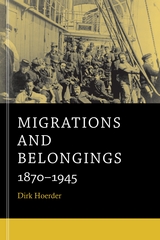 Migrations and Belongings: 1870–1945
Dirk Hoerder
Harvard University Press, 2014 Toward the end of the nineteenth century, new railroads, ports, and steamships enabled people to travel faster and in greater numbers than ever before. Migrations and Belongings traces burgeoning population movements across several continents from 1870 to the end of World War II. This study explains the complex variables involved in global migrations and the processes of acculturation by which “belonging” takes shape.
Dirk Hoerder emphasizes the migration systems that emerge when population clusters move between regions over long periods of time. Eschewing a Eurocentric perspective, he identifies five major systems in different parts of the world where men and women left areas with labor surpluses and swelled regions of urban and industrial growth. These include African slave migration from the 1440s to the 1870s; migration of free and indentured men and women across Asia; Russo-Siberian migration across parts of Asia, North America, and Europe; a North China–Manchurian migration; and an Atlantic system connecting Europe and the Americas. Migrations within and among regions and empires both encouraged population mixing and produced new social stratifications.
Questioning the “container” view of states, Hoerder considers instead the dynamic effects of departure, transit, and arrival. Migration, he shows, is both a critique of unsatisfactory conditions in one society and a contribution of human capital to another.
Migratory Sound: Poems
Sara Lupita Olivares
University of Arkansas Press, 2020 Sara Lupita Olivares’s Migratory Sound, winner of the 2020 CantoMundo Poetry Prize, looks back to generational narratives of Mexican American migration, examining linguistic and geographic boundaries as it journeys north along routes of seasonal fieldwork and factory labor. “Whether enacting a bird migration, or the uprooting of people relocating north, or the private movement from sleep to alert vigilance,” series editors Carolina Ebeid and Carmen Giménez Smith observe, “Olivares’s stark poetry concerns the precarious idea of place and its underlying ‘unplace.’ She makes evident how every place bears a relationship with an elsewhere, an over there sometimes situated underneath.”
Miguel Mármol
Roque Dalton
Northwestern University Press, 1995 Miguel Mármol is the testimony of a revolutionary, as recorded by Salvadoran writer, Roque Dalton, which documents the historical and political events of El Salvador through the first decades of the 20th century. This Latin American classic describes the growth and development of the workers' movement and the communist party in El Salvador and Guatemala, and contains Mármol's impressions of post-revolutionary Russia in the twenties, describing in vivid detail the brutality and repression of the Martínez dictatorship and the reemergence of the workers' movement after Martínez was ousted. It also gives a broad and clear picture of the lives of the ordinary peasant and worker in Central America, their sufferings, their hopes and their struggles.
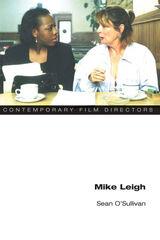 Mike Leigh
Sean O'Sullivan
University of Illinois Press, 2011 In this much needed examination of Mike Leigh, Sean O'Sullivan reclaims the British director as a practicing theorist--a filmmaker deeply invested in cinema's formal, conceptual, and narrative dimensions. In contrast with Leigh's prevailing reputation as a straightforward crafter of social realist movies, O'Sullivan illuminates the visual tropes and storytelling investigations that position Leigh as an experimental filmmaker who uses the art and artifice of cinema to frame tales of the everyday and the extraordinary alike. O'Sullivan challenges the prevailing characterizations of Leigh's cinema by detailing the complicated constructions of his realism, positing his films not as transparent records of life but as aesthetic transformations of it. Concentrating on the most recent two decades of Leigh's career, the study examines how Naked, Secrets and Lies, Topsy-Turvy, Vera Drake, and other films engage narrative convergence and narrative diffusion, the tension between character and plot, the interplay of coincidence and design, cinema's relationship to other systems of representation, and the filmic rendering of the human figure. The book also spotlights such earlier, less-discussed works as Four Days in July and The Short and Curlies, illustrating the recurring visual and storytelling concerns of Leigh's cinema. With a detailed filmography, this volume also includes key selections from O'Sullivan's several interviews with Leigh.
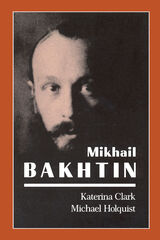 Mikhail Bakhtin
Katerina Clark and Michael Holquist
Harvard University Press, 1984 In such diverse fields as semiotics, literary theory, social theory, linguistics, psychology, and anthropology, Mikhail Bakhtin’s importance is increasingly recognized. His posthumous fame comes in striking contrast to his obscurity during his lifetime (1895–1975), much of it spent as a semi-invalid in a succession of provincial towns. He received no public recognition, in the Soviet Union or abroad, until the last dozen years of his long life—not surprisingly, given the historical circumstances. His books on Freudianism (1927), on Formalism (1928), and on Marxism and the philosophy of language (1929) were published as the work of others, as were a number of important essays. His study of Dostoevsky appeared under his own name but only after his arrest and sentence to exile, and it quickly disappeared from sight. Some manuscripts were never published; one was used by Bakhtin for cigarette paper. His book on Rabelais, completed in 1940, remained unpublished for twenty-five years—until, in a less repressive political climate, friends had succeeded in negotiating a reissue of the book on Dostoevsky.
The Rabelais book, when translated, caused a stir among folklorists, anthropologists, and social historians, with its theory of carnival and of ritual inversions of hierarchy. The book on Dostoevsky aroused intense interest among literary theorists in the concept of the “polyphonic novel” and the many authorial voices to be heard therein. Similarly, as Bakhtin’s other writings have appeared in translation, he has been hailed in disparate circles for his contributions to linguistic, psychoanalytic, and social theory. But among all those who have studied various aspects of Bakhtin’s work, few have been in a position, or even attempted, to assess his total achievement.
It is the great merit of Katerina Clark and Michael Holquist’s book that they have endeavored, insofar as possible, to give us the complete life and the complete works of this complex and multifaceted figure. The authors have had unique access to the Bakhtin archive in Moscow, have traced further material in other cities in Europe, and have interviewed many persons who knew Bakhtin. The phases of his life are placed in their physical and intellectual milieux, and accounts are given of the figures who made up the various “Bakhtin circles” over the years. All of the works, published and unpublished, are discussed, in the context of European philosophical movements and the currents of thought of the time. Underlying and informing Bakhtin’s particular theories in various fields was, in the authors’ view, his lifelong meditation on the relation between self and other. The philosophy he evolved has come to be called dialogism, since it conceives of the world in terms of communication and exchange. It is a world view with wide-ranging implications for the human sciences.
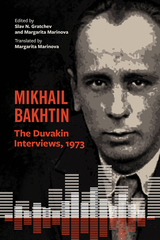 Mikhail Bakhtin: The Duvakin Interviews, 1973
Slav N Gratchev
Bucknell University Press, 2019 Whenever Bakhtin, in his final decade, was queried about writing his memoirs, he shrugged it off. Unlike many of his Symbolist generation, Bakhtin was not fascinated by his own self-image. This reticence to tell his own story was the point of access for Viktor Duvakin, Mayakovsky scholar, fellow academic, and head of an oral history project, who in 1973 taped six interviews with Bakhtin over twelve hours. They remain our primary source of Bakhtin’s personal views: on formative moments in his education and exile, his reaction to the Revolution, his impressions of political, intellectual, and theatrical figures during the first two decades of the twentieth century, and his non-conformist opinions on Russian and Soviet poets and musicians. Bakhtin's passion for poetic language and his insights into music also come as a surprise to readers of his essays on the novel. One remarkable thread running through the conversations is Bakhtin's love of poetry, masses of which he knew by heart in several languages. Mikhail Bakhtin: The Duvakin Interviews, 1973, translated and annotated here from the complete transcript of the tapes, offers a fuller, more flexible image of Bakhtin than we could have imagined beneath his now famous texts.
Published by Bucknell University Press. Distributed worldwide by Rutgers University Press.
 Mikhail Bulgakov: The Early Years
Edythe C. Haber
Harvard University Press, 1998 One of the foremost Russian writers of the Soviet period, Mikhail Bulgakov (1891-1940) has attracted much critical attention. But Edythe Haber is the first to explore in depth his formative years, to probe the roots of his artistic vision. Her study yields a new picture of the novelist and playwright working in tumultuous times, and a fresh understanding of his ultimate masterpiece, The Master and Margarita.
Bulgakov as writer was born out of the chaos of the Russian revolution and civil war. Haber shows how he mines his civil war experience for literary purposes, and how he molds and remolds his protagonist, transforming the tormented intellectual of the earliest fiction into a complex solitary hero. In achieving in his fiction a version of the creative self, an autobiographical hero, Bulgakov redefines such traditional moral categories as courage and honor. Blending biography and literary analysis of motifs, story, and characterization, Haber tracks one writer's answer to the dislocations of revolution, civil war, and early Bolshevism. And from her examination of Bulgakov's satirical writings a vivid panorama emerges of the burgeoning Soviet society. These comic sketches and novellas, blending the fantastic and quotidian, evoke an intellectual's struggle with a hostile new world. In Haber's trenchant and broadly informed analysis we can see how the themes and characters of the early works receive their final permutation--and transcendence--in The Master and Margarita, surely the finest novel produced in Russia since the Revolution.
 Mikhail Kuzmin: A Life in Art
John Malmstad and Nikolay Bogomolov
Harvard University Press, 1999 Mikhail Kuzmin (1872–1936), Russia’s first openly gay writer, stood at the epicenter of the turbulent cultural and social life of Petersburg-Petrograd-Leningrad for over three decades. A poet of the caliber of Aleksandr Blok, Vladimir Mayakovsky, Boris Pasternak, Osip Mandelshtam, and Marina Tsvetaeva (and acknowledged as such by them and other contemporaries), Kuzmin was also a prose writer, playwright, critic, translator, and composer who was associated with every aspect of modernism’s history in Russia, from Symbolism to the Leningrad avant-gardes of the 1920s.
Only now is Kuzmin beginning to emerge from the “official obscurity” imposed by the Soviet regime to assume his place as one of Russia’s greatest poets and one of this century’s most characteristic and colorful creative figures. This biography, the first in any language to be based on full and uncensored access to the writer’s private papers, including his notorious Diary, places Kuzmin in the context of his society and times and contributes to our discovery and appreciation of a fascinating period and of Russia’s long suppressed gay history.
Mikhail Vasil’evich Lomonosov on the Corpuscular Theory
Mikhail Vasil’evich Lomonosov
Harvard University Press, 1970 Soviet historians of science regard the eighteenth-century polymath M. V. Lomonosov as a forerunner of much of modern science and as the founder of Russian science. Although his works have been published extensively in the U.S.S.R., Lomonosov's scientific theories are little known throughout the rest of the world. In this book Henry Leicester presents translations of the papers on chemistry and physics in which Lomonosov developed his atomic (corpuscular) theories. In his Introduction Leicester discusses Lomonosov's life and analyzes his scientific theories, examines the sources of his ideas, and considers the place of his corpuscular theory in the history of science.
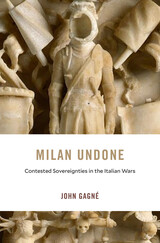 Milan Undone: Contested Sovereignties in the Italian Wars
John Gagné
Harvard University Press, 2020 A new history of how one of the Renaissance’s preeminent cities lost its independence in the Italian Wars.
In 1499, the duchy of Milan had known independence for one hundred years. But the turn of the sixteenth century saw the city battered by the Italian Wars. As the major powers of Europe battled for supremacy, Milan, viewed by contemporaries as the “key to Italy,” found itself wracked by a tug-of-war between French claimants and its ruling Sforza family. In just thirty years, the city endured nine changes of government before falling under three centuries of Habsburg dominion.
John Gagné offers a new history of Milan’s demise as a sovereign state. His focus is not on the successive wars themselves but on the social disruption that resulted. Amid the political whiplash, the structures of not only government but also daily life broke down. The very meanings of time, space, and dynasty—and their importance to political authority—were rewritten. While the feudal relationships that formed the basis of property rights and the rule of law were shattered, refugees spread across the region. Exiles plotted to claw back what they had lost.
Milan Undone is a rich and detailed story of harrowing events, but it is more than that. Gagné asks us to rethink the political legacy of the Renaissance: the cradle of the modern nation-state was also the deathbed of one of its most sophisticated precursors. In its wake came a kind of reversion—not self-rule but chaos and empire.
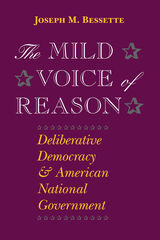 The Mild Voice of Reason: Deliberative Democracy and American National Government
Joseph M. Bessette
University of Chicago Press, 1994 In recent years, many Americans and more than a few political scientists have come to believe that democratic deliberation in Congress—whereby judgments are made on the merits of policies reflecting the interests and desires of American citizens—is more myth than reality. Rather, pressure from special interest groups, legislative bargaining, and the desire of incumbents to be reelected are thought to originate in American legislative politics. While not denying such influences, Joseph M. Bessette argues that the institutional framework created by the founding fathers continues to foster a government that is both democratic and deliberative, at least to some important degree.
Drawing on original research, case studies of policymaking in Congress, and portraits of American lawmakers, Bessette demonstrates not only the limitations of nondeliberative explanations for how laws are made but also the continued vitality of genuine reasoning on the merits of public policy. Bessette discusses the contributions of the executive branch to policy deliberation, and looks at the controversial issue of the proper relationship of public opinion to policymaking.
Informed by Bessette's nine years of public service in city and federal government, The Mild Voice of Reason offers important insights into the real workings of American democracy, articulates a set of standards by which to assess the workings of our governing institutions, and clarifies the forces that promote or inhibit the collective reasoning about common goals so necessary to the success of American democracy.
"No doubt the best-publicized recent book-length work on Congress is columnist George Will's diatribe in praise of term limits in which the core of his complaint is that Congress does not deliberate in its decision-making. Readers who are inclined to share that fantasy would do well to consult the work of Joseph M. Bessette. He turns up massive amounts of material attesting to the centrality of deliberation in congressional life."—Nelson W. Polsby, Presidential Studies Quarterly
Mildred Pierce
Edited by Albert J. La Valley; Tino T. Balio, Series Editor
University of Wisconsin Press, 1980 Joan Crawford forged a new and successful screen image in this powerful women's noir film; winning her an Academy Award for best actress.
Albert J. LaValley's through and insightful guide to Mildred Pierce at once tells us much about the making of this complex film, the problems and process of transferring the story to the screen, the specific and important roles of the producer, director, and set designer, and how the film relates to broad trends within the industry. It is without a doubt the most thorough treatment of this important American motion picture.
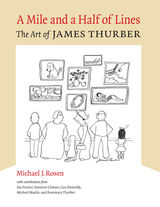 A Mile and a Half of Lines: The Art of James Thurber
Michael J. Rosen, with contributions from Ian Frazier, Seymour Chwast, Liza Donnelly, Michael Maslin, and Rosemary Thurber
Ohio State University Press, 2019 Humorist, cartoonist, writer, playwright. James Thurber was to the twentieth century what Mark Twain was to the nineteenth. At one point, his books were the most read of any American in the world. His work could be found anywhere—from the pages of the New Yorker to the pages of children’s books, from illustrated advertisements to tea towels and dresses. Now, in celebration of the 125th anniversary of Thurber’s birth, A Mile and a Half of Lines: The Art of James Thurber is a long overdue introduction and reintroduction to James Thurber and the artwork that fundamentally changed American cartoons.
Including some 260 drawings, this collection is the first comprehensive focus on his work as an artist, a cartoonist, and an illustrator. With commentary from a host of preeminent cartoonists and writers, including Ian Frazier, Seymour Chwast, and Michael Maslin, A Mile and a Half of Lines celebrates the significance of Thurber’s spontaneous, unstudied, and novel drawing style that not only altered the nature of American cartooning but also expanded the very possibilities of an illustrated line. Coinciding with the first major retrospective of Thurber’s art presented by the Columbus Museum of Art in 2019, A Mile and a Half of Lines showcases both classic Thurber as well as visual material never before seen in print.
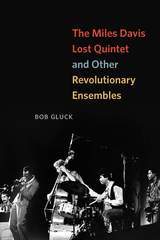 The Miles Davis Lost Quintet and Other Revolutionary Ensembles
Bob Gluck
University of Chicago Press, 2015 Miles Davis’s Bitches Brew is one of the most iconic albums in American music, the preeminent landmark and fertile seedbed of jazz-fusion. Fans have been fortunate in the past few years to gain access to Davis’s live recordings from this time, when he was working with an ensemble that has come to be known as the Lost Quintet. In this book, jazz historian and musician Bob Gluck explores the performances of this revolutionary group—Davis’s first electric band—to illuminate the thinking of one of our rarest geniuses and, by extension, the extraordinary transition in American music that he and his fellow players ushered in.
Gluck listens deeply to the uneasy tension between this group’s driving rhythmic groove and the sonic and structural openness, surprise, and experimentation they were always pushing toward. There he hears—and outlines—a fascinating web of musical interconnection that brings Davis’s funk-inflected sensibilities into conversation with the avant-garde worlds that players like Ornette Coleman and John Coltrane were developing. Going on to analyze the little-known experimental groups Circle and the Revolutionary Ensemble, Gluck traces deep resonances across a commercial gap between the celebrity Miles Davis and his less famous but profoundly innovative peers. The result is a deeply attuned look at a pivotal moment when once-disparate worlds of American music came together in explosively creative combinations.
Miles Gloriosus
Plautus
Harvard University Press, 1997 Miles Gloriosus or “Braggart Warrior” is one of the best-known and liveliest Roman comedies. It shows Plautus at his ablest in ingenious plot construction, vivid characterization, fast-moving action, and humorous dialogue.
This edition of the Latin text is fully and very helpfully annotated. The substantial introduction considers the antecedents of Plautus’s drama in Greek New Comedy and in Italic farce, his mixture of Greek and Roman both in language and in the life portrayed, and his stagecraft, language, and meter.
 Miles of Smiles, Years of Struggle: STORIES OF BLACK PULLMAN PORTERS
Jack Santino
University of Illinois Press, 1989 As service workers in a luxurious sleeping-car train system, Pullman porters had both the highest status in the black community and the lowest rank on the train. They were trapped in the dual roles of charming host and obedient servant, and their constant smiles--even in the face of unreasonable demands by white passengers--were part of the job requirement.
Jack Santino's interviews with retired porters provide extensive firsthand accounts of their work, the job inequities they faced, the formation of the Brotherhood of Sleeping Car Porters, and the aborted Pullman porter strike of 1928. Through the testimony of ran-and-file workers as well as key figures such as E. D. Nixon, the porter who initiated the Montgomery bus boycott and helped launch the career of Martin Luther King, Jr. and C.L. Dellums, the only surviving founding member of the BSCP, Miles of Smiles, Years of Struggle illuminates the Pullman porters' struggle for dignity.
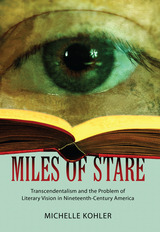 Miles of Stare: Transcendentalism and the Problem of Literary Vision in Nineteenth-Century America
Michelle Kohler
University of Alabama Press, 2014 Miles of Stare explores the problem of nineteenth-century American literary vision: the strange conflation of visible reality and poetic language that emerges repeatedly in the metaphors and literary creations of American transcendentalists.
The strangeness of nineteenth-century poetic vision is exemplified most famously by Emerson’s transparent eyeball. That disembodied, omniscient seer is able to shed its body and transcend sight paradoxically in order to see—not to create—poetic language “manifest” on the American landscape. In Miles of Stare, Michelle Kohler explores the question of why, given American transcendentalism’s anti-empiricism, the movement’s central trope becomes an eye purged of imagination. And why, furthermore, she asks, despite its insistent empiricism, is this notorious eye also so decidedly not an eye? What are the ethics of casting a boldly equivocal metaphor as the source of a national literature amidst a national landscape fraught with slavery, genocide, poverty, and war?
Miles of Stare explores these questions first by tracing the historical emergence of the metaphor of poetic vision as the transcendentalists assimilated European precedents and wrestled with America’s troubling rhetoric of manifest destiny and national identity. These questions are central to the work of many nineteenth-century authors writing in the wake of transcendentalism, and Kohler offers examples from the writings of Douglass, Hawthorne, Dickinson, Howells, and Jewett that form a cascade of new visual metaphors that address the irreconcilable contradictions within the transcendentalist metaphor and pursue their own efforts to produce an American literature. Douglass’s doomed witness to slavery, Hawthorne’s reluctantly omniscient narrator, and Dickinson’s empty “miles of Stare” variously skewer the authority of Emerson’s all-seeing poetic eyeball while attributing new authority to the limitations that mark their own literary gazes.
Tracing this metaphorical conflict across genres from the 1830s through the 1880s, Miles of Stare illuminates the divergent, contentious fates of American literary vision as nineteenth-century writers wrestle with the commanding conflation of vision and language that lies at the center of American transcendentalism—and at the core of American national identity.
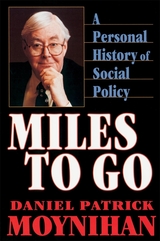 Miles to Go: A Personal History of Social Policy
Daniel Patrick Moynihan
Harvard University Press, 1996 Has liberalism lost its way--or merely its voice? This book by one of the nation's most insightful, articulate, and powerful Democrats at last breaks the silence that has greeted the Republican Party's revolution of 1994. When voters handed Democrats their worst defeat in 100 years, New Yorkers returned Daniel Patrick Moynihan to the Senate for his fourth term. Amid the wreck of his party's control and the disarray of programs and policies he has championed for three decades, Senator Moynihan here takes stock of the politics, economics, and social problems that have brought us to this pass. With a clarity and civility far too rare in the political arena, he offers a wide-ranging meditation on the nation's social strategies for the last 60 years, as well as a vision for the years to come.
Because Senator Moynihan has long been a defender of the policies whose fortunes he follows here, Miles to Go is in a sense autobiographical, an exemplary account of the social life of the body politic. As it guides us through government's attempts to grapple with thorny problems like family disintegration, welfare, health care, deviance, and addiction, Moynihan writes of "The Coming of Age of American Social Policy." Through most of our history American social policy has dealt with issues that first arose in Europe, and essentially followed European models. Now, in a post-industrial society we face issues that first appear in the United States for which we will have to devise our own responses. Ringing with the wisdom of experience, decency, and common sense, Miles to Go asks "why liberalism cannot be taught what conservatives seem to know instinctively"--to heed the political and moral sentiments of the people and reshape itself for the coming age.
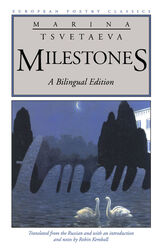 Milestones: A Bilingual Edition
Marina Tsvetaeva, translated from the Russian by Robin Kemball
Northwestern University Press, 2003 Milestones is an apt title for this collection, for the eighty-four poems within show a poet passing from mere talent into mastery of her craft. Composed between January and December of 1916, these poems find the twenty-four year-old Tsvetaeva thirsting for the fullness of life while at the same time contemplating the inevitability of death—a theme she was to revisit many times in her career. Tsvetaeva's work of the time also reflects her knowledge of (and pride in) her native culture, especially the centrality of Moscow as the ultimate destination of all Russians. Throughout the verse she opens up to the sensual wonders of nature—sky, forest, wind, and not least her beloved daughter Alya, who would come to figure greatly in the work and legacy of her mother.
Milestones lays out a sensual feast of moods, themes, styles, and rhythms—all the ingredients that would in time reveal Tsvetaeva as one of the most daring and original poets of her time.
Milestones in the History of English in America, Volume 76
Allen Walker Read, Richard W. Bailey, editor
Duke University Press A collection of essays by one of the premier historians of American English, Milestones in the History of English in America is a remarkable introduction to Allen Walker Read’s work and the ways in which archival materials can illuminate linguistic history. This volume is divided into four sections: the emergence of American English as a distinct form and the attitudes of both Britons and Americans toward its development; the history of the most distinctive and widespread American coinage, "O.K."; euphemism and obscenity; and an autobiographical section that provides a fascinating portrait of a remarkable American scholar.
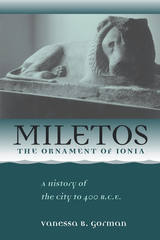 Miletos, the Ornament of Ionia: A History of the City to 400 B.C.E.
Vanessa B. Gorman
University of Michigan Press, 2001 Situated on the southwest coast of modern Turkey, Miletos stood for centuries as one of the paramount cities in the Hellenic world, a gateway between the East and West. It became especially famous as the most prolific mother city in Greek history, sending out at least forty-five known primary and secondary settlements into the Sea of Marmara and the Black Sea, while at home developing into an intellectual and artistic center and one of the birthplaces of Western science and philosophy. A history of Miletos is long overdue. Despite the significance of this city in antiquity and the important results of ongoing excavations there, the last full-scale discussion of Miletos was written in 1915. In Miletos, the Ornament of Ionia, Vanessa B. Gorman provides the first and only modern, integrated history of the city, collecting and scrutinizing sources about Miletos for the period stretching from the first signs of habitation until 400 B.C.E. This book reviews the archaeological evidence for the physical city, demonstrates the likelihood of both Minoan and Mycenaean settlements there, and substantiates the fact of the Persian destruction and refoundation of Miletos along orthogonal lines. With insight and diligence, Gorman surveys the cults known to have existed during this period; traces the political progress of the city through monarchy, oligarchy, tyranny, and democracy; and sketches the terms of its subjugation under the Persians and later the Athenians. Providing a detailed and up-to-date account of the development of one of the major urban centers of Asia Minor, Gorman's book will engage classicists, historians, and Near Eastern specialists. Vanessa B. Gorman is Associate Professor of History, University of Nebraska, Lincoln.
 Militant And Triumphant: William Henry O'Connell and the Catholic Church in Boston, 1859-1944
James M. O'Toole
University of Notre Dame Press, 1992 Description
Militant and Triumphant fills a major gap in the historical record of American Catholicism by presenting a vivid, objective portrait of Cardinal William Henry O'Connell and his significance in the church and his times.
Reviews
"... a lucid biography of one of the least attractive figures in U.S. Catholic history, Boston's Cardinal William Henry O'Connell. While Boston's Catholics have long stated that O'Connell gave them a sense of pride, there was another side to his story and that is the one O'Toole tells so well."
-America
"Anyone who grows misty-eyed with romantic nostalgia over the good old, pre-Vatican II days of the American church is fated to have his/her eyes blink open with surprise on reading this book. Had Edwin O'Connor known but half the story of the good cardinal that this biography reveals, his Last Hurrah would still be required reading as a cautionary tale in every rectory."
-Commonweal
The Militant Hackwriter: French Popular Literature 1800–1848 and Its Influence, Artistic and Political
Lucian W. Minor
University of Wisconsin Press, 1975 While Louis XVIII, Charles X, and Louis Philippe ruled in France, a vast majority of politically unenfranchised Frenchmen were developing their own subculture. Only recently literate, they fashioned their own literature. It consisted of two important genres: the popular novel and the melodrama. As we trace these genres from the turn of the nineteenth century until that moment of February 25, 1848, when the Second Republic was declared, we are also led to a detailed scrutiny of the injustices which the immense majority of the French suffered and of the political causes they espoused. The succession of heroes and villains in their literature mirrored accurately the fears and hopes they felt.
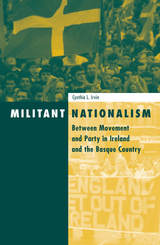 Militant Nationalism: Between Movement and Party in Ireland and the Basque Country
Cynthia Irvin
University of Minnesota Press, 1999 A comparative analysis of two militant nationalist groups. Why do some militant nationalists turn to electoral politics while others resist-and even seek to destroy-that arena? Cynthia L. Irvin examines two cases of electoral interventions by nationalist organizations engaged in violent political competition: in Northern Ireland and in the Basque provinces of Spain. Based on her findings, she offers insights into the circumstances that lead such groups to abandon violence in favor of institutional political struggle. Using fieldwork done in Northern Ireland and the Basque Country, Irvin develops a model linking the internal dynamics of Sinn Fein and Herri Batasuna (the electoral arm of the militant Basque separatists) to changes in their external environments. In this unusual comparative analysis, she draws on interviews with more than 100 Sinn Fein and Herri Batasuna activists and on a unique survey of 140 Herri Batasuna activists. This approach moves Irvin’s work beyond previous analyses, which have relied on either descriptive and historical accounts or formal models of insurgent violence. This detailed account has broad implications for the study of social movements and ethnic identity, providing a valuable new perspective into the strategic interactions and often conflict-ridden relationship between social movements and political parties. ISBN 0-8166-3114-X Cloth £00.00 $49.95xxISBN 0-8166-3115-8 Paper £00.00 $19.95x304 Pages 26 Tables 5 7/8 x 9 MaySocial Movements, Protest, and Contention Series, volume 9Translation inquiries: University of Minnesota Press
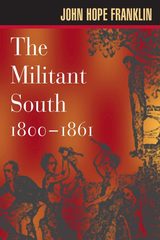 The Militant South, 1800-1861
John Hope Franklin
University of Illinois Press, 2002 In The Militant South, 1800-1861, John Hope Franklin identifies the factors and causes of the South's festering propensity for aggression that contributed to the outbreak of the Civil War in 1861.
Franklin asserts that the South was dominated by militant white men who resorted to violence in the face of social, personal, or political conflict. Fueled by their defense of slavery and a persistent desire to keep the North out of their affairs, Southerners adopted a vicious bellicosity that intensified as war drew nearer.
Drawing from Southern newspapers, government archives, memoirs, letters, and firsthand accounts, Franklin masterfully details the sources and consequences of antebellum aggression in the South. First published in 1956, this classic volume is an enduring and impeccably researched contribution to Southern history. This paperback edition features a new preface in which the author discusses controversial responses to the book.
 Militant Visions: Black Soldiers, Internationalism, and the Transformation of American Cinema
Reich, Elizabeth
Rutgers University Press, 2016 Militant Visions examines how, from the 1940s to the 1970s, the cinematic figure of the black soldier helped change the ways American moviegoers saw black men, for the first time presenting African Americans as vital and integrated members of the nation. In the process, Elizabeth Reich reveals how the image of the proud and powerful African American serviceman was crafted by an unexpected alliance of government propagandists, civil rights activists, and black filmmakers. Contextualizing the figure in a genealogy of black radicalism and internationalism, Reich shows the evolving images of black soldiers to be inherently transnational ones, shaped by the displacements of diaspora, Third World revolutionary philosophy, and a legacy of black artistry and performance.
Offering a nuanced reading of a figure that was simultaneously conservative and radical, Reich considers how the cinematic black soldier lent a human face to ongoing debates about racial integration, black internationalism, and American militarism. Militant Visions thus not only presents a new history of how American cinema represented race, but also demonstrates how film images helped to make history, shaping the progress of the civil rights movement itself.
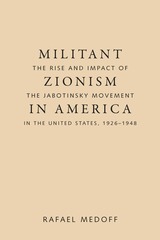 Militant Zionism in America: The Rise and Impact of the Jabotinsky Movement in the United States, 1926-1948
Rafael Medoff
University of Alabama Press, 2006 This in-depth look at a controversial faction of American Zionism fills
a void in the story of American Zionism--and in the story of American Judaism.
This book recounts the fascinating and little-known story
of the militant American Zionists who lobbied Congress, rallied American
public opinion, and influenced British-American relations in their campaign
for Jewish statehood in the 1930s and 1940s. Although these activists have
been dismissed as fanatics who fragmented the American Zionist movement,
Rafael Medoff reveals that the faction--which included an Academy Award-winning
screenwriter and several future members of the Israeli parliament--was
more influential than has been previously acknowledged.
These militants stirred America's conscience by placing
controversial newspaper ads, lobbying conservative as well as liberal members
of Congress, and staging dramatic protest rallies. Through these tactics,
Medoff shows, they attracted a wave of support from an extraordinary cross-section
of leading Americans, including comedians Harpo Marx and Carl Reiner, actors
Vincent Price, Marlon Brando, and Jane Wyatt, musician Leonard Bernstein,
and rising young politicians Jacob Javits and Hubert Humphrey. Medoff also
describes the shadowy underground division that smuggled weapons to the
Holy Land in caskets, naming and interviewing for the first time members
of this gunrunning network.
Based on years of archival research and interviews and
written in a compelling style, Militant Zionism in America documents
events that reshaped the American Jewish community, influenced American
foreign policy, and contributed to one of the most extraordinary events
of modern history: the creation of the State of Israel.
Rafael Medoff is a Visiting Scholar at the State University of New York -- Purchase College.
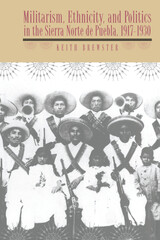 Militarism, Ethnicity, and Politics in the Sierra Norte de Puebla, 1917-1930
Keith Brewster
University of Arizona Press, 2003 In the wake of the Mexican Revolution, citizens in many parts of Mexico experienced turbulent and uncertain times. This book tells the story of how the people of the Sierra Norte de Puebla emerged from those traumatic years and came to terms with the many challenges facing them in the decade that followed. It also examines the phenomenon of caciquismo in the postrevolutionary period as seen in the career of one powerful individual. Gabriel Barrios Cabrera, leader of the Brigada Serrana, rose from rural obscurity in the tiny village of Cuacuila to a position of unprecedented military strength during the Revolution, and throughout the 1920s he and his brother Demetrio came to enjoy the confidence of the nation's presidents. This work provides an in-depth look at how a local political boss held on to power. Keith Brewster reveals how the story of the Sierra is inextricably linked to that of the Barrios Cabrera family, and he investigates the ways in which this interconnection developed. Brewster argues that Barrios owed his long prominence to his sensitivity to the region's culture, but also shows that the extent of his power was exaggerated by both contemporaries and historians. Barrios was able to develop a working relationship with the federal government by endorsing its objectives and convincing them of his own indispensability, but his authority depended on the weakness of the federal government and on infighting within the Puebla state government; once both governments stabilized, Barrios quickly lost his grip on power. Masterfully blending archival sources and oral history, Brewster captures life in the Sierra during the 1920s and examines the decision-making processes that determined how communities responded to new pressures, such as requests for soldiers or support for development projects. He shows that subaltern groups were able to shape and even resist state reforms, mustering evidence that the Sierra's indigenous communities drove hard bargains over issues affecting their everyday lives. Although many communities used Barrios as an intermediary, Brewster reveals that they did not universally accept his legitimacy but simply used his connections to pursue their own local agendas. Brewster depicts the Sierra de Puebla of the 1920s as a scene of shifting balances of power where political, economic, social, and ethnic factors combined to produce the temporary ascendancy of different interest groups beyond and within the region. His study forces us to question assumptions about how power was exercised at the local and regional levels in postrevolutionary Mexico and will be of lasting interest to all concerned with the dynamics of caciquismo and the evolution of the Mexican political system.
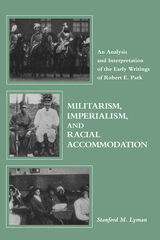 Militarism, Imperialism, and Racial Accommodation: An Analysis and Interpretation of the Early Writings of Robert E. Park
Stanford Lyman
University of Arkansas Press, 1992 1993 Mid-South Sociological Association Book Award
Robert E. Park has long been recognized as one of the most influential thinkers in early American sociology, yet virtually all of his works appearing before 1913 were published in popular magazines and were dismissed as nonsociological muckraking. In Militarism, Imperialism, and Racial Accommodation: An Analysis and Interpretation of the Early Writings of Robert E. Park, Stanford M. Lyman examines and reprints many of these little-known works, including Park’s essays on German military organization, his exposés of the atrocities committed by Belgium’s Leopold II in the Congo State, his studies of the black community in Winston-Salem, North Carolina, and of Booker T. Washington’s agricultural education program at Tuskegee, Alabama. Lyman shows clearly that Park’s essays, written outside the academy, formulated a far more complex perspective on modern modes of evil than any proposed by his contemporaries, thereby influencing sociological debates for decades to come. By writing his essays on topical subjects and by publishing them for a public audience, Park dramatized his profound belief that the struggle to achieve racial accommodation and to establish a true and lasting democracy is a concern for all.
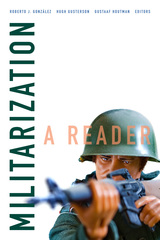 Militarization: A Reader
Roberto J. González, Hugh Gusterson, and Gustaaf Houtman, editors
Duke University Press, 2019 Militarization: A Reader offers a range of critical perspectives on the dynamics of militarization as a social, economic, political, cultural, and environmental phenomenon. It portrays militarism as the condition in which military values and frameworks come to dominate state structures and public culture both in foreign relations and in the domestic sphere. Featuring short, readable essays by anthropologists, historians, political scientists, cultural theorists, and media commentators, the Reader probes militarism's ideologies, including those that valorize warriors, armed conflict, and weaponry. Outlining contemporary militarization processes at work around the world, the Reader offers a wide-ranging examination of a phenomenon that touches the lives of billions of people.
In collaboration with Catherine Besteman, Andrew Bickford, Catherine Lutz, Katherine T. McCaffrey, Austin Miller, David H. Price, David Vine
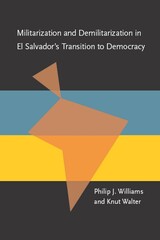 Militarization and Demilitarization in El Salvador’s Transition to Democracy
Philip Williams
University of Pittsburgh Press, 1997
With the resignation of General Renee Emilio Ponce in March 1993, the Salvadorian army’s sixty-year domination of El Salvador came to an end. The country’s January 1992 peace accords stripped the military of the power it once enjoyed, placing many areas under civilian rule. Establishing civilian control during the transition to democracy was no easy task, especially for a country that had never experienced even a brief period of democracy in its history.
Phillip J. Williams and Knut Walter argue that prolonged military rule produced powerful obstacles that limited the possibilities for demilitarization in the wake of the peace accords. The failure of the accords to address several key aspects of the military’s political power had important implications for the democratic transition and for future civil-military relations.
Drawing on an impressive array of primary source materials and interviews, this book will be valuable to students, scholars, and policy makers concerned with civil-military relations, democratic transitions, and the peace process in Central America.
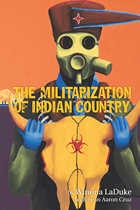 The Militarization of Indian Country
Winona LaDuke
Michigan State University Press, 2013 When it became public that Osama bin Laden’s death was announced with the phrase “Geronimo, EKIA!” many Native people, including Geronimo’s descendants, were insulted to discover that the name of a Native patriot was used as a code name for a world-class terrorist. Geronimo descendant Harlyn Geronimo explained, “Obviously to equate Geronimo with Osama bin Laden is an unpardonable slander of Native America and its most famous leader.” The Militarization of Indian Country illuminates the historical context of these negative stereotypes, the long political and economic relationship between the military and Native America, and the environmental and social consequences. This book addresses the impact that the U.S. military has had on Native peoples, lands, and cultures. From the use of Native names to the outright poisoning of Native peoples for testing, the U.S. military’s exploitation of Indian country is unparalleled and ongoing.
 Militarized Currents: Toward a Decolonized Future in Asia and the Pacific
Setsu Shigematsu
University of Minnesota Press, 2010 Foregrounding indigenous and feminist scholarship, this collection analyzes militarization as an extension of colonialism from the late twentieth to the twenty-first century in Asia and the Pacific. The contributors theorize the effects of militarization across former and current territories of Japan and the United States, such as Guam, Okinawa, the Marshall Islands, the Philippines, and Korea, demonstrating that the relationship between militarization and colonial subordination—and their gendered and racialized processes—shapes and produces bodies of memory, knowledge, and resistance. Contributors: Walden Bello, U of the Philippines; Michael Lujan Bevacqua, U of Guam; Patti Duncan, Oregon State U; Vernadette Vicuña Gonzalez, U of Hawai‘i, M noa; Insook Kwon, Myongji U; Laurel A. Monnig, U of Illinois, Urbana–Champaign; Katharine H. S. Moon, Wellesley College; Jon Kamakawiwo‘ole Osorio, U of Hawai‘i, M noa; Naoki Sakai, Cornell U; Fumika Sato, Hitotsubashi U; Theresa Cenidoza Suarez, California State U, San Marcos; Teresia K. Teaiwa, Victoria U, Wellington; Wesley Iwao Ueunten, San Francisco State U.
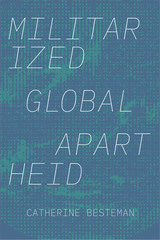 Militarized Global Apartheid
Catherine Besteman
Duke University Press, 2021 In Militarized Global Apartheid Catherine Besteman offers a sweeping theorization of the ways in which countries from the global north are reproducing South Africa's apartheid system on a worldwide scale to control the mobility and labor of people from the global south. Exploring the different manifestations of global apartheid, Besteman traces how militarization and securitization reconfigure older forms of white supremacy and deploy them in new contexts to maintain this racialized global order. Whether using the language of security, military intervention, surveillance technologies, or detention centers and other forms of incarceration, these projects reinforce and consolidate the global north's political and economic interests at the expense of the poor, migrants, refugees, Indigenous populations, and people of color. By drawing out how this new form of apartheid functions and pointing to areas of resistance, Besteman opens up new space to theorize potential sources of liberatory politics.
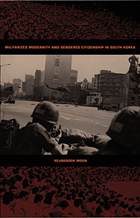 Militarized Modernity and Gendered Citizenship in South Korea
Seungsook Moon
Duke University Press, 2005 This pathbreaking study presents a feminist analysis of the politics of membership in the South Korean nation over the past four decades. Seungsook Moon examines the ambitious effort by which South Korea transformed itself into a modern industrial and militarized nation. She demonstrates that the pursuit of modernity in South Korea involved the construction of the anticommunist national identity and a massive effort to mold the populace into useful, docile members of the state. This process, which she terms “militarized modernity,” treated men and women differently. Men were mobilized for mandatory military service and then, as conscripts, utilized as workers and researchers in the industrializing economy. Women were consigned to lesser factory jobs, and their roles as members of the modern nation were defined largely in terms of biological reproduction and household management. Moon situates militarized modernity in the historical context of colonialism and nationalism in the twentieth century. She follows the course of militarized modernity in South Korea from its development in the early 1960s through its peak in the 1970s and its decline after rule by military dictatorship ceased in 1987. She highlights the crucial role of the Cold War in South Korea’s militarization and the continuities in the disciplinary tactics used by the Japanese colonial rulers and the postcolonial military regimes. Moon reveals how, in the years since 1987, various social movements—particularly the women’s and labor movements—began the still-ongoing process of revitalizing South Korean civil society and forging citizenship as a new form of membership in the democratizing nation.
 Militarizing Marriage: West African Soldiers’ Conjugal Traditions in Modern French Empire
Sarah J. Zimmerman
Ohio University Press, 2020 Following tirailleurs sénégalais’ deployments in West Africa, Congo, Madagascar, North Africa, Syria-Lebanon, Vietnam, and Algeria from the 1880s to 1962, Militarizing Marriage historicizes how African servicemen advanced conjugal strategies with women at home and abroad. Sarah J. Zimmerman examines the evolution of women’s conjugal relationships with West African colonial soldiers to show how the sexuality, gender, and exploitation of women were fundamental to the violent colonial expansion and the everyday operation of colonial rule in modern French Empire. These conjugal behaviors became military marital traditions that normalized the intimate manifestation of colonial power in social reproduction across the empire. Soldiers’ cross-colonial and interracial households formed at the intersection of race and sexuality outside the colonizer/colonized binary. Militarizing Marriage uses contemporary feminist scholarship on militarism and violence to portray how the subjugation of women was indispensable to military conquest and colonial rule.
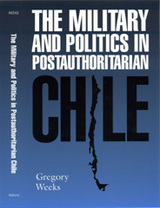 The Military and Politics in Postauthoritarian Chile
Gregory Weeks
University of Alabama Press, 2003 "The Military and Politics in Post-Authoritarian Chile should be read by everyone concerned with the relation between democracy and the armed forces. It is a well-researched, well-written volume that should prove both interesting and useful to scholars and students alike." —Perspectives on Politics Why have political leaders of developing and authoritarian nations run into so many obstacles as they attempt to establish civilian supremacy over armed forces in the democratization of their countries? This is the question Gregory Weeks poses in his study of Chile from 1990 onward. He explains how the Chilean military has maintained a high level of political influence in the tumultuous aftermath of dictatorial rule by Army General Augusto Pinochet, thus confounding a smooth transition to civilian authority.
Even after the reins of power were officially handed over in 1990, Pinochet continued as commander in chief of the army until 1998, when he took a lifetime seat in the Senate and led the military’s efforts to retain its legal and constitutional prerogatives while limiting civilian oversight of military affairs. This assertion of guardianship by the military has produced a political tug-of-war between it and civilian authorities the two contenders for political primacy in Chile. In addition to recounting the historical background of this situation, Weeks’s study examines where conflict between these two contenders has been most productive and accord has been highest. His findings suggest that formal contacts, conducted through formal institutions, have been the most conducive to civil supremacy and, therefore, the consolidation of democracy.
Based on interviews, government documents, military journals, newspapers, and other archival sources, The Military and Politics in Postauthoritarian Chile describes how presidents, military officers, members of Congress, and judges have interacted since the end of the military regime. With implications for conflict resolution studies, this book will be valuable for Chileanists and policymakers and analysts of Latin American regimes, as well as academic libraries, military historians, social scientists, and students and scholars of Latin American history and politics.
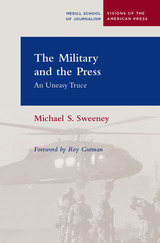 The Military and the Press: An Uneasy Truce
Michael Sweeney
Northwestern University Press, 2006 Because news is a weapon of war--affecting public opinion, troop morale, even strategy--for more than a century America's wartime officials have sought to control or influence the press, most recently by "embedding" reporters within military units in Iraq. This second front, where press freedom and military imperatives often do battle, is the territory explored in The Military and the Press, a history of how press-military relations have evolved during the twentieth and twenty-first century in response to the demands of politics, economics, technology, and legal and social forces.
Author Michael S. Sweeney takes a chronological approach, considering freedoms and restraints such as the First Amendment, court decisions, and government and military directives that have affected the press during World Wars I and II, the Korean War, the Vietnam War, and the more recent conflicts. He explores the ongoing themes of wartime censorship and propaganda, as well as operational security in the battle zone. In chapters addressing the recent shift in military strategy in dealing with the press, Sweeney discusses new forms of control--from embedding journalists and discouraging unaccredited "unilaterals" to developing the news agenda through a barrage of briefings, sound bites, and visuals and appeals to patriotism that border on domestic propaganda. With profiles of a few specific journalists--from Richard Harding Davis covering the Spanish-American War to Christiane Amanpour reporting from the conflicts in Bosnia and Iraq--this deft blend of journalistic history and analysis should serve as a call-to-arms to a public not always well served by a military-press standoff.
 Military Ascendancy and Political Culture: A Study of Indonesia's Golkar
Leo Suryadinata
Ohio University Press, 1989 Most of the earlier studies on the Indonesian political party, Golkar, tend to view the organization solely as an electoral machine used by the military to legitimize its power. However, this study is different in that it considers Golkar less an electoral machine and more as a political organization which inherited the political traditions of the nominal Muslim parties and the Javanese governing elite pre-1965, before the inauguration of Indonesia’s New Order. Golkar, then, is seen in this book as nominal Islam with a military element that tends to differentiate it from previous political parties in the country.
Leo Suryadinata traces the birth, struggle, and emergence of this party so closely identified with Indonesia’s President Suharto. Yet, to claim that Suharto and the military dominate the party is to view Golkar superficially, for the party is also composed of factions of civil servants and the Minister of Security and Defense, as well as several other governmental agencies. A complex and well-detailed cultural history of Indonesia’s most powerful political party, this case study should have wider implications for the study of military behavior in the Third World.
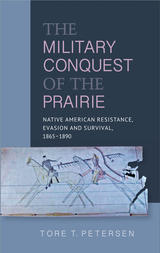 The Military Conquest of the Prairie: Native American Resistance, Evasion and Survival, 1865-1890
Tore T. Petersen
Sussex Academic Press, 2022 The Military Conquest of the Prairie is a study on the final wars on the prairie from the Native American perspective. When the reservation system took hold about one-third of tribes stayed permanently there, one-third during the harsh winter months, and the last third remained on what the government termed unceded territory, which Native Americans had the right to occupy by treaty. For the Federal government it was completely unacceptable that some Indians refused to submit to its authority. Both the Red River war (1874-75) in the south and the great Sioux war (1876-77 ) in the north were the direct result of Federal violation of treaties and agreements. At issue was the one-sided violence against free roaming tribes that were trying to maintain their old way of life, at the heart of which was avoidance on intermingling with white men. Contrary to the expectations of the government, and indeed to most historical accounts, the Native Americans were winning on the battlefields with clear conceptions of strategy and tactics. They only laid down their arms when their reservation was secured on their homeland, thus providing their preferred living space and enabling them to continue their way of life in security. But white man perfidy and governmental double-cross were the order of the day. The Federal government found it intolerable that what it termed 'savages' should be able to determine their own future. Vicious attacks were initiated in order to stamp out tribalism, resulting in driving the US aboriginal population almost to extinction. Analysis of these events is discussed in light of the passing of the Dawes Act in 1887 that provided for breaking up the reservations to the Indian Reorganization Act of 1934 that gave a semblance of justice to Native Americans.
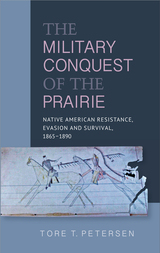 The Military Conquest of the Prairie: Native American Resistance, Evasion and Survival, 1865-1890
Tore T. Petersen
Sussex Academic Press, 2022 The Military Conquest of the Prairie is a study on the final wars on the prairie from the Native American perspective. When the reservation system took hold about one-third of tribes stayed permanently there, one-third during the harsh winter months, and the last third remained on what the government termed unceded territory, which Native Americans had the right to occupy by treaty. For the Federal government it was completely unacceptable that some Indians refused to submit to its authority. Both the Red River war (1874-75) in the south and the great Sioux war (1876-77 ) in the north were the direct result of Federal violation of treaties and agreements. At issue was the one-sided violence against free roaming tribes that were trying to maintain their old way of life, at the heart of which was avoidance on intermingling with white men. Contrary to the expectations of the government, and indeed to most historical accounts, the Native Americans were winning on the battlefields with clear conceptions of strategy and tactics. They only laid down their arms when their reservation was secured on their homeland, thus providing their preferred living space and enabling them to continue their way of life in security. But white man perfidy and governmental double-cross were the order of the day. The Federal government found it intolerable that what it termed 'savages' should be able to determine their own future. Vicious attacks were initiated in order to stamp out tribalism, resulting in driving the US aboriginal population almost to extinction. Analysis of these events is discussed in light of the passing of the Dawes Act in 1887 that provided for breaking up the reservations to the Indian Reorganization Act of 1934 that gave a semblance of justice to Native Americans.
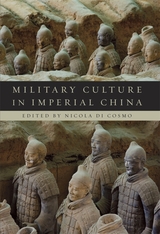 Military Culture in Imperial China
Nicola Di Cosmo
Harvard University Press, 2011 This volume explores the relationship between culture and the military in Chinese society from early China to the Qing empire, with contributions by eminent scholars aiming to reexamine the relationship between military matters and law, government, historiography, art, philosophy, literature, and politics.
The book critically investigates the perception that, due to the influence of Confucianism, Chinese culture has systematically devalued military matters. There was nothing inherently pacifist about the Chinese governments’ views of war, and pragmatic approaches—even aggressive and expansionist projects—often prevailed.
Though it has changed in form, a military elite has existed in China from the beginning of its history, and military service included a large proportion of the population at any given time. Popular literature praised the martial ethos of fighting men. Civil officials attended constantly to military matters on the administrative and financial ends. The seven military classics produced in antiquity continued to be read even into the modern period.
These original essays explore the ways in which intellectual, civilian, and literary elements helped shape the nature of military institutions, theory, and the culture of war. This important contribution bridges two literatures, military and cultural, that seldom appear together in the study of China, and deepens our understanding of war and society in Chinese history.
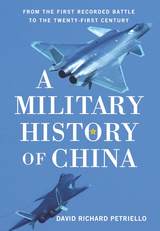 A Military History of China: From the First Recorded Battles to the Twenty-First Century
David Richard Petriello
Westholme Publishing, 2018 A General History of China’s Four Thousand Years of Military Innovation and Expansion
The twenty-first century has been labeled the “Pacific Century,” both in terms of economics as well as military affairs. While South Korea and Japan have stagnated in these aspects, the growth of China since 1980 is unprecedented in modern history. While its economic achievements are both well known and studied, the rapid development of its military is not. In A Military History of China: From the First Recorded Battle to the Twenty-First Century, historian David Richard Petriello provides the first English language account of China’s martial history. China’s military prowess extends across the centuries, and includes the invention or first use of gunpowder, landmines, rocket launchers, armored cavalry, repeating crossbows, multistage rockets, and chemical weapons—in many cases, long before the West.
Illustrated with more than one hundred maps and figures, the book traces the general military history of China from the Neolithic Age to the present day. Particular attention is paid to specific battles, military thinkers, the impact of geography on warfare in China, and the role played by technology. Likewise, the work examines the underlying philosophy of why China goes to war. Because China’s military weakness over the past two centuries compared to the West has given a false sense of China’s potential, a thorough knowledge of the men, battles, tactics, geography, strategies, philosophy, and experiences of war throughout Chinese history are vital to prepare students, scholars, soldiers, and politicians for the return of China as a major innovative and global military power.
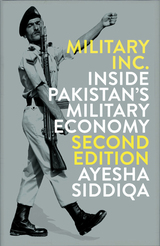 Military, Inc.: Inside Pakistan's Military Economy
Ayesha Siddiqa
Pluto Press, 2016 Pakistan occupies a paradoxical, even contradictory place in American foreign policy. Nominally a strategic ally in the war on terror, it is the third-largest recipient of US aid in the world. At the same time, it is run by its military and intelligence service—whose goals certainly do not always overlap with US priorities.
This book offers a close look at what the rise of the military has meant for Pakistani society. Ayesha Siddiqa shows how entrenched the military has become, not just in day-to-day governance, but in the Pakistani corporate sector as well. What are the consequences of this unprecedented merging of the military and corporate sectors? What does it mean for Pakistan’s economic development—let alone for hopes of an eventual return to democracy and de-militarization? This new edition brings Siddiqa’s account fully up to date with a new preface and conclusion that emphasize the changing role of the media.
The Military Intervenes: Case Studies in Political Development
Henry Bienen
Russell Sage Foundation, 1968 Explores the mechanisms of military intervention and its consequences. The contributors examine a succession of coups, attempted coups, and established military regimes, with a view to evaluate the role of the military as a ruling group and an organization fostering political development. These studies cast strong doubt on the abilities of the military as a modernizing and stabilizing agent, raising important questions about our policies on military assistance and arms sales. Bienen makes an especially strong plea for a reassessment of our military and economic-political policies in order to determine whether both are working toward the same goals.
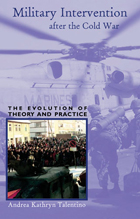 Military Intervention after the Cold War: The Evolution of Theory and Practice
Andrea Kathryn Talentino
Ohio University Press, 2005 For hundreds of years military intervention was considered taboo and prohibited by international law. Since 1992, intervention has often been described as an international responsibility and efforts have been made to give it legal justification. This represents an extraordinary change in perceptions, and one that has taken place in only the space of a decade.
Military Intervention After the Cold War explores how and why this change took place, looking at how both ideas and actions changed in the post-Cold War period to make military intervention a tool of international security and a defining characteristic of the international system. Although it is often touted as a strategy to rebuild collapsed states, the examples of success are few and far between. Andrea Kathryn Talentino argues that standards of human rights and responsible governance have become part of the definition of international security. She addresses questions that are vital in the post-9/11 world, where weak and collapsed states are recognized as permissive and at times supportive environments for criminal actors.
The specter of terrorism has placed even greater emphasis on the need to understand why military intervention happens and how it could be more effective. With the news full of stories on intervention and nation-building, scholars, graduate and undergraduate students, and readers interested in understanding global interdependence will find Military Intervention After the Cold War an indispensable book.Andrea Kathryn Talentino is an assistant professor of international relations at Tulane University, New Orleans.The author of numerous articles on military intervention and post- conflict rebuilding, she is currently focusing on the link between nation-building and political violence.
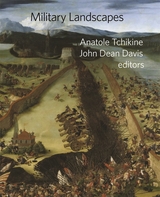 Military Landscapes
Anatole Tchikine
Harvard University Press Among the various human interventions in landscape, war has left one of the most lasting and eloquent records, literally inscribed on the face of the earth. Military landscapes can assume different forms and functions; yet, by controlling vision and movement, they impose shared strategies of seeing upon geography and the environment.
Built around such fundamental concepts as representation, scale, nature, gender, and memory, Military Landscapes seeks to reevaluate the role of militarization as a fundamental factor in human interaction with land. Moving beyond discussions of infrastructure, battlefields, and memorials, it foregrounds the representational role of military landscapes across different historical periods, geographical regions, and territorial scales, covering a wide range of subjects, including the home front and refugee camps. It contributes to scholarship by shifting the focus to often overlooked factors, such as local knowledge, traditional technology, and physical labor, highlighting the historical character of militarized environments as inherently gendered and racialized. By juxtaposing and synthesizing diverse disciplinary perspectives, this volume seeks to develop a more inclusive and nuanced definition of military landscapes under the framework of landscape theory, based on their understanding as a physical reality as well as a cultural construction.
 Military Occupation and Diplomacy: Soviet Troops in Romania, 1944–1958
Sergiu Verona
Duke University Press, 1992 In 1958, after fourteen years of military occupation, Khrushchev—in an unprecedented act—withdrew the Soviet Union’s troops from Romania as part of a political move intended to encourage the withdrawal of Western military forces from Europe. In analyzing this crucial historic episode, Sergiu Verona’s comprehensive study illustrates the dynamics of Soviet military presence in Romania and provides a framework for understanding Soviet security policy, then and now, as well as the interaction between Soviet military objectives and diplomacy.
Drawing on declassified archival material in the United States and the United Kingdom, the author considers Khrushchev’s reversal of Stalinist expansionism by examining the motivation, function, and operation of the initial occupation of Romania; the complex involvement of Soviet diplomacy and its perception by the United States and other Western powers; the process by which Khrushchev decided to withdraw Soviet troops from that country; and the impact of this decision on Soviet policy. Verona extends his analysis, providing comparisons between Khrushchev’s and Gorbachev’s approaches to Eastern Europe, noting that similarities exist not only in domestic policies but in the realm of foreign policy as well.
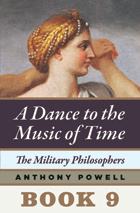 The Military Philosophers: Book 9 of A Dance to the Music of Time
Anthony Powell
University of Chicago Press, 1995 Anthony Powell’s universally acclaimed epic A Dance to the Music of Time offers a matchless panorama of twentieth-century London. Now, for the first time in decades, readers in the United States can read the books of Dance as they were originally published—as twelve individual novels—but with a twenty-first-century twist: they’re available only as e-books. The ninth volume, The Military Philosophers (1968), takes the series through the end of the war. Nick has found a place, reasonably tolerable by army standards, as an assistant liaison with foreign governments in exile. But like the rest of his countrymen, he is weary of life in uniform and looking ahead to peacetime. Until then, however, the fortunes of war continue to be unpredictable: more names are cruelly added to the bill of mortality, while other old friends and foes prosper. Widmerpool becomes dangerously entranced by the beautiful, fascinating, and vicious Pamela Flitton; and Nick’s old flame Jean Duport makes a surprising reappearance. Elegiac and moving, but never without wit and perception, this volume wraps up Powell’s unsurpassed treatment of England’s finest yet most costly hour. "Anthony Powell is the best living English novelist by far. His admirers are addicts, let us face it, held in thrall by a magician."--Chicago Tribune
"A book which creates a world and explores it in depth, which ponders changing relationships and values, which creates brilliantly living and diverse characters and then watches them grow and change in their milieu. . . . Powell's world is as large and as complex as Proust's."--Elizabeth Janeway, New York Times
"One of the most important works of fiction since the Second World War. . . . The novel looked, as it began, something like a comedy of manners; then, for a while, like a tragedy of manners; now like a vastly entertaining, deeply melancholy, yet somehow courageous statement about human experience."--Naomi Bliven, New Yorker “The most brilliant and penetrating novelist we have.”--Kingsley Amis
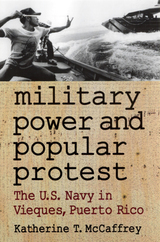 Military Power and Popular Protest: The U.S. Navy in Vieques, Puerto Rico
McCaffrey, Katherine T
Rutgers University Press, 2002 Residents of Vieques, a small island just off the east coast of Puerto Rico, live wedged between an ammunition depot and live bombing range for the U.S. Navy. Since the 1940s when the navy expropriated over two-thirds of the island, residents have struggled to make a life amid the thundering of bombs and rumbling of weaponry fire. Like the armys base in Okinawa, Japan, the facility has drawn vociferous protests from residents who challenged U.S. security interests overseas. In 1999, when a local civilian employee of the base was killed by a stray bomb, Vieques again erupted in protests that have mobilized tens of thousands individuals and transformed this tiny Caribbean Island into the setting for an international cause célèbre. Katherine T. McCaffrey gives a complete analysis of the troubled relationship between the U.S. Navy and island residents. She explores such topics as the history of U.S. naval involvement in Vieques; a grassroots mobilizationled by fishermenthat began in the 1970s; how the navy promised to improve the lives of the island residentsand failed; and the present-day emergence of a revitalized political activism that has effectively challenged naval hegemony. The case of Vieques brings to the fore a major concern within U.S. foreign policy that extends well beyond Puerto Rico: military bases overseas act as lightning rods for anti-American sentiment, thus threatening this countrys image and interests abroad. By analyzing this particular, conflicted relationship, the book also explores important lessons about colonialism and postcolonialism and the relationship of the United States to the countries in which it maintains military bases.
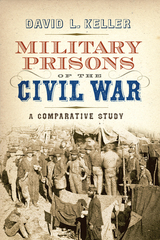 Military Prisons of the Civil War: A Comparative Study
David L. Keller
Westholme Publishing, 2021 A Fresh Analysis of the First Large-Scale Imprisonment of Soldiers in Wartime and Its Failures
Over the course of the American Civil War, more than four hundred thousand prisoners were taken by the North and South combined—the largest number in any conflict up to that time, and nearly fifty-eight thousand of these men died while incarcerated or soon after being released. Neither side expected to take so many prisoners in the wake of battles and neither had any experience on how to deal with such large numbers. Prison camps were quickly established, and as the war progressed, reports of sickness, starvation, mistreatment by guards, and other horrors circulated in the press. After the war, recriminations were leveled on both sides, and much of the immediate ill-will between the North and South dealt with prisoners and their treatment.
In Military Prisons of the Civil War: A Comparative Analysis historic preservationist David L. Keller consulted official records, newspaper reports, first-person accounts from prisoners, and other primary source material in order to understand why imprisonment during the Civil War failed on both sides. His research identifies five factors shared among both Union and Confederate prisons that led to so many deaths, including the lack of a strategic plan on either side for handling prisoners, inadequate plans for holding prisoners for long periods of time, and poor selection and training of camp command and guards.
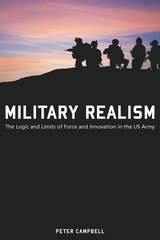 Military Realism: The Logic and Limits of Force and Innovation in the U.S. Army
Peter Campbell
University of Missouri Press, 2024 After the Vietnam War, the U.S. Army considered counterinsurgency (COIN) a mistake to be avoided. Many found it surprising, then, when setbacks in recent conflicts led the same army to adopt a COIN doctrine. Scholarly debates have primarily employed existing theories of military bureaucracy or culture to explain the army’s re-embrace of COIN, but Peter Campbell advances a unique argument centering on military realism to explain the complex evolution of army doctrinal thinking from 1960 to 2008.
In five case studies of U.S. Army doctrine, Campbell pits military realism against bureaucratic and cultural perspectives in three key areas—nuclear versus conventional warfare, preferences for offense versus defense, and COIN missions—and finds that the army has been more doctrinally flexible than those perspectives would predict. He demonstrates that decision makers, while vowing in the wake of Vietnam to avoid (COIN) missions, nonetheless found themselves adapting to the geopolitical realities of fighting “low intensity” conflicts. In essence, he demonstrates that pragmatism has won out over dogmatism. At a time when American policymakers remain similarly conflicted about future defense strategies, Campbell’s work will undoubtedly shape and guide the debate.
 Military Strategy, Joint Operations, and Airpower: An Introduction
Ryan Burke, Michael Fowler, and Kevin McCaskey, Editors
Georgetown University Press, 2018 Military Strategy, Joint Operations, and Airpower will introduce readers to contemporary strategy and the operational level of war, particularly as it relates to airpower. This intermediate textbook was developed as required reading for all US Air Force Academy cadets, and is designed to close the gap between military theory and military practice. It asks readers to reconceive of the military as a “profession of effects” rather than as a profession of arms because much of the military's work and impact no longer involves kinetic warfare. The book covers strategic foundations; operational design and joint-service operations; the air, space, and cyber capabilities that make up modern airpower; and contemporary challenges in the application of strategy. The contributing authors include both military practitioners and scholars of security studies, political science, and history. In addition to being required reading for Air Force Academy cadets, the book will provide an essential overview of strategy and practice for anyone interested in modern airpower and the joint operating environment.
 Military Strategy, Joint Operations, and Airpower: An Introduction, Second Edition
Ryan Burke, Michael Fowler, and Jahara Matisek, Editors
Georgetown University Press, 2022 An essential introduction to contemporary strategy at the operational level of war, now in its second edition Military Strategy, Joint Operations, and Airpower introduces contemporary strategy at the operational level of war, particularly as it relates to airpower. Developed as foundational reading for all US Air Force Academy cadets, Air Force ROTC students, and Officer Training School candidates, this intermediate textbook is designed to close the gap between military theory and practice. It covers strategic foundations; operational design and joint-service operations; the air, space, and cyber capabilities that comprise modern airpower; and contemporary challenges in the application of strategy. In this second edition, each chapter has been updated and revised, and several sections have been expanded. Part 2, “Military Forces and the Joint Fight,” now features separate chapters about each service. Similarly, operational design is expanded from one to four chapters to provide a more thorough step-by-step guide through the process. New chapters in this second edition include “Integrating the Instruments of Power,” “The Spectrum of Conflict and Range of Military Operations,” and “The Nuclear Weapons Triad and Missile Defense.” Military Strategy, Joint Operations, and Airpower’s contributing authors and editors include both military practitioners and scholars of security studies, political science, and history. In addition to being required reading for US Air Force cadets, the book provides an essential overview of strategy and practice for anyone interested in modern airpower.
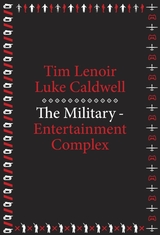 The Military-Entertainment Complex
Tim Lenoir and Luke Caldwell
Harvard University Press, 2018 With the rise of drones and computer-controlled weapons, the line between war and video games continues to blur. In this book, the authors trace how the realities of war are deeply inflected by their representation in popular entertainment. War games and other media, in turn, feature an increasing number of weapons, tactics, and threat scenarios from the War on Terror.
While past analyses have emphasized top-down circulation of pro-military ideologies through government public relations efforts and a cooperative media industry, The Military-Entertainment Complex argues for a nonlinear relationship, defined largely by market and institutional pressures. Tim Lenoir and Luke Caldwell explore the history of the early days of the video game industry, when personnel and expertise flowed from military contractors to game companies; to a middle period when the military drew on the booming game industry to train troops; to a present in which media corporations and the military influence one another cyclically to predict the future of warfare.
In addition to obvious military-entertainment titles like America’s Army, Lenoir and Caldwell investigate the rise of best-selling franchise games such as Call of Duty, Battlefield, Medal of Honor, and Ghost Recon. The narratives and aesthetics of these video games permeate other media, including films and television programs. This commodification and marketing of the future of combat has shaped the public’s imagination of war in the post-9/11 era and naturalized the U.S. Pentagon’s vision of a new way of war.
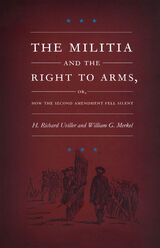 The Militia and the Right to Arms, or, How the Second Amendment Fell Silent
H. Richard Uviller and William G. Merkel
Duke University Press, 2002 "A well regulated Militia, being necessary to the security of a free State, the right of the people to keep and bear Arms, shall not be infringed." —Amendment II, United States Constitution The Second Amendment is regularly invoked by opponents of gun control, but H. Richard Uviller and William G. Merkel argue the amendment has nothing to contribute to debates over private access to firearms. In The Militia and the Right to Arms, or, How the Second Amendment Fell Silent, Uviller and Merkel show how postratification history has sapped the Second Amendment of its meaning. Starting with a detailed examination of the political principles of the founders, the authors build the case that the amendment's second clause (declaring the right to bear arms) depends entirely on the premise set out in the amendment's first clause (stating that a well-regulated militia is necessary to the security of a free state). The authors demonstrate that the militia envisioned by the framers of the Bill of Rights in 1789 has long since disappeared from the American scene, leaving no lineal descendants. The constitutional right to bear arms, Uviller and Merkel conclude, has evaporated along with the universal militia of the eighteenth century.
Using records from the founding era, Uviller and Merkel explain that the Second Amendment was motivated by a deep fear of standing armies. To guard against the debilitating effects of militarism, and against the ultimate danger of a would-be Caesar at the head of a great professional army, the founders sought to guarantee the existence of well-trained, self-armed, locally commanded citizen militia, in which service was compulsory. By its very existence, this militia would obviate the need for a large and dangerous regular army. But as Uviller and Merkel describe the gradual rise of the United States Army and the National Guard over the last two hundred years, they highlight the nation's abandonment of the militia ideal so dear to the framers. The authors discuss issues of constitutional interpretation in light of radically changed social circumstances and contrast their position with the arguments of a diverse group of constitutional scholars including Sanford Levinson, Carl Bogus, William Van Alstyne, and Akhil Reed Amar. Espousing a centrist position in the polarized arena of Second Amendment interpretation, this book will appeal to those wanting to know more about the amendment's relevance to the issue of gun control, as well as to those interested in the constitutional and political context of America's military history.
 Milk and Filth
Carmen Giménez Smith
University of Arizona Press, 2013 National Book Critics Circle Award Finalist
Adding to the Latina tradition, Carmen Giménez Smith, politically aware and feminist-oriented, focuses on general cultural references rather than a sentimental personal narrative. She speaks of sexual politics and family in a fierce, determined tone voracious in its opinions about freedom and responsibility.
The author engages in mythology and art history, musically wooing the reader with texture and voice. As she references such disparate cultural figures as filmmaker Lars Von Trier, Annie from the film Annie Get Your Gun, Nabokov’s Lolita, Facebook entries and Greek gods, they appear as part of the poet’s cultural critique.
Phrases such as “the caustic domain of urchins” and “the gelatin shiver of tea’s surface” take the poems from lyrical images to comic humor to angry, intense commentary. On writing about “downgrading into human,” she says, “Then what? Amorality, osteoporosis and not even a marble estuary for the ages.”
Giménez Smith’s poetic arsenal includes rapier-sharp wordplay mixed with humor, at times self-deprecating, at others an ironic comment on the postmodern world, all interwoven with imaginative language of unexpected force and surreal beauty. Revealing a long view of gender issues and civil rights, the author presents a clever, comic perspective. Her poems take the reader to unusual places as she uses rhythm, images, and emotion to reveal the narrator’s personality. Deftly blending a variety of tones and styles, Giménez Smith’s poems offer a daring and evocative look at deep cultural issues.
Milk Black Carbon
Joan Naviyuk Kane
University of Pittsburgh Press, 2017 Milk Black Carbon works against the narratives of dispossession and survival that mark the contemporary experience of many indigenous people, and Inuit in particular. In this collection, autobiographical details – motherhood, marriage, extended family and its geographical context in the rapidly changing arctic – negotiate arbitrary landscapes of our perplexing frontiers through fragmentation and interpretation of conventional lyric expectations.
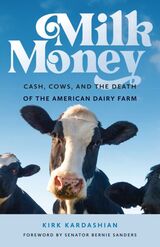 Milk Money: Cash, Cows, and the Death of the American Dairy Farm
Kirk Kardashian
Brandeis University Press, 2025 A gripping and witty exploration of the economic forces that make it challenging for small dairy farms to survive.
The dairy business is at the heart of the culture and economy of Vermont, just as it is in many other states. That fact meant little to Kirk Kardashian until he started taking his daughter to daycare at a dairy farm a few miles from his Vermont home. The farm had been owned by the same family for generations but struggled to make ends meet in a market where retail milk prices have held steady for decades while the prices paid to farmers have plummeted. Suddenly, the abstractions of economics and commodities markets were replaced by the flesh and blood of a farm family whom he greeted every day.
In the tradition of Michael Pollan and Eric Schlosser, Kardashian asks whether it is right that family farmers in America should toil so hard, produce a food so wholesome and so popular, and still lose money. His investigation uncovers the hidden forces behind dairy farm consolidation and explains why milk—a staple subject to both government oversight and industry collusion—has proven so tricky to stabilize, even as scores of small dairy farms close. This new edition brings the story up to date, as farmers grapple with an ever-changing landscape that includes shifting consumer preferences, immigration issues, climate change, and bird flu.
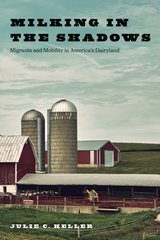 Milking in the Shadows: Migrants and Mobility in America’s Dairyland
Keller, Julie C
Rutgers University Press, 2019 Migrant workers live in a transnational world that spans the boundaries of nation-states. Yet for undocumented workers, this world is complicated by inflexible immigration policies and the ever-present threat of enforcement. Workers labeled as “illegals” wrestle with restrictive immigration policies, evading border patrol and local police as they risk their lives to achieve economic stability for their families. For this group of workers, whose lives in the U.S. are largely defined by their tenuous legal status, the sacrifices they make to get ahead entail long periods of waiting, extended separation from family, and above all, tremendous uncertainty around a freedom that many of us take for granted—everyday mobility. In Milking in the Shadows, Julie Keller takes an in-depth look at a population of undocumented migrants working in the American dairy industry to understand the components of this labor system. This book offers a framework for understanding the disjuncture between the labor desired by employers and life as an undocumented worker in America today.
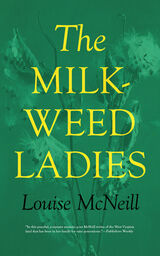 The Milkweed Ladies
LOUISE MCNEILL
University of Pittsburgh Press, 1988
The Milkweed Ladies is written out of deep affection for and intimate knowledge of the lives of rural people and the rhythms of the natural world. It is a personal account of the farm in southern West Virginia where poet Louise McNeill’s family has lived for nine generations.
The Milkweed Ladies is filled with memorable characters—an herb-gathering granny, McNeill’s sailor father, her patient, flower-loving mother, and Aunt Malindy in her “black sateen dress” who “never did a lick of work.” McNeill writes movingly of the harsh routines of the lives of her family, from spring plowing to winter sugaring, and of the hold the farm itself has on them and the earth itself on all of us. McNeill juxtaposes the life of the farm with the larger world events that impinge on it, such as the destruction from lumber companies in the 1930s and World War II in the ’40s.
With her poet’s gift for detail and language, McNeill creates a particular world forgotten by many of us, and to some of us, never known.
The Milky Way: Fifth Edition
Bart J. Bok and Priscilla F. Bok
Harvard University Press, 1981 A swirling spiral of 100 billion star-suns, star clusters, nebulae, and cosmic dust, the Milky Way is our home galaxy and, for astronomers, a source of endless fascination. Since 1941 The Milky Way has conveyed Bart and Priscilla Bok’s own fascination with our galaxy in an authoritative yet easily understandable account. For two generations this immensely popular book has been the standard introduction to the Milky Way, but once again, scientific advances have demanded a complete revision and thorough updating. In just the last decade an entirely new model of a much more massive Milky Way has emerged, and new techniques of radio and infrared astronomy have opened up the full study of the galactic center. As in earlier editions, presentation of new research and dynamic new theoretical advances will delight amateur and professional stargazers alike.
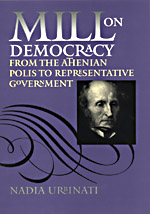 Mill on Democracy: From the Athenian Polis to Representative Government
Nadia Urbinati
University of Chicago Press, 2002 Despite John Stuart Mill's widely respected contributions to philosophy and political economy, his work on political philosophy has received a much more mixed response. Some critics have even charged that Mill's liberalism was part of a political project to restrain, rather than foster, democracy.
Redirecting attention to Mill as a political thinker, Nadia Urbinati argues that this claim misrepresents Mill's thinking. Although he did not elaborate a theory of democracy, Mill did devise new avenues of democratic participation in government that could absorb the transformation of politics engendered by the institution of representation. More generally, Urbinati assesses Mill's contribution to modern democratic theory by critiquing the dominant "two liberties" narrative that has shaped Mill scholarship over the last several decades. As Urbinati shows, neither Isaiah Berlin's theory of negative and positive freedom nor Quentin Skinner's theory of liberty as freedom from domination adequately captures Mill's notion of political theory.
Drawing on Mill's often overlooked writings on ancient Greece, Urbinati shows that Mill saw the ideal representative government as a "polis of the moderns," a metamorphosis of the unique features of the Athenian polis: the deliberative character of its institutions and politics; the Socratic ethos; and the cooperative implications of political agonism and dissent. The ancient Greeks, Urbinati shows, and Athenians in particular, are the key to understanding Mill's contribution to modern democratic theory and the theory of political liberty.
Urbinati concludes by demonstrating the importance of Mill's deliberative model of politics to the contemporary debate on liberal and republican views of liberty. Her fresh and persuasive approach not only clarifies Mill's political ideas but also illustrates how they can help enrich our contemporary understanding of democracy.
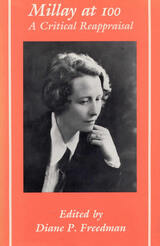 Millay At 100: A Critical Reappraisal
Diane F. Freedman
Southern Illinois University Press, 1995
In this newest addition to Sandra M. Gilbert’ s Ad Feminam: Women and Literature series, Diane P. Freedman brings together twelve essays by critics of poetry and women’ s writing for a critical reappraisal of the prolific work of Edna St. Vincent Millay.
Though finding its occasion in the life of Millay— the centennial of the writer’ s birth— this volume refocuses attention on Millay’ s art by asking questions central to our present concerns: What in the varied body of Millay’ s work speaks to us most forcefully today? Which critical perspectives most illuminate her texts? How might those approaches be challenged, extended, or reoriented? In seeking the answers to such questions, the volume’ s contributors illuminate the means by which Millay’ s early success has been slighted and misunderstood and examine issues of personality, personae, critical stature, and formal experimentation in Millay’ s various genres: lyric poetry, the sonnet, verse drama, fiction, and the personal letter.
In 1920, following the publication of A Few Figs from Thistles, Millay was the "It girl" of American poetry. But by the late 1930s, her popularity waned as her critical reputation declined under the reign of high modernism and its critics. In fact, Millay, like others of her generation, had rejected modernist elitism in favor of public engagement, using her powerful public voice to plead for an end to the Sacco-Vanzetti trials as well as for U.S. entry into World War II. Condemned for both her politicizing and her political poetry, she was the first to admit that she and her poetry suffered in the service of public causes.
Grouped into four parts, these essays focus on Millay’ s relation to modernism, her revisionary perspectives on love, her treatment of time and of the female body, and her use of masquerade and impersonation in life and in art. Throughout, the essayists pose such questions as: Where is Millay’ s place in the literary histories of modern writing and in our hearts? How are we to value, interpret, and characterize the various forms and genres in which she wrote? What is the cultural work Millay achieves and reflects? How does she help us redefine modernism? What do Millay’ s great gifts enable us to see about genre, the social construction of gender, the definition of modernism, and the role of the poet?
Millay’ s considerable productivity, the range and virtues of her forms, and her experimentation clearly argue for a wide-ranging reappraisal of her work.
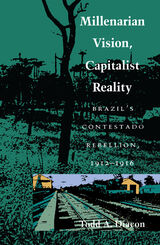 Millenarian Vision, Capitalist Reality: Brazil’s Contestado Rebellion, 1912–1916
Todd A. Diacon
Duke University Press, 1991 Why did a millenarian movement erupt in the Brazilian interior in 1912? Setting out to answer this deceptively simple question, Todd A. Diacon delivers a fascinating account of a culture in crisis.
Combining oral history with detailed archival research, Millenarian Vision, Capitalist Reality depicts a peasant community whose security in economic, social, and religious relations was suddenly disrupted by the intrusion of international capital. Diacon shows how a “deadly triumvirate” comprised to foreign capital, state power, and local bosses engineered a land tenure revolution that threatened smallholders’ subsistence, sparking rebellion among the Contestado peasants.
Unlike most analysis of millenarian movements, Diacon combines a material analysis with a careful exploration of the movement’s millenarian ideology to demonstrate how a particular combination of external and internal forces produced a crisis of values in the Contestado society. Such a crisis, Diacon concludes, gave a special power to the millenarian vision that promised not only outward reform, but inner salvation as well. This work offers a significant contribution to the literature of millenarian movements, popular religion, peasant rebellions, and the transition to capitalism in Brazil.
|
|
